

28 Top Europe Packing List Items for 2024 + What to Wear & NOT to Bring

From London to Lisbon and Istanbul to Iceland, Europe is extremely varied. It’s important to know what to pack because in a single trip, you may find yourself trekking up the snowy Swiss Alps, sunbathing on the Mediterranean coastline, then trudging through the rainy cobblestone streets of Paris. Even destinations only a short flight away can feel on opposite ends of the Earth.
Asher and I have been to Europe 9 times and used our extensive experience to compile this list of items that we feel are useful on any European trip. I’ll also cover what to wear in Europe , what items NOT to bring, and some important FAQs. Bon voyage!

What to Pack for Europe – 28 Essentials
1. neck wallet.
Europe is notorious for its pickpockets, especially in cities like Paris, Rome, London, Barcelona, Amsterdam, and Dublin. An RFID-blocking neck wallet allows you to easily conceal your cash, credit cards, phone, eyeglasses, and hotel keys while not screaming, “I’m a tourist!” How? The neck wallet can comfortably hide under your blouse, t-shirt or jacket, making it next to impossible for pickpockets to reach. This particular brand is extremely well-made and affordably priced.

View on Amazon.com ➜
2. Lipstick-Sized Portable Charger
Getting lost in Paris at night with a phone that just ran out of batteries was a pretty frightening experience, and not one I’d like to repeat. That’s why I always carry this tiny lipstick-sized portable charger in my purse or neck wallet. It’s super reliable and ensures I will never be without a way to look at a map, call an Uber, or to communicate with my family or friends when I’m in a pinch.

3. Virtual Private Network (VPN)
A high number of websites (or parts of websites) get blocked in many European countries. For example, often, music videos and movies on YouTube or Netflix won’t be viewable. A good VPN like NordVPN will make it possible to visit every website without censorship.
Perhaps more importantly though, is the security that a VPN gives you. According to an IT Governance report , there were over 110K breaches in Europe during the month of November 2023 alone! We learned this the hard way in Paris where we had our credit card number stolen after using what we thought was a secure Wi-Fi network at an Airbnb rental. Whenever you go on someone else’s Wi-Fi, whether it’s at a café, airport, Airbnb, or hotel – you’re potentially putting your passwords, credit cards, and identity at risk of being hacked. With a VPN, you protect your sensitive data on any device with just 1-click. And it’s super affordable!

View NordVPN.com Options ➜
4. Universal Power Adapter
European plugs and outlets are about as varied as their terrain. The most common outlets in Europe include Type C, E, F, and G. To ensure you don’t get stuck in a country without a reliable way to charge your phone or laptop, I recommend bringing a universal power adapter that will work in all European countries (except for Italy ). This one pictured comes with two USB ports, a built-in fuse to protect your devices in case of a power surge, and a lifetime replacement guarantee .
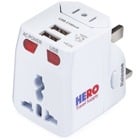
5. Natural Jet Lag Relief Pills
Jet lag is rough when flying to Europe, so I was completely overjoyed when a friend told me about NO JET LAG. Not only is it 100% natural , but it has literally zero negative side effects. The groggy, fuzzy, heavy, exhausted feeling lifts faster and allows me to get on the move upon arrival.
Pro Tip: If you find yourself anxious or jittery during flights, another solid way to stay relaxed is with this Jet Lag Relief Essential Oil . It’s mild, soothing, and combats frazzled nerves. Put a few drops on the outside of your sleep mask and feel your body start to settle down.
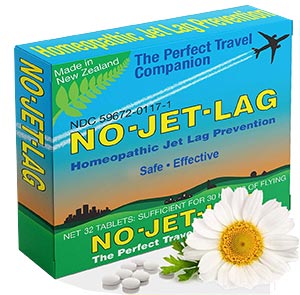
6. Travel Insurance for Europe
Insurance is mandatory for parts of Europe and we never leave the country without it. Europe is not a cheap place to foot a hospital bill (especially when paying out-of-pocket), and accidents happen when we least expect them. Since your domestic provider typically does not follow you overseas, we recommend protecting your travel investment against situations like cancellations, delays, theft, baggage loss, medical transport, and international hospital expenses. We had a friend break her arm hiking in Europe. Luckily, she didn’t have to pay the $35K airlift or $8K in medical bills because she had insured her trip for peace of mind and it really paid off.
Our go-to provider is Faye because they are evolving the entire insurance industry! Instead of having you fill out piles of tedious paperwork, jump through hoops, and cross your fingers to get a reimbursement – Faye handles everything on their mobile app. They wired us the funds when we needed it most instead of hanging us out to dry. Plus, in case something comes up, they can even cover you for “trip cancellation for ANY reason.”
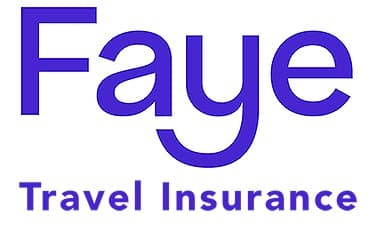
Get a quote in less than 60 seconds with Faye ➜
7. Quick-Dry Travel Towel
Having your own travel towel in an unfamiliar hotel or B&B can be a lifesaver. These microfiber towels weigh less than half a pound and are ultra-packable. You will find yourself using them to dry off after showering or swimming, as a picnic blanket, a beach towel, or to face whatever moisture you come up against ! They dry 10x faster than cotton and without a doubt, are perfect for day trips and general travel alike.
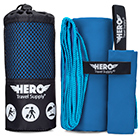
8. Packable "Just In Case" Bag
This bag is genius because it takes up literally no space. Collapsed, the “Just in Case” bag is about the size of a folded tank top — but when full, it’s a large personal item bag that fits under your airplane seat. It also attaches to the handle of your carry-on luggage for smooth airport transit. Throw it in your larger suitcase at the start of the trip – it’ll come in handy for all the souvenirs (and chocolate!) you will inevitably pick up along the way.
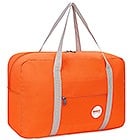
9. Windproof Travel Umbrella
In order to be able to enjoy yourself even in the midst of rainy days, you need a good quality travel umbrella like the one pictured. I prefer bringing this puppy along instead of buying an overpriced one from a side street vendor that is sure to break. This one is windproof and super compact at only 12-inches when collapsed. It also comes with a lifetime replacement guarantee !
Pro Tip: If you’re heading to an extremely rainy climate like Ireland or Iceland and want to be sure to stay dry even in unpredictable storms, throw these disposable ponchos in your daypack and wear them under your umbrella. Here are our favorites for adults and children .
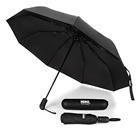
10. Hanging Toiletry Bag
European “water closets (W.C.)” and bathrooms are considerably smaller than the ones you’re probably used to in the U.S. — and full of charming quirks! This said, you might find your B&B in Prague or a tiny hotel in Rome won’t have ample bathroom countertop space for your makeup and skincare routine.
I like to bring this ingenious hanging toiletry bag that easily hangs on any door or wall to ensure I always have as much space as I need to stay happy, sane, and organized. This one boasts 3 external pockets and 4 large internal pockets so that you can fit everything you’d need for a multi-week trip across Europe. I leave it packed with my smaller travel products so I can just grab it and GO when adventure calls. It’s a brilliant find and you’ll never want to leave home without it!

11. TSA-Approved Silicone Travel Bottles
Try these cute travel-sized bottles that will give you the perfect amount for a normal length trip abroad. They are TSA-approved so you won’t have to throw away any part of your precious regimen and all bottles will fit easily in the hanging toiletry bag (or keep them in their own case). It’s always more challenging to find the products that you might love at home while overseas, so if you have skincare and haircare products that you like, it’s best to bring them along.

12. Europe eSIM Data Service (Avoid Roaming Fees!)
We used to purchase a physical SIM card for every trip and location, but this is an antiquated solution to a modern problem. Some airport and street vendors will sell you a janky card that won’t even work, and collecting plastic is a hassle that can be remedied by a 100% digital approach.
Saily offers a worldwide eSIM service that offers data wherever you may roam! They are setting a new standard for international internet use – some of our favorite perks are customizable data options based on your specific trip, lower roaming rates, fewer cybersecurity risks, and less waste. Not to mention, you can easily switch carriers by scanning a QR code from your phone, which is perfect if you plan to gallivant around Europe or change locations a few times.

Pick a data plan at Saily.com ➜
13. Luggage Straps
As a fairly underrated travel accessory, luggage straps are a must-have item for any traveler. They will ensure you don’t fall victim to the nightmare of having your suitcase bust open during transit, leaving all of your dirty laundry on display because of a faulty zipper or lock.
These heavy-duty straps can withstand more than 700 lbs of force-tension and will extend the life of your luggage since your bags won’t have to work as hard to hold all of your European souvenirs together! My favorite perk is that it’s way easier to spot your suitcase in a crowd of conventional bags – between the bright colors and built-in ID card, your cases will be easier to identify as you hop between airports, train stations, ports, and buses (where often, thousands of bags are all thrown together or consolidated). These belts are TSA-approved and offer real peace of mind as you repeatedly hand over your items on an international journey.

14. Discounted Tickets on European Attractions
Whether you are climbing the famous Eiffel Tower , trekking the Acropolis of Athens , standing in awe of the Roman Colosseum , or witnessing Barcelona’s Sagrada Familia – Europe has a plethora of history and magic to offer you. Where else can you swim in a geothermal spa , explore medieval castles , or stare into the eyes of Da Vinci‘s beloved Mona Lisa ?
Get Your Guide is our favorite booking service for top-tier excursions that really bring your trip to life. Building a dream itinerary is easy since you can compare reviews to ensure you’re reserving the best activities. GYG even offers cancelation up to 24-hours before your tours, making it a flexible option for all adventurers.

See all European attractions at GetYourGuide.com ➜
15. Packing Cubes
Europe has so many climates (cool, desert, alpine tundra, highland, and Mediterranean) . Prepare for any scenario with these packing cubes that are a total game-changer! You can easily categorize your suitcase for a stress-free traveling experience (use one cube for tops, one for bottoms, one for dresses, swimsuits, etc.) Gone are the days of digging through your luggage to find that long-lost sock . We also love the two bonus laundry bags that keep your dirty clothes from intermingling with your clean ones.
It’s available on HeroTravelSupply.com with an exclusive 15% discount using the coupon code “ HERO ”.

Or view on Amazon.com ➜
16. Cooling Towel
Does anyone else get a bit crabby when they get hot? (Hands please!) This cooling towel is great for the entire family because I think we all hate memories of near melt-downs in 90-degree weather. All those potentially disastrous moments — waiting in line to see Big Ben with crying little ones with no shade in sight… or walking to get the Barcelona Metro mid-August in a humidity-induced daze have since faded away merely because I discovered this remarkable little towel! It’s non-toxic, chemical-free and once you wet the material, the ice-cold cooling effect lasts for 30-60 minutes before you simply wet it again to restart the process.
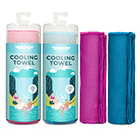
17. Motion Sickness Patches
For those that suffer from motion sickness, these Anti-Nausea Motion Sickness Patches are amazing for planes, trains, and automobiles! Winding European roads can be especially curvy with lots of bends and turns, many of them carved into the sides of vertigo-inducing mountains. These patches are a miraculous herbal remedy that saved me on many occasions – trust me, they work. Don’t call in seasick or carsick to your vacation, use these instead.
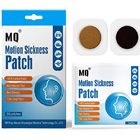
18. Luggage Locks
These TSA-approved luggage locks will protect your valuables from getting stolen while your luggage is in transit. I also like to use one on my backpack while exploring crowded cities to keep pickpockets’ hands out of my stuff and they’re perfect for locking lockers in hostels or tourist sites. I seriously never travel without at least one or two combination locks, it truly helps with my peace of mind.
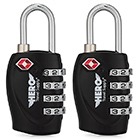
19. Travel Daypack
If you’re planning any day trips, a good foldable daypack should be at the top of your packing list. This Venture Pal backpack is the perfect blend of features, quality and affordability. We’ve found it to be comfortable, durable, and has numerous little compartments for all our needs. It’s also super lightweight and folds into itself so that you can store it easily when you’re not using it. Available in many colors.
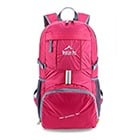
20. Wellies (AKA Rain Boots)
Wellies are essential footwear for Europe since many hot spots are rainy year-round (London, Paris, Zurich, Milan, etc.) But even sunny destinations have a wet season. These rain boots are made to withstand the elements, keeping your feet dry in surprise downpours and combating any muddy terrains with non-slip traction. Add waterproof shoe bags to your suitcase to ensure you don’t get any dirt, mud, or street funk on your clean clothes!
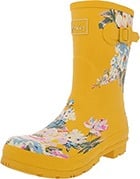
21. Water Bottle with Built-in Filter
Water quality is tough to predict in many parts of Europe – some places have delicious, drinkable tap water. Others have little to no drinkable water available without buying expensive pre-bottled water that is bad for the environment. I always recommend that travelers bring their own water bottles with a filter, to ensure that their water is comfortable to drink. This water bottle has a built-in filter so all you have to do is fill and drink.

22. Gorgeous Outfit
Europe’s restaurant scene is killer , and there are endless opportunities to enjoy the nightlife. Even if I’m planning a fun family trip, I always pack at least one or two outfits that I would feel beautiful wearing in the evenings. It’s not always easy for me to find clothes on Amazon that I like, but I LOVE this jumpsuit because it’s easy to pack, doesn’t wrinkle if it’s tossed into my bag, and looks great on so many body types.
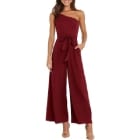
23. Women’s Comfy Flats
Many say that Europe is best enjoyed on foot. From museums to cafés to just taking in the architecture, you will be walking A LOT. Summer months can be hot with high chances of humidity and rain. You’ll want something breathable and comfortable, especially if they get wet in a sudden downpour. These Crocs (yes, Crocs?!) are actually super cute cozy and cool on muggy days. They are my feet’s most-loved flat choice.
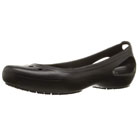
24. Activated Charcoal (Food Poisoning Fix)
Europe boasts countless adorable restaurants and cafés, but… many won’t be as clean as the places you frequent at home and food poisoning happens. The most surprising was when I actually got SO sick from a $250 Michelin-rated meal in London. (Ok, I did eat roast pigeon, but I thought while in London, why not try some of the local fare!) Please don’t ruin your trip by not bringing these along. They will shorten the duration of the food-borne illness dramatically and in many cases, can alleviate the problem immediately.

25. Cheers Hangover Relief
These supplements use vitamins and liver-detoxing herbs like milk thistle to remove alcohol from the body more quickly. Asher and I aren’t big drinkers, but the wine in Europe is divine. When making the most out of pub tours, vineyard stops, and gourmet dining – keep your body in tip-top shape with these hangover-prevention pills. You don’t want to spend long days in museums or on historical tours with a looming headache and fatigue. If you’re planning to drink, give them a try!
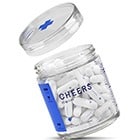
26. Deodorant Wipes
Europe in the Summer is a hot and muggy wonderland. While you’re immersed in the historical beauty all around you, you do NOT want to worry about dripping through your couture. I personally hate reapplying deodorant to my already sweaty armpits, and I will no longer succumb to washing my face and underarms in a sink that has no paper towels to dry myself. These non-toxic, natural wipes do the trick! They fit nicely in my purse or day pack, and with a quick wipe, I’m as fresh as a daisy!
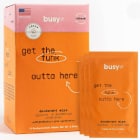
27. Rolling Suitcase
Choosing a good suitcase is like choosing a good partner – both will need to be durable, reliable, secure, and ready to come on many adventures with you (and look good while doing it!) The apple of my eye is this Wrangler Rolling Suitcase . It is massive and really exceeded my expectations. Made of 100% nylon, it has the lightness of a duffle bag but the sturdiness of a regular suitcase. It will be a breeze to maneuver through crowded airports and cobblestone streets (or hauling up typical 5-story buildings with no elevator; you will thank us). Arrive at your hotel in utter comfort, at an even more comfortable price!

28. Reusable Wine Bags (Leak-Proof)
Since these prevent bottle breakages in transit, these reusable leak-proof bags are great for drinkers and non-drinkers alike. I use them for souvenirs and family gifts like French perfume bottles, Italian olive oils, delicate ceramics, literally anything made of glass ! With thick bubble padding and a double seal, you can get a ton of use out of them. And of course, between the Chianti, Bordeaux, Champagne, Cava, and any other European spirit you stumble upon – these will be a thoughtful addition to your checked luggage.
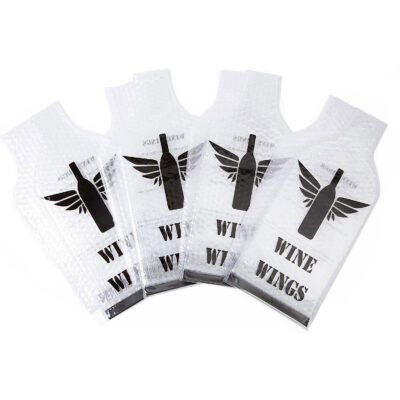
1. Travel Stroller or Double travel stroller
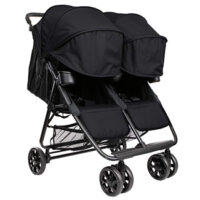
Pro Tip: If you have older children (ages 5+) consider bringing along a double-seated stroller. You’ll be walking miles and miles in Europe and kids get tired easily. Give their little legs a rest and your sleepy tots will probably take a nap on the ride home.
View on Amazon.com ➜
2. Travel Car Seat and Stroller Combo for Infants
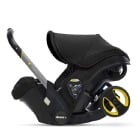
Note: All airlines will check your car seat at the ticket counter free of charge. View on Amazon.com ➜
3. Travel Carseat for Toddlers and Little Kiddos
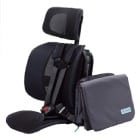
Pro Tip: A Car Seat Luggage Belt is an ultra-portable travel solution to work with what you already have. The strap allows you to attach your car seat to your suitcase. So in a matter of seconds, you have an effortless mode of getting your kids from airport to airport without having to push a heavy stroller around (plus all carry-on luggage). Works like a charm!
4. Stroller Clips
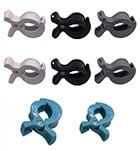
5. Woolino Sleep Sack
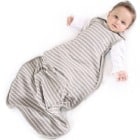
It’s a great way to keep babies cozy on an airplane and ensure they feel safe during long travel days. It’s also helpful for unpredictable temperatures in hotels. It’s a bit expensive but also worth it since it replaces loose blankets you would otherwise need in the crib. We don’t have to travel with many blankets, which also keeps our luggage weight down.
6. Baby Bjorn Travel Crib
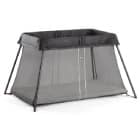
Pro Tip: Before you travel, have your tot take a few naps using this travel crib and create a consistent routine around it. Your babies will come to perceive it as a place of solace. This at-home practice will be invaluable to them connecting with it in new and unfamiliar settings.
7. Homeopathic First Aid Kit
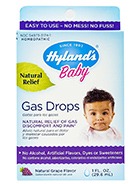
We try to opt for the homeopathic approach to medicine because it is a natural and often botanical way to treat the underlying cause of conditions – aiming to get you off the medicine sooner rather than becoming reliant upon it. We love that these natural, safe, effective remedies don’t cause harmful side effects and are safe for children. Natural remedies actually stimulate the body’s ability to heal itself and boost your baby’s natural immunity. They have saved us repeatedly during teething, tummy aches, or sickness. I can’t recommend them enough.
- Natural Gas Relief – We have many Hyland baby products and love that they are formed with NO artificial flavors or dyes. They relieve the pains of gas, stomach pressure, burping, constipation and bloating, and restlessness.
- Echinacea Drops – We give our children these immune-boosting drops before any trip and they’ve yet to become sick while traveling. They taste like nature’s candy and can be given to children 6-months+. Crafted with wild echinacea flower, it provides natural health in a bioactive compound.
- Baby Calm – As the name indicates, these tablets are wonderful for calming your little one and keeping them relaxed. For a baby that is restless, teething, or gets fussy and irritable while traveling – these are a lifesaver. They instantly reduce baby’s irritation so everyone can get back to sleep!
- Earache Relief – By age 3-5, nearly every toddler has had an ear infection and it is one of the most common reasons young parents go to the doctor. These all-natural drops are a must-have for parents; they will reduce symptoms like pain, irritability, fever, and sleeplessness, providing a safe application in the form of a dropper.
- Baby Vitamin C – Mary Ruth is one of our favorite brands because it’s organic and what you see is what you get – the only ingredient in this product is organic Vitamin C. It is an incredible immune booster, powerhouse antioxidant, and protects against free radicals. I start to give our children this a few days before we travel.
- Camilia Teething Relief – Prevent teething pain before it begins with these natural relief drops. We aim for homeopathic solutions that target the root cause of the pain instead of just masking the symptoms. These droppers also alleviate digestion issues related to teething, restoring peace for the entire family.
See more tips on traveling with babies in our guide on best baby travel gear ➜
Other Europe Packing List Items Not to Forget
- Travel First-Aid kit
- Compression Flight Socks
- Facial Cleansing Wipes
- Affordable Underwater Camera
- Reusable Travel Wine Bags
- Steripod Toothbrush Cover
- Dental Floss
- Hand Sanitizer
- Mini Hairbrush
- Nail Clippers
- Insect Repellent
- Loofah Glove
- Noise-Canceling Headphones
- Headphone Splitter
- Flash Drive
- Memory Card
- Electronic Organizer Case
- Travel Toilet Paper
- Shoulder Bag Women
- Shoulder Bag Men
- Waterproof Phone Case
- Travel Pillow
- Travel Sheet
- Personal Item Travel Bag
- Passport photos
- Other European packing lists you may like:
- Amsterdam |
- Barcelona |
- Camino de Santiago |
- Castle Trip |
- Copenhagen |
- French Riviera |
- London & UK |
- London Study Abroad |
- Mediterranean Cruise |
- Santorini |
- Switzerland |
- Vatican City |
What Should I Wear in Europe?
Europe’s weather varies a lot by country and by season, so it’s a good idea to do a little research on your specific destinations. Three things you should expect with a trip to Europe are:
Walking: You’ll be doing a LOT of walking. Bring shoes that are comfortable but that still look nice.
Fashion and Style: No, you don’t need to dress like a model, but you should look nice to fit in. Choose mainly dark colors, especially dark jeans if you’re wearing jeans.

The weather often varies a lot across Europe so you will want to pack clothes that are versatile. European women are quite stylish so choose outfits that are more on the smart casual side. Ankle boots are very popular and a pair of nice sneakers or flats are great to have while exploring around. Choose dark colored pants, jeans, or leggings to wear with camis, blouses, long knitted sweaters or cardigans, and dresses. Outside, leather jackets are popular and a scarf is essential. Accessories to add to any outfit include retro shades with a leather saddle bag or vintage rucksack to carry your things. What should MEN wear in Europe? – (Click to expand) Below is a sample men’s clothing list. (All items link to Amazon.com for your convenience).

Packing for the Seasons in Europe
Spring – march, april, may.
Spring counts as one of the shoulder seasons for Europe, and is an ideal time to travel to many locations which will have sparser crowds and still agreeable weather. Although, some places will be wet and dreary at this time, so check the specs on your destination before you pack.
Rain gear is absolutely crucial during spring, so bring a quality windproof travel umbrella and a good rain jacket . Boots are a good idea in most places, just in case you find yourself slogging through mud or wet grass. Temperatures average between 41°F and 58°F (5°C to 14°C).
SUMMER – June, July, August
European summers are lovely, and typically comfortably warm – though parts of Europe can endure searing heat during the peak of summer.
The downside of this nicer weather is that the summer is when most tourists visit, making it high-season. If you can handle the crowds and the inflated prices, it’s a gorgeous season to visit!

You probably won’t need any heavier outerwear unless you’re traveling to destinations farther north or at higher altitudes. Temperatures average between 59°F and 78°F (15°C to 26°C).
FALL – September, October, November
Fall or autumn is the second half of the shoulder season in Europe, and brings milder weather and again, smaller crowds. Prepare for some precipitation (usually drizzle) and chill, but expect tolerable to fair conditions. As always, check on averages for your destinations to be sure!
Autumn in Europe calls for a light jacket , dependable waterproof walking shoes , and a couple of scarves to keep warm should a chillier day arise. Temperatures average between 45°F and 60°F (7°C to 16°C).
WINTER – December, January, February
Winter in many areas of Europe is cold, but generally mild. Depending on your location, you may experience anything from chilly seaside winds to blustery gales and everything in between. Mostly, you’ll see days that chill you and necessitate hot chocolate and warm jackets .

Churches – Europe doesn’t disappoint when it comes to the number of beautiful, magnificent churches and other holy sites. From the medieval cathedral of Notre-Dame de Paris to the world’s largest church at St. Peter’s Basilica in Vatican City, and the 700-year-old Westminster Abbey in London, there’s a lot to see! With any religious site, it is important to dress conservatively. Shoulders need to be covered and women should avoid wearing anything with a deep v neck or tops that expose the midriff or back. Dresses, skirts, and shorts can be worn if it goes below the knee. Keep in mind, many places have now banned selfie sticks so leave them at home.
Museums and Galleries – You can find some of the world’s best museums in Europe. What was once a medieval fortress now houses the most famous painting, Leonardo Da Vinci’s Mona Lisa, at the Louvre in Paris, France. There’s also the Rosetta Stone at The British Museum in London, and insights into Athenian life at The Acropolis Museum in Athens. Dress smart casual if you are planning to visit any museums or galleries. It can often get quite chilly so bring a shawl or sweater to stay warm. You will also be doing a lot of walking, so make sure to wear comfortable shoes such as flats, loafers, or sneakers. Museums tend to be very quiet so avoid anything with a heel that makes a lot of noise while walking.
Eating Out – Europe is a food lover paradise offering the best of French, Italian, Greek, and Spanish cuisine just to name a few. From traditional markets offering local products to the best of fine dining, you can find an array of foodie experiences. If you are looking for the best of the best, book a reservation at a Michelin starred restaurant such as Arpège in Paris, The Ledbury in London, or La Pergola in Rome. Europeans tend to dress up in the evenings so pack a few nicer pieces for dining out. Men can wear leather shoes with trousers or dark fitted jeans with a button up shirt and blazer jacket. Women can wear wedges or a pair of nice flats with maxi dresses for warm weather or dark slim fit trousers with a nice blouse on top and a few accessories during colder months.
What NOT to Take to Europe
1. don’t bring lots of electronics.
I recommend packing a camera and a Kindle , and maybe your laptop, but don’t bring much more than that. Unless you have other electronics you’ll really need on your trip, it’s just not worth the risk of them being lost or stolen.
2. DON’T PACK a bath towel
It’s a good idea to bring a towel with you to Europe, but regular towels are bulky and heavy, and take way too long to dry. Take a quick-dry travel towel instead – they’re much lighter and smaller, but still plenty absorbent.
3. DON’T TAKE expensive jewelry
Similarly, you don’t want to risk valuable or sentimental jewelry getting lost or stolen on the road. Plus, wearing a lot of flashy jewelry can make you a target. Pack a couple of pieces you’ll want to wear on your trip, and leave the rest at home.
4. DON’T BRING lots of cash
Except for in very rural areas, nearly any place you visit in Europe will have ATMs, and many spots take credit cards, too. There’s no need to take a ton of cash and risk it being lost or stolen.
5. DON’T PACK a bunch of books
Some hostels and cafes in Europe have book exchanges where you can pick up a free paperback and drop it off at a future exchange when you’re done. Or, you can simply load up a Kindle , and do your reading on a lighter device that’s easier to pack.
6. DON’T TAKE a Europe-wide guidebook
Lonely Planet and many other publications have a guidebook that covers all of Europe, but they rarely have sufficient detail on any individual place. Do your generic Europe research online, and get the guidebooks for the specific countries or regions you’ll be visiting.
7. DON’T TAKE too many clothes
Pare it down to a few outfits, and if you run out of things to wear, it’s not hard to find a place to do laundry in most parts of Europe.
8. DON’T PACK overly casual clothes
Europeans tend to dress well and dress up more than North Americans do. While you’ll want some casual clothes for hanging around your hostel or hitting the pool or beach , I’d suggest bringing slightly nicer clothing for your Europe trip.
FAQs About Trips to Europe
1. is the tap water in europe safe to drink.
You can drink the tap water in most of Europe. However, that is not true for countries in the Balkans and the Former Soviet Union. In those areas, travelers should be careful to avoid tap water unless it has been treated. In Eastern Europe, you may also want to avoid untreated tap water outside the major cities to be safe. With this being said we recommend you always use a filtered water bottle to be sure.
2. How prevalent is English in Europe?
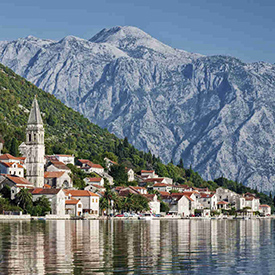
Among European countries, English is the primary native language only in the U.K. and Ireland, but it is widely spoken as a second language elsewhere. In Nordic countries and the Netherlands, a large portion of the population speaks English well, even in smaller towns. In Western Europe, you won’t have much trouble finding English speakers in major towns or popular tourist sites, and most people who work in the tourism industry speak English.
The farther east you go, however, the less English you’ll encounter (though hotel staff still commonly speak English). English speakers can certainly still travel in those countries, it just might be a bit more challenging.
3. What countries in Europe are the cheapest to visit?
In general, Eastern Europe is significantly cheaper than Western Europe. Hungary, Bulgaria, Romania, Poland, and the Czech Republic are especially popular budget travel destinations, but Slovakia, Serbia, Latvia, and Ukraine are also very cheap to visit.
4. Is it safe for women to travel alone to Europe?
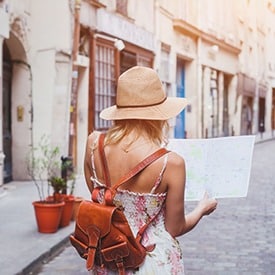
Yes! Women should have no more fear about traveling alone than men should – especially when traveling to places in Europe. Stay in areas that are safe for tourists, don’t flaunt the fact that you’re a tourist, and take standard safety precautions with your money. The one thing that may be more applicable to women than to men is that you shouldn’t go walking alone at night, but that’s standard anywhere.
Don’t carry excess cash, take familiar routes when possible, try to avoid out-of-place clothing, and relax! You’re more likely to blend in instead of sticking out as a tourist if you look like you belong there. It will likely make you more comfortable to research current country-specific travel notes here .
5. What vaccines or medicines should I get before traveling to my destination?
Since each country will have its own regulations and mandates, stay up-to-date through the CDC’s Destination Tool . It allows you to select the countries you are visiting and check real-time updates on the vaccines and medications that you need for your next trip. It is also recommended to consult a physician at least one month before you depart to ensure you are current on all required vaccines and medicines for that particular destination.
If you are traveling to several countries with unique vaccine requirements, confirm the cross-over and discuss your specific travel plans with your doctor. If you’re only in a country for a short duration or you’re only remaining in the touristic area near the coast (for example, while cruising ), certain vaccines may not be necessary.
6. Is it worth getting a Eurail pass?

Europe’s train systems are highly lauded, and many backpackers and other travelers in Europe plan their trips around riding the train from country to country. But many find themselves wondering, “Is a Eurail pass worth it?” Whether a pass is the cheapest option depends on how many train rides you’ll be taking, where you’ll be riding, and how far in advance you could book tickets.
In general, a pass will save money if you’re visiting a lot of different countries and/or taking long train rides, while buying individual tickets is cheaper if you’re booking far in advance or if you’re traveling exclusively in Eastern Europe. But, one of the biggest perks of using a pass is the flexibility: last-minute train tickets are expensive, so if you want to be able to travel with more spontaneity, a pass is the way to go.
7. Do I need to tip in restaurants in Europe?
Restaurants in Europe often note on the menu or bill that a service charge is included, in which case an additional tip is not necessary. Otherwise, tipping is not required but it’s customary to round up the bill. If you do decide to tip, make sure to do it in cash and hand it directly to your server. The major exception to this rule is Scandinavian countries, where tipping is not generally practiced.
8. What is the best way to get around Europe?

Public transportation is well developed throughout most of Europe, and it’s generally easy to get from country to country. Most trains in Europe are comfortable and efficient, and train travel is probably the most popular way to get around, whether you opt for a Eurail pass or individual tickets (see above). For most routes, though, the bus is cheaper than the train, and Eurolines is the main network of international buses in Europe. With budget airlines like Ryanair and EasyJet, flying between countries can be an affordable option, too; just check Google Flights or a site like Kayak to see all the flight options.
9. Where can travelers get off the beaten path in Europe?
In general, Western Europe is much more traveled than Eastern Europe, and capital cities and historical sites are often heavily visited. To get off the beaten path, head to rural areas or to countries in the Balkans or the Former Soviet Union, which see relatively little tourism.
10. Do I need a visa to visit Europe?

To visit countries in the Schengen Area, which currently includes 26 European countries, citizens of the U.S., Canada, Australia, New Zealand, Japan, South Korea, and most of Central and South America do not need a visa for tourist visits of up to 90 days (within any 180-day period). The U.K. is not part of the Schengen Area, and allows citizens of most of the same countries to visit visa-free for up to six months. Check here to verify the current requirements.
11. What is the best time of year to visit Europe?
In general, the best seasons to visit Europe are the spring and fall, particularly in May, June, and September. During these months, prices are lower than during peak season, and the weather is agreeable in most areas.
12. Are there any good Mediterranean cruises?

Absolutely! Apart from the Caribbean, we believe the Mediterranean is the best place to do a cruise. Why? Well it’s simple, you often get to see six different countries in the space of 10-days and many itineraries have only a couple of cruising days. This means you can be out exploring the ports every day and finding the best food and best excursions to do while enjoying such an array of different cultures in such a short time. If you’re wondering what to pack for a cruise , read our full guide.
13. Are there any recent travel restrictions to be aware of?
The European Union (the political union of 27 major European countries) applied a wide range of safety measures regarding the COVID-19 pandemic. These requirements have varied from negative diagnostic tests to not allowing in non-citizens for non-essential travel, essentially locking down the borders.
As of late 2022, Travel restrictions are lifting more and more – France, Finland, Greece, Croatia, Portugal, Denmark, and others are relaxing the vaccination requirements. Iceland and Norway have removed nearly all COVID-19-related travel restrictions.
If you intend to travel in the E.U., you should check the European Commissioner’s Platform for real-time border updates. You can also visit Travel.State.Gov for a traveler’s checklist on documentation requirements and they are a great resource for Country Specific COVID-19 Information .
14. How can I save money while traveling in Europe?

There are lots of ways to save money in Europe. For starters, stick to hostels or try couch-surfing to cut your accommodations costs. Car rentals and taxis can be pricey, so use trains and buses to get around instead, or just walk. Limit eating out, and pick up groceries for some of your meals; look for hostels or vacation rentals that have kitchens where you’ll be able to cook.
Try eating out at lunch instead of dinner too, as many restaurants in Europe have good-value (and filling) lunch specials. Skip the bottled water, and just bring a reusable water bottle that you can keep filling up. And of course, putting a limit on your alcohol consumption will always save money.

Lyric Fergusson

The ULTIMATE Packing List for Europe – Essentials for 2024
Planning a trip to Europe? Our guide covers the essentials you will need in your packing list for Europe.
This continent is one of our favourites regions of the world to explore.
Hi, we’re Rach & Marty!
We’ve visited every country in the world and want to help you get the most out of your travels!
Whether you need an expertly planned itinerary , some experienced hints and tips , or just craving a delicious food adventure , we’ve got you covered!
We may earn affiliate commissions from websites we link to, at no cost to you. Click here for details.
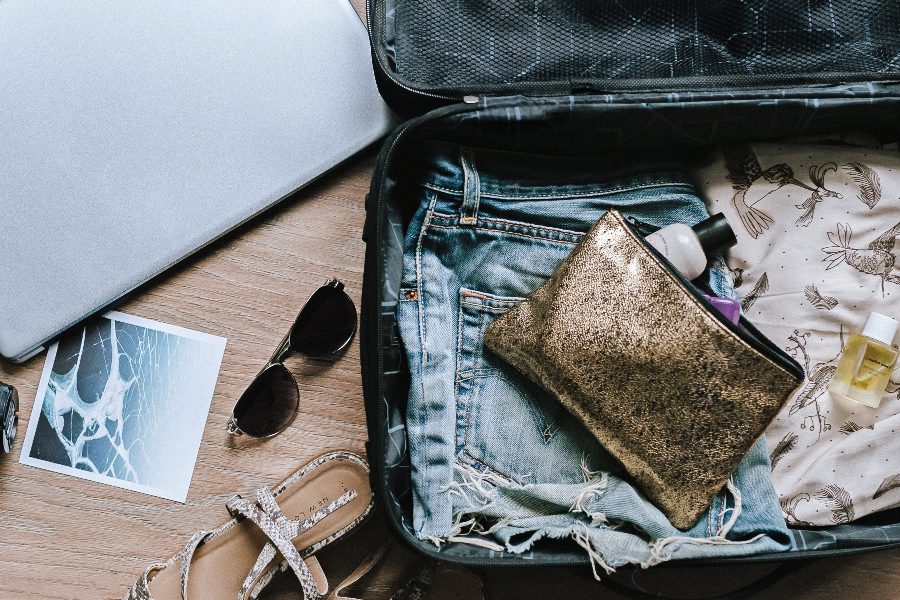
Furthermore, if you’re searching for a Europe packing list that will be light enough to carry so you can easily move around from country to country, then you’re in luck.
Items on the list below are more focused on a packing list for Europe summer. It’s the ideal Europe backpacking packing list too, as it’s light to carry, yet comprehensive.
However, you may need a few extra layers if you’re travelling during winter. We’ve got a few suggestions to complete the ULTIMATE packing list for Europe for any season.
Travelling around Europe is thrilling! Expect your trip to be full of diversity, adventure, warm hospitality, many beaches, world-class cities, and amazing food! You need to read our food map of Europe before you get there.
With so many countries packed into one amazing continent, do you know how many countries are there in Europe? 44, 45 or 49?
The best part about travelling here is if you forget something on your packing list for Europe, you can easily pick it up on the way.
Our best tip for your packing list in Europe is – Keep it Light!
Our best tip for preparing your packing list for Europe is that less is more! Trust us, a packing list for backpacking Europe or travelling with a suitcase is much easier when your backpack or luggage is light.
When travelling around Europe, believe us, you will use many forms of public transport. We firmly believe that travelling in Europe by train is the best, yet the bus network is fantastic to travel between countries too.
We know that each and every traveller is different. If you’re planning to fit as much in as possible and breeze through many countries, it’s critical that your packing list for Europe is similar to this one.
We’ve prepared our packing list for Europe summer so many times as we used to work as tour guides here for many years. Trust us, everything included in our packing list for Europe below gets used frequently.
At the same time, if you’re planning to go a little slower and stay a little longer in each country, our packing list for Europe has you covered.
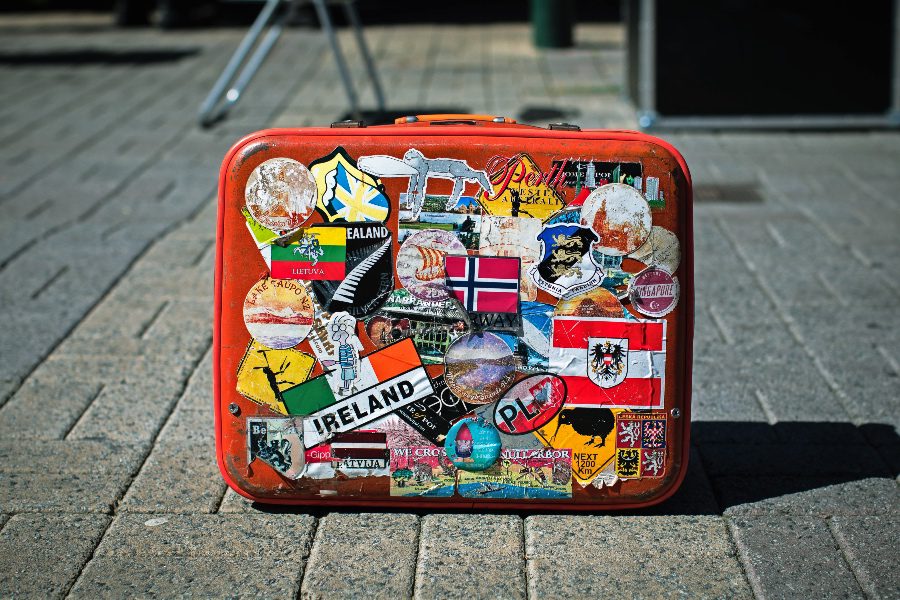
Table of Contents
Ok, let’s get to it! Your Packing List for Europe for 202 4
Choosing the right travel bag.
Ok, some people are backpack travellers and others are suitcase travellers. The type of luggage to carry items on your packing list for Europe is up to you. To help you out though, we cover the pros and cons of each travel bag in our post Suitcase Vs Backpack – Which one should you choose?
In saying that, choosing a backpack over a suitcase for your packing list for Europe will give you more flexibility. The reason for this is that you will encounter many cobblestoned streets, countless stairs, super small elevators at hotels, or none at all (so heads up for carrying your own suitcase up four flights of stairs).
It is a little easier to navigate all of this if you have a backpack rather than wheeled luggage. Nowadays, you can buy some awesome travel bags that offer both options, like the Osprey Wheels 36 Bag . You can wear this bag as a backpack and then convert it to a rolling bag too.
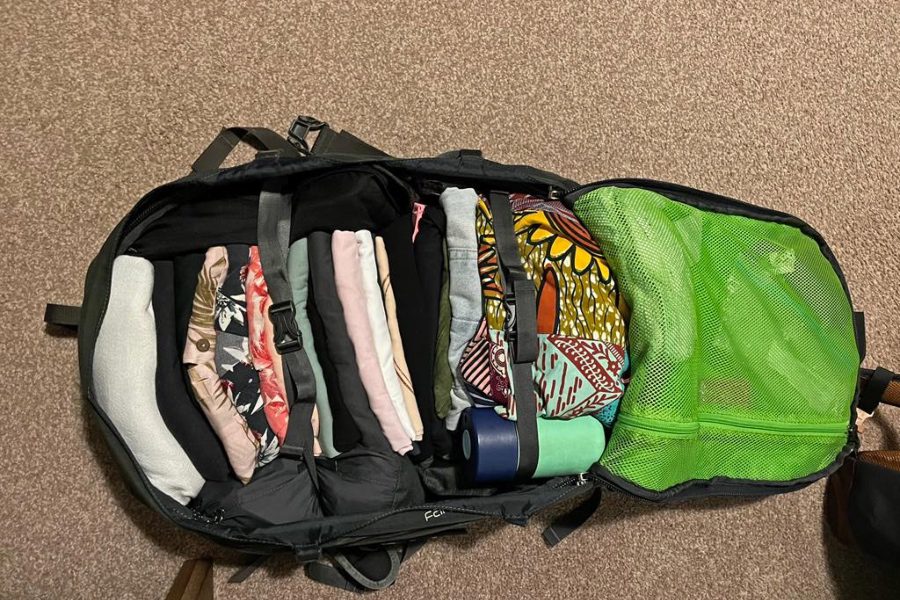
We’ve used many travel bags over the past twenty years. The one we use now is the Osprey Farpoint 40L Backpack and we love it! This is the ideal backpack for your packing list for Europe.
Do you need a small day pack?
Travelling with a small day pack is a personal choice. We travel with one as we prefer to keep our valuables with us at all times. This is especially important when taking overnight train/bus rides.
We carry this small Osprey day pack
We often lock our large 40L backpack to something stationary when we sleep on overnight trains and our small daypack containing our valuables will remain on our person, inside our silk sleeping sheet while we sleep – it feels much more secure to do this to deter any opportunistic thieves.
When we’re on the move, our small Osprey day pack sits on the front of our body with our Osprey 40L backpack on our backs, this makes it easy to quickly access passports or money.
Make sure you get Travel Insurance before hitting the road. We recommend Heymondo & SafetyWing Travel Insurance.
Click here and get 5% off Heymondo from us!
Choosing your Travel Clothes
As I mentioned at the beginning, this packing list for Europe is focused on being a packing list for Europe summer. The European summer runs from late June to late September and the majority of European countries receive high temperatures during this time. Temperatures range between 25 and 35 degrees Celsius.
The best clothing to choose for your packing list in Europe is light, breathable cotton, clothing you can mix and match, and items that dry quickly.
And, we must admit that our compression packing cubes have been a lifesaver in keeping things organised.
Packing List for Europe: Clothing for WOMEN
- 1 pair of black skinny jeans
- 1 pair Columbia zip-off long trekking pants OR Lululemon travel pants
- 1 North Face lightweight jacket/fleece
- 1 Light Rain jacket
- 1 pair of black loose cotton pants
- 1 light long-sleeved cotton shirt
- 4 basic t-shirts
- 3 loose singlets/tanks
- 1 denim shorts
- 1 cotton shorts (H&M brand or similar)
- 1 light short (wear as pyjamas or to the beach)
- 2 nice tops to wear out
- 1 little black dress
- 2 pairs of ankle socks
- 7 pieces underwear
- 1 bikini (we love Roxy brand swimsuits)
- 1 Ripcurl cap
- 2 bras and 1 sports bra
- 1 headscarf (to visit places of worship)
- Birkenstock Sandals
- Havaianas – Slim Black flip flops
- Merrell Women’s Black Hiking Shoes or Nike Women’s Black Running Shoes
Packing List for Europe: Clothing for MEN
- 2 pairs of Quiksilver Boardshorts
- 1 pair of Travel/Hiking Shorts
- 1 pair of Long Trousers
- 2 pairs Smart Chino Shorts
- 3 Tank Tops
- 1 Long Sleeve Cotton Shirt
- 1 Smart Shirt
- 1 Casual short-sleeved shirt
- 1 Warm Fleece
- 1 Light NorthFace Waterproof jacket
- Salomon Hiking Shoes or Mens Nike Black Running Shoes
- Underwear & socks

Toiletries for Women
We’re lucky to be able to share some toiletries on the road – so it gives one of us a little more room in our backpack. If Marty carries the toiletries, I’ll carry our espresso machine and fresh coffee to share the load.
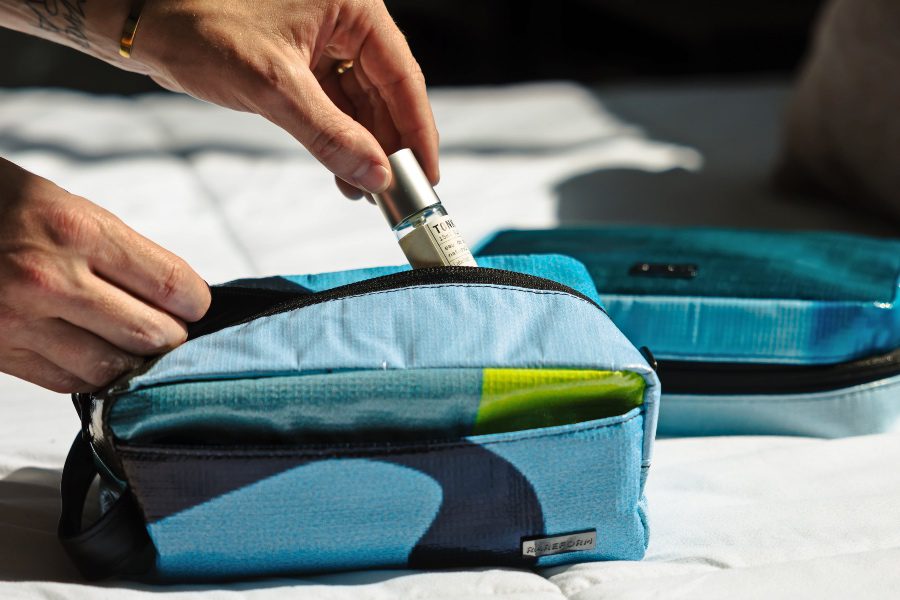
We try to keep toiletries to a minimum as they can be heavy. We also travel with carry-on baggage, therefore, all of our toiletries must be 100ml or less. If you plan on staying in hotels (and even some cool hostels) around Europe, small toiletries will usually be provided.
- Hanging Toiletry Bag
- Compression Packing Cubes
- Small containers (100ml) for refills
- Shampoo/Conditioner 100ml each
- Bar of soap
- 1 shaver/razor (we never have a problem at airports with this in our carry-on)
- 1 hairbrush
- Roll-on deodorant
- Toothpaste & toothbrush
- exfoliating shower glove (we found these in Morocco..love them)
- 100ml sized sunscreen – We like Nivea or Neutrogena brands
- Nivea face moisturiser SPF30
- Blistex and lip balm
- A few pieces of makeup (which we rarely use, but sometimes it feels nice to dress up) 1 tube of foundation , bronzing powder, and brush, 1 mascara
Toiletries for Men (as suggested by our male travel buddy)
- Toothpaste and toothbrush
- Moisturiser
- Shaver/small shaving cream
- Mosquito repellent (with DEET!)
Accessories/Extras for our packing list for Europe
- A pouch that holds my passport, different currency, bank cards, passport photos, copy of my passport, driver’s license, and a copy of our Heymondo travel insurance policy
- Nanopresso Portable Espresso Maker
- Silk sleeping sheet – For those overnight trains or airport naps.
- Sarong (our shower towel, beach towel)
- Frank Green Portable Coffee/Tea Cup
- LifeStraw filter water bottle (this lives in our small day pack)
- Oakley Sunglasses & Protective Case
- Travel clothesline
- Travel Sling Bag
Technology/Electronics
If you’re a photographer, digital nomad, or simply can’t live without your MacBook and other electronics, we understand.
We need these things as we work online as we travel the world. Here’s what we take as part of our Europe Packing list, in terms of electronics.

- 13″ Macbook Pro with charger
- iPhone 13 Smartphone with a USB charger.
- Apple AirPods for iPhone
- Old-school iPhone headphones
- Sony RX100 Mark III Camera with leather case
- Sandisk 2TB external hard drive
- Worldwide adapter plug.
- GoPro Camera – a waterproof stick/few extra clips for it
- Belkin Powerbank
- Small portable USB drive
- Small pouch that holds all cords for cameras etc
- Gorilla tripod for our Sony camera
Safety in Europe
Travelling around Europe is regarded to be relatively safe, but it’s best to read our 12 Tips for Safe Travel. The same goes for travelling anywhere in the world, accidents do happen.
Some cities in Europe (Rome and Barcelona in particular) have a higher rate of pick-pockets and petty thieves, so you need to be a little more cautious of your belongings.
And it goes without saying that common sense is essential to take in your Europe packing list and beyond.
We 100% recommend Travel Insurance
We highly recommend you sort out some good travel insurance to cover you when things go wrong.
It will be one of the most essential things on your packing list for Europe. We use Heymondo to cover us on our world travels. We recommend adding one of their comprehensive travel insurance policies to your packing list for Europe. Get 5% discount on your travel insurance policy from us!
Transport and Getting Around Europe

Getting from A to B in Europe is easy. Read our best tips about travelling around Europe by Train , it’s a great way to travel this continent.
The ONLY website we use to make reservations for train tickets is Trainline . They offer the cheapest fares, you get instant confirmation and their booking platform is so easy to use.
The best part about travelling Europe is that you can also find some incredibly cheap flights with low-cost carriers.
We book all our flights around Europe on CheapOair . The prices are unbeatable and you can choose to pay in the currency of your choice.
The bus network in Europe is wonderful too! The best website for checking buses, and other forms of transport is Omio.
How to Book Accommodation in Europe
We always use the same websites to book accommodation in Europe. Booking.com is our number one choice for booking accommodation in every European country.
Apps to download for Europe
Download these apps on your phone to make your travels in Europe much easier.
- CheapOair (to search flights)
- Booking.com (to book accommodation on the go)
- XE.com (to check the latest exchange rates)
- Maps. me (the best offline maps to help you navigate around)
- Google Translate (while English is widely spoken in Europe, this app is so useful when you get lost in translation)
- Omio (book buses, ferries and trains on the road)
- Trainline (book train and coach tickets all around the world and save up to 60% discount on average per ticket).
RELATED POST – 20 Best Travel Apps in 2023 (Plus They’re Free)

Staying in Europe long-term?
If you’re considering staying longer in Europe (and you’ve got the right visas to do so), check out the Trusted Housesitters website for saving loads of money on accommodation. Become a house-sitter in Europe, (and all over the world) if you’re considering staying in one place for a little longer.
Being a house-sitter means free accommodation for you in return for looking after different homes around the globe. This was one of the best things we ever did! Join now with our personal invitation and receive a massive 25% off your membership!
Travelling Beyond Europe?
Travelling beyond Europe or need some suggestions for warmer items to add to your packing list in Europe? Our Ultimate Packing List for every traveller includes the items we carried as we travelled to every country in the world.
We moved between all types of weather, from very cool temperatures to sweltering hot ones. And, we still manage to travel with carry-on baggage only, often less than 10kg.
We’ve also put together our Complete Packing List for Africa and the Essential Packing List for Travelling in Southeast Asia .
Group Tours in Europe
And, if you don’t have the time to travel slowly in Europe but really want to discover more, then a group tour could be the answer.
We recommend Expat Explore. They offer a variety of coach and rail group tours around Europe to suit everyone, and you’ll have a fantastic crew to take care of all the details. Your only task is to turn up and have an amazing time.
Check out Expat Explore , and if you see a tour that you want to book, use our promo code VERYHUNGRYNOMADS at checkout for an additional 5% discount off your trip !
My other suggestion is GAdventures for awesome small-group adventures in Europe.
Don’t miss our EUROPE CITY GUIDES
- ROME 3 Days Itinerary
- VENICE 1-Day Itinerary
- FLORENCE 2 Days Itinerary
- AMSTERDAM 3 Day Itinerary
- PARIS 4 Days Itinerary
- BUDAPEST 2 Days Itinerary
- PRAGUE 2 Days Itinerary
- LONDON 1 Day Itinerary
- ATHENS 1 Day Itinerary
- BERLIN 2 Days Itinerary
- VIENNA 2 Days Itinerary
- LISBON 2 Days Itinerary
Travel Tips & Inspiration
We love to share our knowledge and advice about travelling the world. You may enjoy reading our best-ever travel tips to help your budget to stretch further on the road.
Perhaps you’re travelling on a budget? These 10 cheapest countries in Europe to visit may be just the tool you need to start planning an epic trip. Don’t forget to check out our Ultimate Food Map of Europe .
And, for all of the food lovers out there, don’t miss our top 10 best countries for foodies! And, if you’re more interested in history, these 30 amazing historical places in the world will fascinate you!
But, here are 8 things to know about traveling to Eastern Europe and it’s good to know these 7 misconceptions about Eastern Europe too.
Subscribe to our newsletter!
Expert travel tips, resources and exclusive discounts worldwide
Or, perhaps these 21 Cheapest Countries to Visit Right Now is just the thing you’ve been searching for.
We’ve got a bunch of tips for how you can save money to travel the world , and even when you’re out there travelling, maybe these 20 jobs that PAY YOU to travel the world will help you travel longer. It worked for us, and we bet it can work for you too.
Finally, these top 6 travel hacks to save you money are great to read when planning your travels.
And, if you’re planning a new trip, whether it’s for a week, a month, or even a few years, consider buying an eSIM to stay connected . This is our favourite travel product, and you can read more about what is in eSIM and why eSIM is so convenient for International Travel .
Check out the travel gear we use on the road, and for the products and websites we recommend to plan new trips, head to our Travel Resources Page .
Travel Planning Resources
✈️ Flights : We use Skyscanner to book cheap flights worldwide.
🏨 Accommodation : Booking.com is our preferred platform for booking hotels and accommodation.
🏥 Travel Insurance : We recommend Heymondo ( Get 5% off Heymondo) & SafetyWing
🚌 Transportation : Trainline is the best website to reserve trains. We use Omio to book transport worldwide. For travel in Asia, we use 12Go.
🚘 Car Rental : We use DiscoverCars to book rental cars worldwide.
👫 Group Tours : G Adventures OR compare multi-day tours worldwide with Tourradar .
📸 Day Tours & Trips : GetYourGuide & Viator are the only two platforms you need.
📚 Lonely Planet: The Best Range of Travel Guides & Ebooks , and FREE Shipping! (use code RACHELDAVEY10 for a 10% discount)
🎒 Luggage : Osprey Farpoint 40L Backpack or Samsonite Luggage Range.
🛄 What to Pack: Don’t forget your Universal charger and a good power bank . To help you pack the essentials, here is our ULTIMATE Packing List for all Travellers .
🐶 Become a House Sitter: Join Trusted Housesitters and enjoy FREE accommodation worldwide. Use our invite to receive 25% off your new membership.
💰 Send Money Anywhere: WISE & Revolut are the best online accounts that let you send money, get paid, and spend money internationally. Both are so easy to use and way cheaper than any bank transfer.
📶 Stay Connected: Airalo eSIM allows you to get connected the moment you land at your destination, and you can avoid those expensive data roaming charges. We LOVE this product! Use promo code NOMAD15 for 15% off ALL eSIMs (new Airalo users only) OR use NOMAD10 for 10% off ALL eSIMs (for existing Airalo users)
✅ Check out our Travel Gear and Travel Resources for more valuable tips to save you money!
Tasty Food Adventures

Best Wine and Food Tour in Barossa Valley

Food of Algeria – 10 Delicious Dishes to Try

12 Best Cheap Eats in Cairns

Why Food Tours in Hanoi are a Must-Try Experience
See all Food Adventure blogs
Expert Travel Guides

Seychelles on a Budget – Amazing Destination for 2024

Top 10 Things To Do In Scotland Edinburgh

Border Crossing from the Dominican Republic to Haiti

13 Things to Do in Bratislava Slovakia (including the fun things to do)
See all our Travel Guides
Trusted Hints & Tips
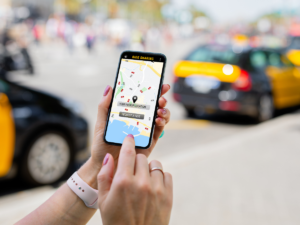
20 Best Travel Apps in 2024 (Plus They’re Free)

7 Tips: How to Find the Best Food when Travelling

Backpack vs Suitcase – Which One Should You Choose?

20 Signs You’re Addicted To Travel – How Many Apply To You?
See all our expert Hints & Tips
Leave a Reply Cancel reply
Your email address will not be published. Required fields are marked *
Post Comment

Travel Tested Europe Travel Essentials: The Only Checklist You Need!
You’re planning a European trip and you need a Europe travel essentials checklist with all the travel-tested essentials for traveling to Europe so that you can have an amazing, stress-free trip. Well, good thing you landed exactly in this spot!
We all know planning a trip to Europe is a big deal and usually, it’s a bucket list travel goal getting checked off. The last thing anyone enjoys is the hassle of not having something they need!
The good news is I’ve traveled to Europe hundreds of times and along the way, I’ve made my fair share of Europe travel mistakes. But, they were all learning experiences! (Can you tell I’m a teacher?!)
So, I’ve put together everything I’ve learned in this ultimate guide of essentials for European travel so that you’re 10 steps ahead of the game before you even arrive at the airport.
Travel-Tested Europe Travel Essentials: The Only Checklist You Need!
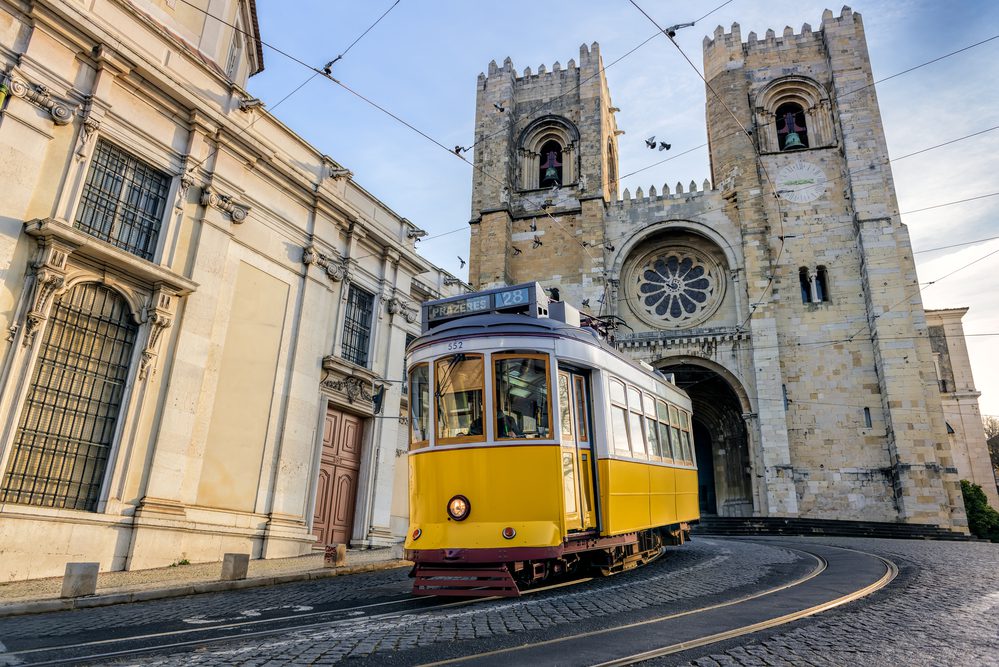
You can fill countless suitcases ( spoiler: don’t do this) with whatever and however much you want but without the right things for your European adventure, a potential headache can steal all the fun from seeing the Eiffel Tower or Rome’s Colosseum.
So, let’s skip the headache and build your European travel checklist the right way!
Essentials for Traveling to Europe: The Fundamentals
When planning a trip to Europe, there are European travel necessities that fall into a few categories. Some are absolute musts while others are more personal or for comfort.
Let’s start with the fundamentals. After all, it doesn’t matter if you’ve packed the perfect outfits if you can’t get past airport security.
Whether you’re heading to Italy , Iceland , or Spain don’t leave home without using this guide as your Europe packing list!
Obvious, but a total deal breaker for international flights if there’s an issue with yours. Be sure it’s in good condition with no visible damage. Also, check that it has at least 2 pages with no stamps and 6+ months until its expiration date. I always keep my passport and important documents in this protective cover , but also for my sanity so I always know where they are! This passport case is great if there are multiple passports to store.
Driver’s License
If you’re renting a car, you will need to show this to pick up your vehicle. But even if you’re not, it’s smart to have another official form of identification with your photo on it in case something happens to your passport.
Maps for Driving & Getting Around
If you’re driving in Europe, download Google Maps for the area(s) where you’ll be driving before leaving home. From the Google Maps app, click on your name or initial in the top right corner. Select “Offline Maps.” Then, click on “Select Your Own Map” at the top. Highlight the area(s) where you need a map and download it. When you arrive at your European destination, you’ll be able to navigate in the car even without an internet connection. Similarly, the Maps.me app allows you to download maps to use offline. These maps can be especially great for when you’re out walking in a city because they show local shops, restaurants, walking paths, and more.
Using your debit card at a local ATM once you arrive is the savviest and most convenient way to get local currency at the best possible exchange rate. Also, debit cards typically have a Visa or MasterCard logo on them and require a PIN. In some cases, a purchase you need or want to make will require a card with a PIN like getting gas in a remote part of Iceland or buying entry tickets to a castle in Germany. ProTip: The Charles Schwab debit card refunds 100% of any ATM or withdrawal fees no matter where you are in the world. Don’t have an account? It’s free to set up. Plus, you can deposit a small amount into your newly created “travel account” to use for your trip. If your wallet gets stolen or you encounter any fraud, only this account with a small amount of money is at risk instead of your main bank account.
Travel Rewards Credit Card (with no foreign exchange fees)
For 95% (if not all) of your purchases in Europe from restaurants to shops, hotels, top sights, and museums can and should be made with a credit card. I recommend (and use myself!) a travel rewards credit card like this for every purchase possible for fraud protection (i.e. when that bowl you shipped from Tuscany never arrives) and for the best possible purchase exchange rate with no fee. ProTip: When making credit card purchases in Europe, you’ll be asked if you want to pay in Euros or U.S. dollars. Always choose Euros. The credit card processor is secretly charging you a convenience fee that’s baked into that seemingly helpful U.S. dollar conversion.
International Driver’s License
If you are renting a car in Europe, some countries like Italy, Spain, Greece, Germany, and others require this document. The confusing part is car rental companies will let you rent your vehicle even without this document. You only discover that you have a problem (and possibly a hefty fine) should you be pulled over by local police. Apply through AAA , either at their nearest branch or by mail. It costs $20 + tax. You’ll also need 2 passport photos which they can take for you at the branch for a small added fee. The permit is good for a year and can potentially save you a lot of money if you get caught without it.
Travel Insurance
Important, especially if you don’t have a travel rewards credit card that offers at least some basic protections. But whether something happens before your trip and you need to cancel or you fall on some uneven cobblestone and break a wrist, you want to make sure you’re ok, as is the travel investment you made. Plus, most multi-day tours require that you show proof of travel insurance .
Photos/Copies of Important Documents & Travel Bookings
Take photos of your passport ( a must! ), driver’s license, credit cards, travel reservation confirmations, etc, and store them in a cloud-based place like Google Drive or Dropbox. If you lose anything, you can access the photo from any device with an internet connection. You can also print copies of flight, hotel room reservation(s), and activity bookings if it adds peace of mind.
And even though the things above will help you navigate all the logistics of international travel, don’t leave home without the Europe travel essentials you personally need for an incident-free trip.
Prescription Medications
Contact lenses + at least 1 extra pair, feminine hygiene products.
Ladies, whether you use this , this , these , or something else, be sure to take the personal items you need to be comfortable.
First Aid Kit
This does not need to be overly extensive. I typically pack tablets for headaches, stomach troubles, a cold, and in case of an allergy, some Benedryl. I also like to carry a few throat drops with me, even if just for a dry mouth or throat, and a couple of band-aids for cuts or a blister. You’ll find pharmacies everywhere you go in Europe with everything you’d find at your pharmacy in North America. The idea here is just to pack a few of these things to hold you over should you need to get to a pharmacy in Europe. For reference, my first aid kit for European travel fits into a small plastic sandwich baggie.

Must-Have Travel Europe Essentials
The next part of the list covers Europe travel essentials that are important to have whether you’re road-tripping in Ireland or sightseeing in Budapest.
These important travel items keep you safe, and connected and help make your travel days to, in, and from Europe smooth and hassle-free.
Portable Power Bank
Keep your cell phone charged and ready to go whether it’s to take photos or to use a navigation app as you explore a new European city. And, even though most do, don’t assume all airplanes have a charging port for your phone. This is especially true on inter-continental flights where shorter-haul planes are used to go from one European country to another. (It’s not a good feeling to arrive at your destination airport with a dead phone!) I bring this portable charger with me on every Europe trip. Fully charged, it can refill my phone’s battery dozens of times before needing to be recharged and it doesn’t take up much space at all in my bag.
Plug Adapter
You’ll need to have the right plug adapter(s) to plug your devices into European outlets. I have an older version of this plug adapter set that I have used to travel extensively throughout Europe and have never had a problem. The mini power strip is perfect for charging multiple devices at once. ProTip: If you’re going to multiple European countries, check the plug type for different countries. They aren’t all the same. Or pack a reliable universal travel adapter .
Luggage Trackers
If you’re checking a bag for your trip to Europe, Apple Airtags are great for keeping track of your luggage and can even help you locate your bag should the airline lose it. You need to have an iPhone to track the airtag. If you don’t have an apple device, try the Samsung SmartTag or Tile Mate.
Wire/Gadget Storage
You could choose a traditional wire organizer to manage cables, your portable battery, and other gadgets. They are extremely useful for storage and sanity! I also love these mesh packing squares . I’ve had the same set for years and they’re so versatile! I can use them for my cords, plug adapters, and portable charger. But they’re also great for just about any small, loose objects you need to pack. They keep everything together so you can find whatever you’re looking for quickly and without unpacking half your bag to find it!
SIM or eSIM Card
Staying connected is one of the most important travel necessities for Europe! European restaurants, cafes, shops, and hotels tend to have decent to good WiFi. However, free public Wifi isn’t the safest or most reliable way to connect your device to the internet. Not to mention, you probably still want a connected device even when you’re not in one of these places. For U.S. travelers, your phone’s wireless provider likely offers a travel pass. But these are typically very expensive (i.e. $10 a day!) and come with very limited amounts of data. Put another way, this isn’t a great option for staying connected while in Europe. The better option is to purchase a SIM card when you arrive at your destination. Most airports will have them available for sale, as will shops in most major cities. Even better is to buy an eSIM before you leave so it’s ready to go when you arrive. An eSIM comes with the added advantage of not needing to buy and install a physical card once you arrive. Either way, SIMs and eSIMs cost less and can be purchased in different data amounts depending on how much you’ll need. I use Holafly to purchase eSIMs when I travel. If you use code, THEGLOBETROTTINGTEACHER, you’ll get 5% off your purchase.
Luggage Locks
These durable locks are TSA-compatible so you can lock your checked bags. If they’re inspected, the TSA agent can unlock it and the lock will leave a red indicator letting you know your bag was inspected. Beyond that, these handy locks are perfect for backpacks and a variety of other bags whether you want added security in your hotel or you’ve stowed your bag in a luggage rack on an overnight European train.
Secure Money Storage
From the airport to full days of European strolling and sightseeing, you want something to keep your money and credit cards safe. Whether it’s a moneybelt , a neck wallet , an anti-theft bag , or a scarf with a hidden pocket , take some precautions to deter pickpockets. From Barcelona to Paris , would-be thieves are more opportunistic than anything. Be alert in touristy areas and on public transportation. (Direct eye contact works wonders to let someone know you’re paying attention.) Add extra layers of security to avoid looking like a target and it’s unlikely you’ll have any problems. ProTip: Only take 1-2 credit/debit cards and a little cash with you when you head out for a day of sightseeing. Extra money and credit cards, as well as your passport, will be safest locked in the hotel safe.
Travel Day Bag
You want a small bag or day pack that you can use to store your belongings and comfortably walk and sightsee. This has been my go-to daypack whether I’m hiking along the Slea Drive in Ireland or standing in awe as I stare at the Mosque-Cathedral in southern Spain . It’s compact and holds a lot more than it seems it would. I typically pack this inside my carry-on, which is also convenient later if I need an extra bag for souvenirs. For something a bit more fashion-minded, this messenger bag or this crossbody clutch are both stylish and functional. Plus, they both come with theft-protection.
Reusable Water Bottle
Most European countries have clean, drinkable tap water. While you should always check the countries you’re planning to visit, rest assured you can safely refill your water bottle in most places. I’ve used the fountains in Italian cities and while hiking in the Cinque Terre, as well as filled up while driving Iceland’s Diamond Circle. So, save money and reduce plastic waste with a reusable water bottle !
Flight Creature Comforts (a.k.a. Things to Keep you Comfortable!)
A long flight across the Atlantic Ocean can be uncomfortable depending on what type of flyer you are and where you’re seated on the plane. But the good news is that small comforts go a long way! You want to arrive as rested as possible so that on your first day in Europe you can last the full day and adjust to the time zone. Ear plugs, an eye mask , cozy warm travel socks , and a neck pillow can all help you sleep on long-haul flights. I also always have my travel-sized toothbrush with me so that I refresh in the morning before we land.
Entertainment
Whether you have a Kindle to read or you want to downloaded audiobooks, podcasts, music, or your favorite shows on your phone or laptop, plan to do this in advance. Anything that needs to be downloaded should be done before you leave home so you don’t use up data or rely on slow hotel wifi once you arrive in Europe. With these things set up on your electronic devices, you’ll be ready for that long train ride or just lazing away an afternoon at a cafe in Paris .
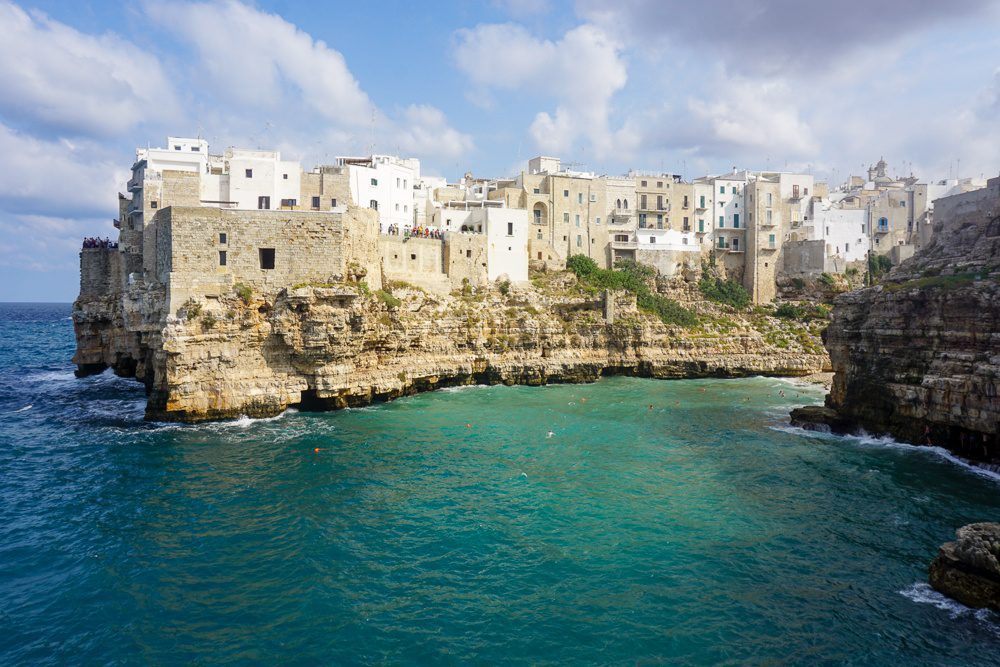
Europe Travel Packing: How to Pack for Europe
One of the essentials when traveling in Europe is to pack light.
If you’re like most people, you probably have at least a couple of European cities or areas on your travel itinerary. Dragging and lifting big, heavy suitcases from airports to hotels onto trains and along sidewalks is a stressful hassle that’s just not worth your energy.
So, let’s cut to the chase. You need a few important items to pack lightly, a sturdy piece of luggage, a carry-on bag, and packing cubes.
Rolling Suitcase
This is the rolling suitcase I’ve used for nearly all my trips to Europe over the past several years. And let me tell you, I’ve put this bag through the wringer! It’s proved its durability by being checked at countless airports and rolled through train stations all over Europe, as well as hauled in and out of hotels, metros, and more. Put any doubts aside about whether this piece of luggage can hold everything you’d need for a 2-week trip to Europe. I’ve done it numerous times and even stayed for up to 3 weeks without really needing to do a big batch of laundry. I’ve used a couple of other bags, too, if I’m taking a shorter trip. These honorable mentions go to this 19″ carry-on roller or this backpack which I’ve used for more outdoorsy European adventures.
Packing Cubes
These are the packing cubes that quite honestly I couldn’t live without. They are what makes the above suitcase possible. Depending on how I want to pack, I use 3-4 of these packing cubes to hold all my clothes. The magic comes from the compression. Once you’ve rolled everything inside and zipped the cube, the 2nd zipper compresses the cube down to half its size. If necessary, you can smooth out any lumps by pressing on the cube to even things out. ProTip: Think about how you’ll manage dirty clothes. You could bring an extra packing cube or a dirty laundry bag. You could also shift clothes around as you travel, moving dirty clothes to a single packing cube and clean clothes into all the others.
Carry-on Bag
Without hesitation, this carry-on travel backpack has been my go-to for years. I absolutely love it. This bag has the perfect combination of smart storage compartments, style, and comfort. In fact, this is the most comfortable expandable backpack I’ve ever worn. I store things like my laptop, important travel documents, a change of clothes, and a 1-quart toiletry plastic bag with some necessities for the flight. Fully expanded, it can even hold a few days’ worth of clothes or those extra souvenirs you want to bring back home. ProTip: I like to pack a few extra plastic bags in case something leaks and for things like wet clothes.
Hanging Toiletry Bag
Not only does a hanging toiletry bag keep everything organized and easily repackable for European city-hopping, but it also allows you to keep things like toothbrushes and contact lens cases off the limited counter space around hotel sinks. You can still have all your toiletries hanging in the bathroom when you need them without worrying about knocking them off the sink.
Mini Travel Bottles
No need to take up space in your luggage with full-sized toiletries or create more waste with travel-sized (3.4 oz.) toiletries. These mini travel bottles are all TSA compliant, come in different sizes, and are easy to fill and dispense. Best of all, they’ve never leaked into my bag!
Clothes for Your Europe Travel Checklist
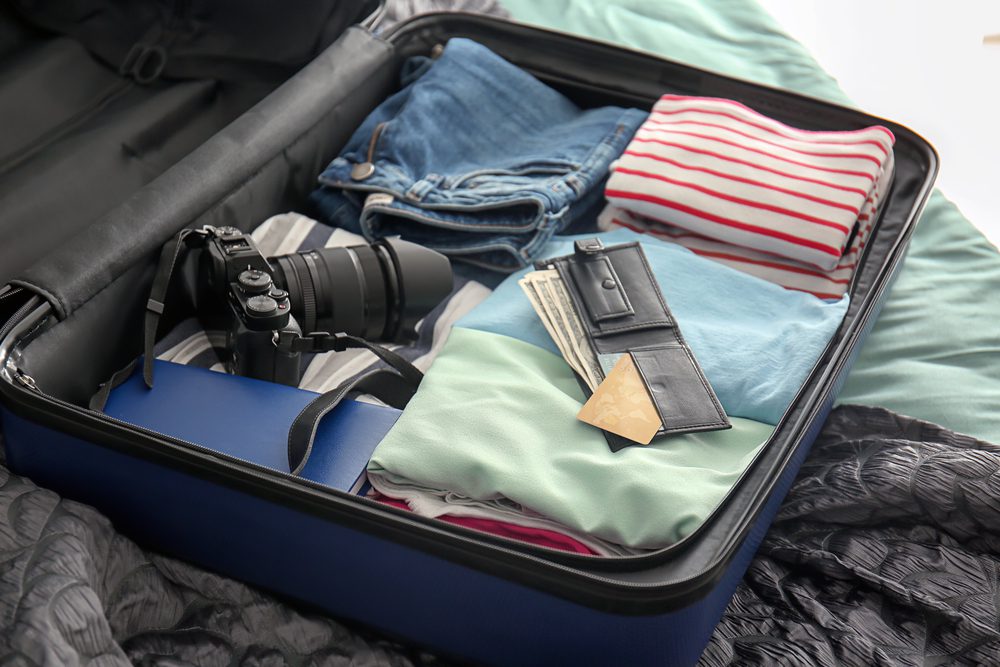
This section is a bit subjective because the clothes you pack will be dependent on the time of year you travel, what you’ll be doing, and your own style. But what to pack for a Europe trip is one of the most common questions I get, so I’ve compiled my best tips and recommendations below.
The most important thing is not to overpack. I know, easier said than done!
One way to avoid this is to plan your outfits, or if that is too difficult, pack clothes in a similar color palette. Pack neutral colors than can be worn with many different things. By doing this, you’ll inevitably have numerous pairings because most of the pieces will go together.
As you begin to pack, lay everything out first. You’ll likely be able to eliminate things that are duplicates (no, you do not need 3 black tops.) or items not in line with the majority color palette of the rest.
There are cliche items to avoid in European cities like flip-flops, workout clothes, or anything too casual like sweatpants or sports jerseys, shorts, super dressy clothing, or clothes meant for hiking and other outdoor activities. Not only will avoiding these items in big cities be more fashionable, but they also help you blend in more. When you blend in more, you’re less of a target for a potential scammer or pickpocket.
Think more along the lines of classic pieces in neutral, soothing, or dark colors. For example, navy, black, beiges, white, and soft pastels. Also, be mindful of clothing that is too revealing, especially if you’re planning to visit cathedrals or other religious sites like in Rome or Seville .
The shoes you pack are also (so!) important.
First, pack at most 3 pairs of shoes including the ones you wear on the flight. Think smart casual and comfortable when choosing which to pack to find a balance between fashion-friendly and comfortable. You’ll likely be walking a lot and oftentimes on cobblestones.
And ladies, unless you have a specific formal event planned, you won’t need high heels. Even if you’re thinking they would be nice to wear for dinner, high heels are near impossible on cobblestone streets and take up valuable suitcase space! Instead, opt for a boot with a chunkier heel if you feel you need something dressy.
The items below are meant to be ideas to help you see what’s typically in my suitcase.
Except for the hottest days of the European summer, jeans always work. They can be dressed up or down and worn with every top you pack. Everyone has a favorite pair of jeans they love so I want to give a shout-out to mine. These Duer Performance jeans are perfect for travel. They have a good amount of stretch and are very durable. What I love is they never seem to stretch out after multiple wears and they’re great for both city sightseeing and hiking. No matter which jeans you pack, go for a pair of dark-wash jeans. They’ll look cleaner for longer! Leggings are timeless, comfortable, take up little space in your luggage, and can be part of a smart casual or even dressier look. In other words, they’re perfect for travel! Other pants I’ve included in my suitcase and are versatile enough for a range of temperatures have been these Duer No Sweat Everyday Pants , these 7/8 joggers , and Eddie Bauer Departure pants . For hot summer travel days, go with wide-leg linen blend pants and other breathable fabrics instead of shorts.
No matter what the season is I like to bring tops in different sleeve lengths that can be worn on their own or under a layer like a cardigan or a blazer. For summer European sightseeing, short sleeves that cover the shoulders will be ok for most Cathedrals. Lightweight and loose-fit tops will be the coolest for walking around a European city. Generally speaking, I pack these 3/4 sleeve shirts or these shirts with long sleeves. Lightweight sweaters are perfect for spring and fall and can mix and match with many different types of bottoms. They can be dressed up with a scarf and boots or worn with jeans and sneakers when you want to be more casual. Classic fit tees always work. And of course, a long flowy top pairs perfectly with leggings.
A top or a bottom layer can make all the difference for both style and comfort! For winter travel in central and southern Europe, a thin, effective base layer becomes your secret weapon. It keeps you warm while you’re walking without adding bulk to your overall look. In northern Europe, like Stockholm or Finnish Lapland , a baselayer top and bottom are essential! For shoulder seasons, a casual blazer that can pair with nearly all of your outfits is a win-win! Cardigans, either lightweight , open front , or something chunkier , go with most types of tops and bottoms and are great for added warmth even for a breezy evening by the sea. A lightweight jacket can come in handy for those cooler spring and fall nights. It’s an added bonus if it has a hood in case you get some rainy days.
Accessories
A scarf is an absolute Europe travel essential! It can add to your overall look and even provide warmth when needed. I always have 1 (or 2) with me when I travel to Europe. Longer scarves create that perfect fall or transition season look. These square scarves are so fashionable and can double as a headband! If you’re looking for something that can double as a scarf and a wrap, these pashmina scarves are perfect. ProTip: As a general rule of thumb, it’s best to wear little or no jewelry when traveling to avoid being a target for potential theft.
Comfortable Shoes!
Perhaps the most important Europe packing decision you’ll make is the shoes you’ll bring. European travel inevitably comes with a lot of walking which will become difficult or even painful with uncomfortable and unsupportive shoes. A Chelsea-style boot works in every European city and can be worn day and night. (In Italy, I think it must be obligatory for every Italian woman to have a pair in black!) These winter boots are stylish and warm in the colder months. Allbirds are some of the most comfortable sneakers I’ve ever worn. Vionic shoes like these and these are great, too, and come with extra arch support. For summer European travel, I never leave home without these sandals . They’ve been an excellent investment and have saved my feet compared to other non-supportive summer shoes. Bottom line – Pack comfortable walking shoes for both day and night. Your feet will thank you!
Europe Travel Essentials FAQs

Is it better to travel with a backpack or suitcase in Europe?
There are pros and cons to both. Personally, I prefer a rolling suitcase and have never found it to be a problem even when traveling from city to city. Yes, there are cobblestones and sometimes no elevators when you need them. However, I’d rather lift my suitcase for a moment just to get up or down some stairs than always carry it on my back.
What size suitcase is best for a 2-week trip to Europe?
I’ve typically traveled with a 24″ suitcase for 2-3 weeks in Europe with the help of my packing cubes. If you need a bit more space, look at a 26″ or a 28″ but I wouldn’t go any bigger than that. Otherwise, it can become a real chore to move from place to place.
Is it better to fold or roll clothes in a suitcase?
Without question, it’s better to roll clothes in a suitcase. It saves space and protects against wrinkles. When rolled clothes are packed within a packing cube, it’s often possible to have 2 layers of rolled clothing inside.
How much should I pack for a 2-week trip to Europe?
In general, you’ll want to pack 3-4 bottoms and 5-6 tops. Dresses are also helpful (but not required) because they are complete outfits that can be dressed up or down. I’d bring 1-2 dresses if they match your style. For shoes, 2-3 pairs are plenty. Above all, comfortable shoes are absolute Europe travel essentials!
Also bring a scarf to use as an accessory, to cover up in conservative places, or for a little warmth. And unless you’re traveling in the absolute heat of summer, pack a blazer or light jacket (jean jacket, trench, etc.), as well as 2 sweaters or items for layering over a lighter top. Be sure the top layers go with the majority, if not all, of your clothes.
If your trip is in the winter, be sure to have a packable winter coat , a warm hat, waterproof boots , and layers. One of my hacks is to pack a couple of base layer tops so I can get added warmth without adding too much bulk to my bag or body!
Essentials for European Travel: Bottom Line

Your travel packing list for Europe needs to include a combination of essential items, gear, gadgets, and clothes. If you take the time to get yourself set up and packed using these packing tips before your trip to Europe, you’ll have done everything you could to ensure a hassle-free, comfortable, and amazing trip!
So, what’s on your checklist for European travel?
Like this post? Please share it using the buttons in this guide!
Related Posts

London Trip for the Cost of Dinner and a Show
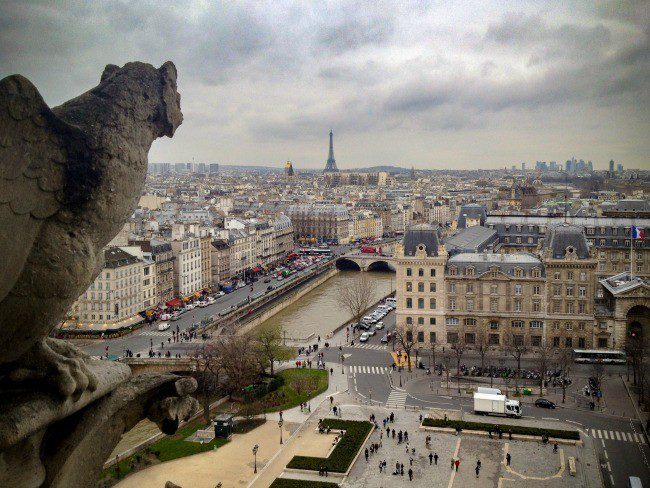
A Cheat Sheet for Paris First-Timers
Leave a comment cancel reply.
Your email address will not be published. Required fields are marked *
Save my name, email, and website in this browser for the next time I comment.
This site uses Akismet to reduce spam. Learn how your comment data is processed .
Privacy Overview

Europe Travel Essentials: The ULTIMATE 2024 List
Whether you’re visiting Paris in the summer or the Swiss Alps in the winter, it’s always helpful to have a guide to assist you with packing. I know if I didn’t use a Europe travel essentials list, I would probably forget everything from my passport to my suitcase.
During my years of traveling, I have been creating this comprehensive list of everything I personally own and use on my travels, and I would never recommend anything I don’t believe in. So, you can feel confident that I have tried and tested ALL of these products, and continue to use them on every trip I embark on!
If you are planning a trip and are researching “packing lists” or “essential travel items”, you’re probably going to find dozens of articles all stating the 30 items you absolutely must buy before traveling … and that is simply not true.
You don’t need to go out and spend a ton of money on items that you either won’t use at all or will only use once then forget about upon your return. I have linked to only 5 items below, and I can promise you that they will vastly improve your travel experience and you’ll use them time and time again.
While this list is mainly geared towards European travel, many of these items still come along with me on my travels all over the world. So, even if you aren’t going to Europe, this list is still very versatile. But if you are, be sure to check out my Greatest Tips for Traveling to Europe for the First Time !
Happy Travels!
Your FREE Travel Essentials Checklist is Here!
Get the ultimate travel checklist for your next trip abroad!
What are the Basic Travel Essentials?
When it comes to packing for a long trip, it’s very easy to get overwhelmed and forget even the simplest of items. That’s why I’ve created this basic Europe travel essentials list!
Europe Travel Essentials: Clothing

* Quantity will vary based on season of destination and length of travel
Europe Travel Essentials: Toiletries

* Prescriptions and medications must be accompanied by a letter from the doctor or prescriber for TSA approval
Europe Travel Essentials: Personal Items

Carry-On Europe Travel Essentials

Now, it may seem simple enough to pack a carry-on bag, but there are a few things you really don’t want to miss. Unfortunately, airlines make mistakes sometimes and you could end up without your checked bag for the first couple of days (or more!) of your vacation.
To prevent ending up in Spain without a bathing suit or Norway without a jacket, be sure to follow these simple tips on your next trip abroad!
✔️ Always pack an extra set of clothing in your carry-on bag
This way, if your checked bag gets lost, you won’t be stuck in dirty clothes that you were stuck on an airplane for hours in.
This could also help you save a bit of money since you won’t have to buy any clothes at your destination while you wait for your bag to be returned to you!
✔️ If it’s cold in your destination, always keep your coat with you
I’ve fallen victim to the classic “I’ll just throw my coat in my bag, it’ll be comfortable on the flight” mindset, then they lost my bag and I ended up wandering around Germany for a few days in March with nothing but a few long sleeve shirts.
Running from store to bar to restaurant in 40 degree (Fahrenheit) weather made for some great laughs, but keeping my coat on my person would have saved me from catching a cold.
Likewise, if you’re hitting the beach in your destination, keep a change of clothes plus a bathing suit and sandals in your carry-on. Since most hotels provide towels, you won’t even notice your bag is missing!
✔️ Be prepared for an overnight
This means a travel-sized toothbrush and toothpaste, a mirror and a small amount of makeup, deodorant, your phone charger, and whatever else you feel is essential to spend a night in a new destination.
Just remember to keep it light and only pack what you will need.
What Should I Not Forget to Pack on my Europe Travel Essentials List?

Outside of your Europe travel essentials list, there are a few items I highly recommend keeping room in your suitcase for! For me, travel is all about the experience. I love becoming fully immersed in new places, cultures, cuisines… you get it.
But, over my years of traveling around the world, I have found that ripping through my suitcase for that one shirt I wanted to wear and wasting money on purified water because I didn’t have a reusable water bottle with me negatively affected my travel experience.
So, after tons of research and years of testing out different products, these few items are the only ones I bring with me everywhere I go now.
I can personally say I have tried and tested each of these products, and would never recommend you anything I don’t believe would truly improve your travel experience.
Packing Cubes
To stay organized during my travels, I always pack everything in packing cubes . They come in fun colors and have a see-through mesh lining on top so there is no guessing where your favorite shorts might be.
They come in different sizes, allow for you to choose different amounts of cubes, and they even come with bags for your shoes! This is my all-time top Europe travel essentials list item.
There are several companies that make packing cubes, but I highly recommend Veken since theirs are made of waterproof fabric, are durable and extra thick so they won’t rip or tear easily.
I made the mistake of buying a cheap pair when I was first trying them out and they ripped before I landed in my destination… hence, go with Veken and save yourself the headache!

Reusable Water Bottle With A Filter
If you have traveled to a 2 nd or 3 rd world country before, it’s likely you have tasted water that wasn’t necessarily great for drinking… most travelers will know what taste I’m talking about. Even in Europe, there is a need for a reusable water bottle, especially if you plan on traveling further east of Germany.
While a normal reusable water bottle is great for the environment and helps save you some money, it isn’t very useful if the water you are putting into it is dirty. Unless you plan on boiling all of your water then waiting for it to cool, then you’ll want one with a filter.
This reusable water bottle with a built-in filter is my absolute favorite and never leaves my side whether I’m in Europe, the Caribbean, or the Galápagos Islands!
Mini Travel Bottles
I can’t say enough how much money these bottles have saved me. Retail stores love selling convenient mini lotions, shampoos, conditioners, face washes, etc., at a significantly higher markup than their larger bottles. Why?
It’s convenient for the buyer to not have to check a bag because of the size of their liquids. So, in the end, the buyer thinks they’re saving money by only spending a few extra dollars on travel-sized bottles versus checking a bag.
For a single week-long trip, you can spend upwards of $15 on travel-sized lotions, etc. So, by buying a reusable pack of TSA-approved bottles, you only make one purchase that will last for all of your future trips.
These mini travel bottles in particular are my favorite because they are already labeled for me so you don’t have to worry about putting lotion in your hair or soap on your legs after you’ve already showered!
They come in fun colors and also come with their own clear, travel-approved case which makes them easy to fly and get through security with, as well.

Universal Travel Adapter
If you plan on traveling outside of the U.S., this is absolutely essential. Not having the right adapter can actually be dangerous and can increase your chances of starting a fire.
This universal travel adapter is my personal favorite because it’s well made and the small, moveable parts don’t get stuck when you try to convert it for a different country.
The U.S. uses 110 volts to power appliances and such, whereas Europe and the U.K. use around 220 volts. Outlets will vary depending on the country, so a universal travel adapter should definitely be included on your Europe travel essentials list.
This one also comes with 4 USB hookups allowing you to charge multiple phones or cameras at once!
Power banks are great for when you are on the go and don’t have much time to go back to your hotel and charge up your phone while sightseeing. If you’re like me and use your phone for everything from Google Maps to your main camera, then this power bank will be your backup for when your phone dies.
It’s super lightweight, slim fit, charges quickly, and is adaptable to almost any device!
If you’re flying in the very back of economy with no outlets (this is where you’ll find me on all of my flights), then this power bank is a lifesaver when you land you realize your phone iPod, phone, or camera battery is almost dead. It’s also great for long car, bus, train, or ferry rides!
Easily one of the most important items on this Europe travel essentials list.
Essential Packing Tips

Looking to get the most out of your new packing cubes? We’ve got some great tips to help!
✔️ Be sure to roll your clothes
This means carefully folding your clothes until their all tucked together, then rolling them up into a neat cylinder-shaped roll.
This helps limit wrinkles, allows you to fit more clothes in your packing cubes, and keeps everything neat and tidy.
✔️ Plan your outfits
Overpacking is a quick way to add on weight limit fees and become frustrated with the amount of clothes you’ll have to go through to find what you’re looking for.
Instead, check the weather, plan your outfits ahead of time, and roll them together for easy-to-grab convenience!
✔️ Separate your shoes from your clothes
If you purchased the Veken packing cubes above, then you’re in luck! The set comes with a travel bag just for your shoes and you won’t have to worry about getting your clothes dirty.
✔️ Pack a laundry bag or designate a packing cube for dirty clothing
Especially if you are traveling for more than a few days, dirty clothes can start to smell.
Bringing along a plastic bag to put dirty laundry in and then zipping it up inside its own packing cube can prevent the rest of your clothes from getting smelly, and keep you from wondering which socks are clean and which are dirty.
✔️ All liquids that go through TSA must be 3.4 ounces or under
This includes beverages, lotions, gels, liquid foundation, and perfumes that may be packed inside your carry-on bag. Larger liquids may be packed inside checked bags.
✔️ In addition to the size requirement, there is also a liquids limit
All of your carry-on liquids must be able to fit inside of a clear, quart-sized ziplock bag without bursting open.
✔️ Before packing your life away, be sure your suitcase is the right size
If you are flying economy, you’re typically allowed one personal item (purse, camera bag, or small backpack) and a carry-on. Carry-on bags must meet certain size requirements.
For example, United Airlines requires them to be a maximum of 9 inches x 14 inches x 22 inches (22 centimeters x 35 centimeters x 56 centimeters), including the handles and wheels. This will vary between airlines.
✔️ Keep all of your wires neatly folded and in a zipped-up case
Headphones, phones, cameras, and laptop chargers should all be tied together with elastic bands, then sealed in a zippered case of some kind. Be sure to include paper clips and twist ties on your Europe travel essentials list for this very reason!
This will prevent them from getting torn in zippers, lost in your luggage, and from taking over your purse, backpack, or suitcase.
✔️ Softer bags are better
You may think that your hard suitcase can survive any tossing from the crew below deck, but unfortunately, that’s not true.
Hard suitcases are far more likely to break during travel. Softer duffel bags can squeeze into tighter overhead spaces, under the seat in front of you, and can handle far more falls to the ground before ripping or tearing.
✔️ Never lock your suitcase before getting to the airport
If you have a suitcase with a built-in lock, keep it unlocked until after you land in your destination.
If your checked bag gets selected for an extra security check and they must get inside, they don’t come to find you on your plane… they simply break the lock open, ruining your bag.
So, you’re probably thinking, “what is the point of having a suitcase with a lock on it then if it can’t get locked until it is with me at all times?” Exactly.
Don’t buy these suitcases unless you plan on putting your travel insurance to the test on your next trip.
Things to Prepare Before Traveling
After you pack and before you hit the road, there’s usually a whole list of items that still need to get done.
From preparing your house to be empty to calling your credit card companies, be sure to make time to complete everything on this list that pertains to you!
Set Up Your Home For Your Absence

Whether you are leaving for a long weekend or a few months, there are certain steps you need to take when preparing your home to be vacant while you’re gone.
First, if it’s summer and you plan on leaving for over a week, you may want to hire someone to mow your lawn while you’re gone so you don’t come back to a jungle in your front yard. If it’s winter, having someone snow blow your driveway would also be helpful if there’s a storm while you’re away.
Also, if it’s winter, be sure to leave your heat on low! Turning off your heat entirely can lead to burst pipes and flooding… not what you want to find after hours of traveling back home.
Next, if you have any pets at home that need caring for, be sure to hire a pet sitter well in advance. I have a dog and I book our pet sitter typically 3 or 4 months before leaving for our trips!
Similarly, if you have a large garden that needs to be periodically watered , asking a neighbor for a helping hand isn’t a bad idea.
As for the indoors, unplug everything that doesn’t need power running to it . This includes toasters, microwaves, extra chargers, etc. Not only will this save you a little bit of money on your electric bill, but it will reduce the risk of an electrical fire while you’re gone.
Check that the stove and oven are completely turned off , the garage door is closed , all doors and windows are shut and locked , the dishes are done , and the trash and recycling have been taken out . This will prevent you from coming home to any foul odors, leaves in your living room, rain damage, etc.
Lastly, if you are close with your neighbors or have family or friends that live in the area, asking them to keep an eye on your house always helps calm the nerves. Even in “good” neighborhoods, a house that is vacant for days, weeks, or months on end is a target for unwanted visitors.
If you can afford to do so, hiring a live-in house sitter can solve all of your problems at once and leave you with just one person to contact in the case that you have any questions or there is an emergency.
What You Should Not Forget When Traveling

It may seem obvious not to leave your passport or wallet on the kitchen counter, but it happens all the time. Including these things on your last-minute Europe travel essentials list will save you time, money, and possibly missing your flight!
Before traveling it’s important not to forget essential items like: your passport any necessary visas cell phone and charger wallet at least one paid off credit card for emergencies some currency local to your destination a government-issued photo ID your suitcase (yes, people even forget this) your camera and charger your itinerary with the confirmation codes for all of your flights, hotels, trains, ferries, buses, and excursions.
If you are traveling to a big city, you’ll most likely be able to pick up anything you forget as soon as you land. For smaller rural areas and airports, it’s going to be essential that you follow a checklist.
Typically, you’ll be able to buy clothing anywhere you go, but electronics can be difficult to find and personal belongings simply cannot be replaced.
The last thing you’ll want to make sure you have is travel insurance . I always use SafetyWing for their super affordable comprehensive plans, and unique coverage for medical emergencies, cancellations, and trip interruptions across the globe.
They have plans for both single and multi-country vacations and offer 24/7 customer assistance.
Over my travels, I have been slowly creating my travel essentials checklist so I would stop forgetting things on my trips. With it, I have saved hundreds of dollars , no exaggeration, on not having to buy replacement items in my destinations.
Now, I have sorted it into a convenient, easy-to-download pdf guide for you!
What To Do Before Traveling During COVID-19

Travel requirements are changing on a daily basis. It is very important that you use local and government websites to research COVID-19 entry and exit requirements when traveling. This article is NOT meant to be used as a primary resource for traveling requirements.
It’s unfortunate to say, but even in 2024, the COVID-19 virus is still very much present in our daily lives. Social distancing and masks are mandated in most regions across the world as are negative RT-PCR testing requirements.
If you are planning to travel in the upcoming months, there are a few things you will need to do to ensure a pleasant experience.
First, research all of the entry and exit requirements of your destination . Is a negative COVID test required? If so, what kind (RT-PCR or Rapid) and how long before arrival?
Do you need to quarantine on arrival? Do you need to test on arrival and quarantine while you wait for your results? Are there internal travel restrictions? Are masks mandated in public places?
Adhering to all of these requirements is essential to a successful trip, so be sure you know exactly what you’re getting yourself into before you plan your visit.
Second, if you do need proof of a negative COVID-19 test result within a certain timeframe of departing or arriving at your destination, be sure to book your COVID test in advance .
Tests at CVS can be booked up to 2 weeks in advance and typically provide results within 1-3 days (though result times may vary due to increases in testing volume).
Also, there is a chance that you will need to be vaccinated (and boostered) prior to arriving. Some countries have put in place vaccine requirements, and those who are not vaccinated (regardless of medical status) will not be allowed in the country.
Some countries will allow entry without vaccination with proof of medical documentation and a negative COVID-19 test result.
Lastly, you may be required to print and fill out a health form . Check with your airline and the local government before traveling. Many times, digital health forms will not be accepted.
✔️ Pro Tip: If you are planning to travel during the COVID-19 pandemic, be sure to include all of these items on your Europe travel essentials list.
Other Helpful Resources for Europe
✔️ How to Plan a Trip to Europe: The ULTIMATE Guide for 2024 ✔️ The Ultimate Europe Bucket List: 101 Experiences to Have in Europe ✔️ Packing List for Europe in Winter: A Full Country by Country Guide ✔️ Minimalist Packing List for Females Traveling to Europe ✔️ Backpacking Europe Routes for 2 Weeks: Routes & Tips ✔️ European Honeymoon Itinerary: 9 Incredible Options for 1 Week, 2 Weeks, + 1 Month ✔️ 30+ Best Places to Visit in Europe in December ✔️ 73 Best Places to Visit in Europe in January 2024 ✔️ 25 Best Places in Europe for New Years Celebrations ✔️ 30+ BEST Places to Visit in Europe in April 2024 ✔️ Is Azerbaijan in Europe? The Facts for 2024 ✔️ Is Norway in Europe? Norway & the EEA EFTA States ✔️ Is Denmark in Europe? The EU, the Danish Krone, & Its Territories Explained
The Wrap-Up: The Ultimate Europe Travel Essentials List

Whether you’re planning a 3-day vacation from Belgium to Luxembourg or a 2-week trip across Europe , having the perfect Europe travel essentials list with everything you need is key to a happy trip. We hope this one helps!
Hey there! I'm Emily Concannon, a seasoned globetrotter who has backpacked her way across over a dozen European countries, immersing myself in the diverse cultures, languages, and cuisines of the region.
My passion for travel transcends personal experiences; I've spent years learning how to transform my globetrotting knowledge into personalized itineraries for fellow travelers worldwide.
With a tally of 26 countries (and counting!) under my belt, my day job involves extensive research on different countries which often leads me to booking a new adventure every chance I get!
Travel Europe on a Budget
The Savvy Backpacker
City Guides .\33 a132798-3f3b-4585-954d-7e70cf863447{fill:#231f20}
Europe packing list | the ultimate packing list for visiting europe.
The ultimate Europe packing list. Advice for choosing clothes, toiletries, shoes, electronics, luggage, and more for Europe.

Packing for your trip to Europe can be stressful so I’ve put together my Europe packing list . This mega packing list will cover everything from clothes and luggage to electronics and toiletries. I’ve even tried to include specific packing tips for summer travel and winter travel.
Interested in packing tips for backpacking Europe? We’ve created a Backpacking Europe Packing List For Women and Backpacking Europe Packing List For Men .
Europe Packing List
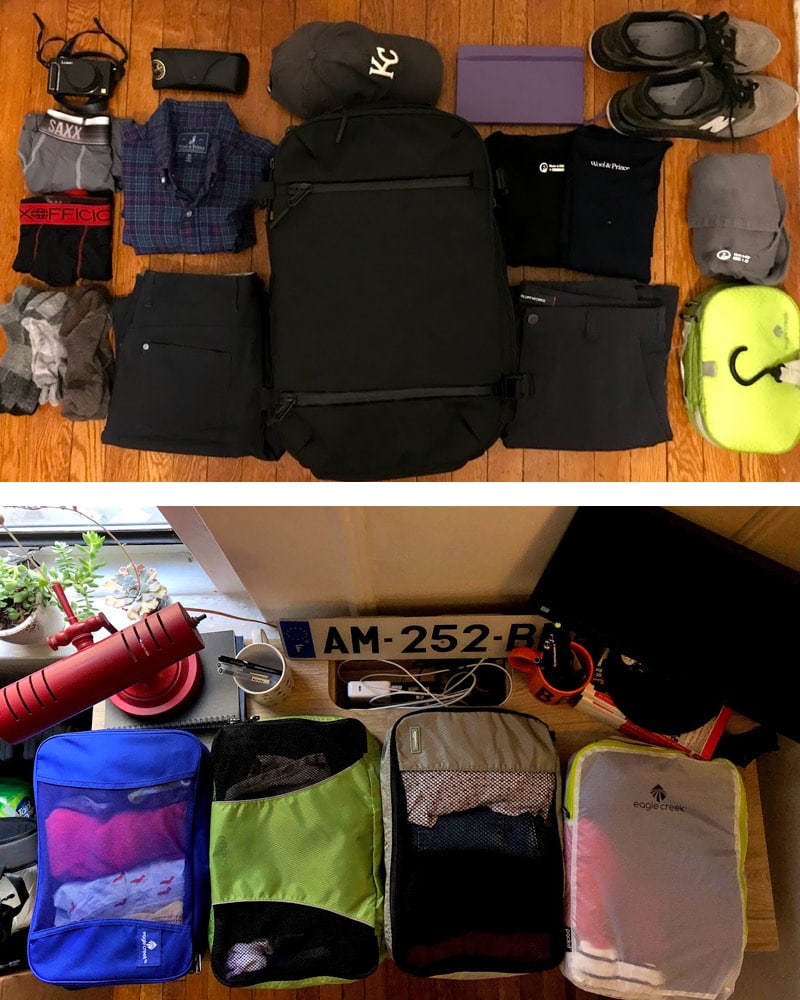
This Europe packing list is very extensive so here is a quick rundown of what you’ll see in this guide. Keep reading to see everything.
Rolling Luggage
- Travel Backpacks
Packing Cubes
Packing folders.
- Toiletry Bags
Travel Underwear
- Travel Socks
- Shoes For Travel
- Shirts & Tops For Travel
- Jeans, Pants, & Bottoms
- Outerwear For Travel
- Winter Clothing
Travel Towel
- Travel Flashlights
- Eyemask & Earplugs
- Water Bottle
- Sleep Sheets
- Travel Laundry
Travel Utensils
- Electric Plug Adapters
Travel Power Strip
- Phone Chargers
Digital Camera
- Travel Hairdryer & Straightener
- Shampoo/Conditioner/Body Wash
- Toothpaste & Toothbrush
- Travel Toilet Paper
- Wet Wipes/Baby Wipes
- Body Powder
- Pepto Tablets
Europe-Friendly Luggage
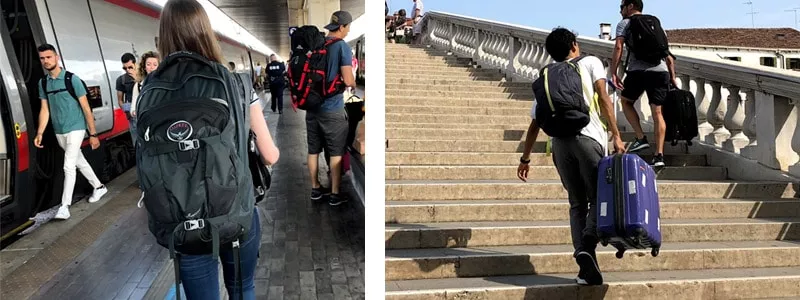
The type of luggage you choose will have a major impact on your travel style.
You essentially have two choices — a wheeled suitcase or a travel backpack . Either option is perfectly fine but both have their positives and negatives (which we’ll cover in this section).
Before I talk about luggage, I want to reiterate the idea of packing light because traveling light makes moving around easier and more enjoyable.
Rolling luggage is the most popular style of luggage for traveling in Europe. It offers a lot of benefits but it’s not always right for everyone.
Rolling Luggage Benefits
- Weight Isn’t a Huge Concern: You don’t have to worry about weight as much since you’re pulling your bag. This can lead to overpacking — which will make carrying your bag up and down staircases and into luggage compartments more difficult.
- No Back Pain: Not everyone can strap on a heavy backpack so rolling luggage is much more ideal in these cases.
- Rugged: A quality suitcase can take a bit more punishment than a backpack because they’re designed to be thrown around a bit.
- Ideal For Door-to-Door Travel: If you plan on taking taxis from your hotel to the airport/train station then traveling with a suitcase makes sense.
Disadvantages of Wheeled Luggage
- Cobblestones: Wheeled luggage is great on flat surfaces but becomes unwieldy on stairs and cobblestone streets.
- Stairs: While hotels might have elevators, most rental apartments and hostels might have quite a few stairs.
- Public Transportation: Not all public transportation in Europe has escalators or elevators. A large suitcase will be unwieldy when you have to lug it up a bunch of stairs. Additionally, public transportation tends to be crowded, so pulling a big suitcase through a mob of people can be difficult.
- Not Hands-Free: You’ll lose the ability to use both hands when you’re wheeling your suitcase around — which will impact the ease of travel.
Features of Quality Rolling Luggage
- Hard-Shell or Soft-Sided: Soft-sided bags tend to hold up better than hard-shell bags and they also fit into overhead bins much easier because they’re more flexible. They can be thrown around without much chance of major damage. Hard-shell bags are normally much lighter than soft bags, but there is a larger chance the bag could crack. However, a hard-shell bag will keep the things inside your bag safer since it has more structure — so a hardshell might be best if you’re traveling with a lot of fragile things.
- Two Sturdy Wheels: Those four-wheeled rolling luggage are great on flat smooth surfaces but get eaten up by Europe’s streets. Look for bags with two sturdy wheels.
- Size: If you’re planning to carry on your luggage then you’ll want to ensure it fits those requirements — especially if you’re traveling on Europe’s size-stingy budget airlines. Not carrying-on? Try limiting yourself to a reasonably sized backpack that you can handle without assistance.
- Color: A non-black bag will help you recognize your bag more quickly at the baggage claim. If you do have a black bag, we suggest using a distinctive luggage tag or luggage strap to help prevent other people from accidentally taking your bag (it happens more often than you think).
Travel Backpacks For Europe
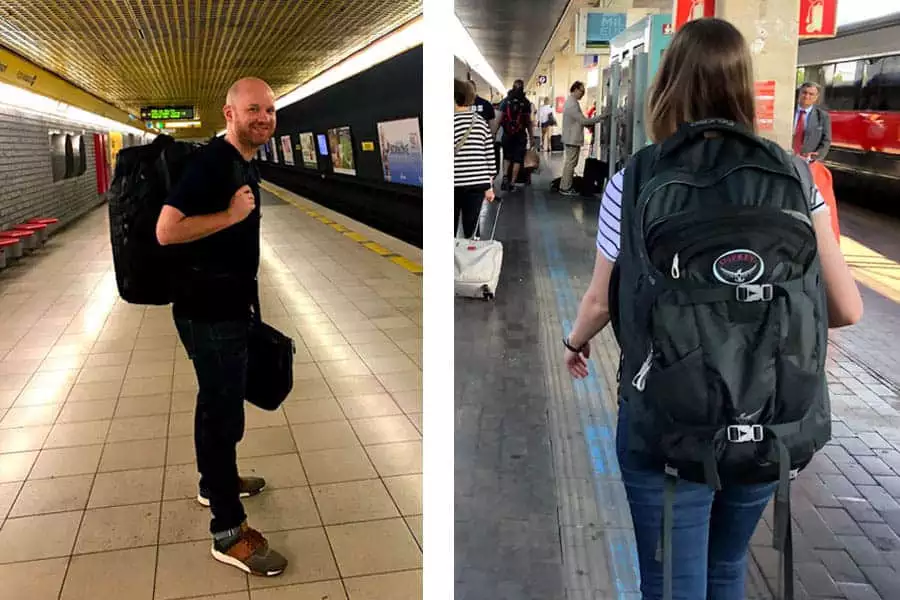
I’m a big fan of travel backpacks and it’s my preferred luggage choice. However, they’re certainly not for everyone so I’ll cover what to consider before buying a travel backpack.
Check out my guide to the Best Travel Backpacks and the Best Carry-On Backpacks .
Benefits of Travel Backpacks
- Mobility: Easily navigate crowded streets and public transportation since all your stuff is on your back.
- Hands-Free Travel: Traveling with two free hands makes your life much easier and more enjoyable.
- Navigate Stairs & Streets: You won’t have to worry about stairs or cobblestone streets with a backpack.
- Less Stress: We find that our stress levels go down when we use a backpack since we don’t have to worry about knowing where our stuff is.
Disadvantages of Travel Backpacks
- Uncomfortable If Overloaded: A travel backpack will be uncomfortable if you overpack.
- Checked Luggage: If you have to check your backpack when flying, you must be cautious because the conveyor belts can sometimes rip off the straps of the backpack You’ll have to take extra precautions when checking your bag (or get a backpack that has stowable straps).
- Must Fit Well: It is important to get a backpack that fits your body well. If not, it can quickly become uncomfortable.
- More Difficult to Pack: Most modern travel backpacks open up like a standard suitcase so they’re easy to pack but some ‘hiking’ style bags only open from the top.
- Back Pain: Even a well-packed can start to cause back pain so it might not be great for people with mobility issues.
Features Of A Great Travel Backpack
I’ve written multiple guides about finding the perfect travel backpack. Here’s my Guide To Choosing The Perfect Travel Backpack and a list of my favorite backpacks traveling Europe .
Recommended Travel Backpacks and Rolling Luggage
Travel Backpacks We Like:
- Osprey Farpoint and the Osprey Fairview
- Osprey Porter
- Tortuga Outbreaker , Setout , and Setout Divide .
Rolling Luggage We Like:
- Osprey Transporter , Osprey Ozone , and Osprey Sojourn
- TLS Mother Lode Wheeled Duffle
- Eagle Creek Expanse Drop Bottom Wheeled Duffel 32
Where To Buy Travel Backpacks and Wheeled Luggage
There are a lot of places to purchase luggage and travel backpacks. Here are a few of our favorites:
- Amazon — Amazon has everything.
- Zappos — Zappos doesn’t always have every brand/model of luggage but they have free shipping and super easy free returns in case your bag doesn’t fit you correctly.
- REI — REI has a decent selection of luggage and their selection of travel backpacks is very solid.
Get Organized For Traveling Europe
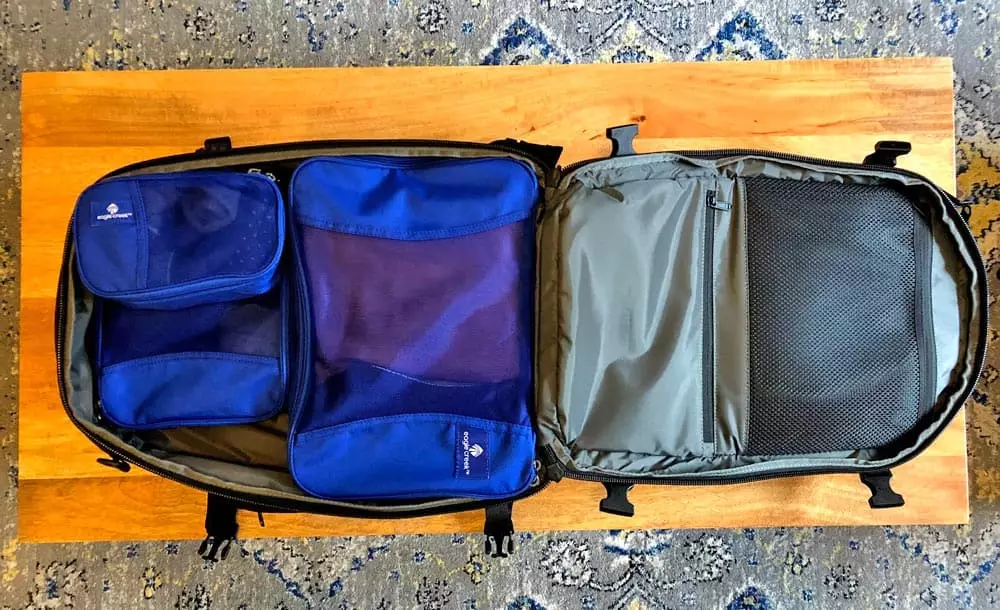
Life gets a little more complicated when you’re living out of a bag but worry not… I’m here to help.
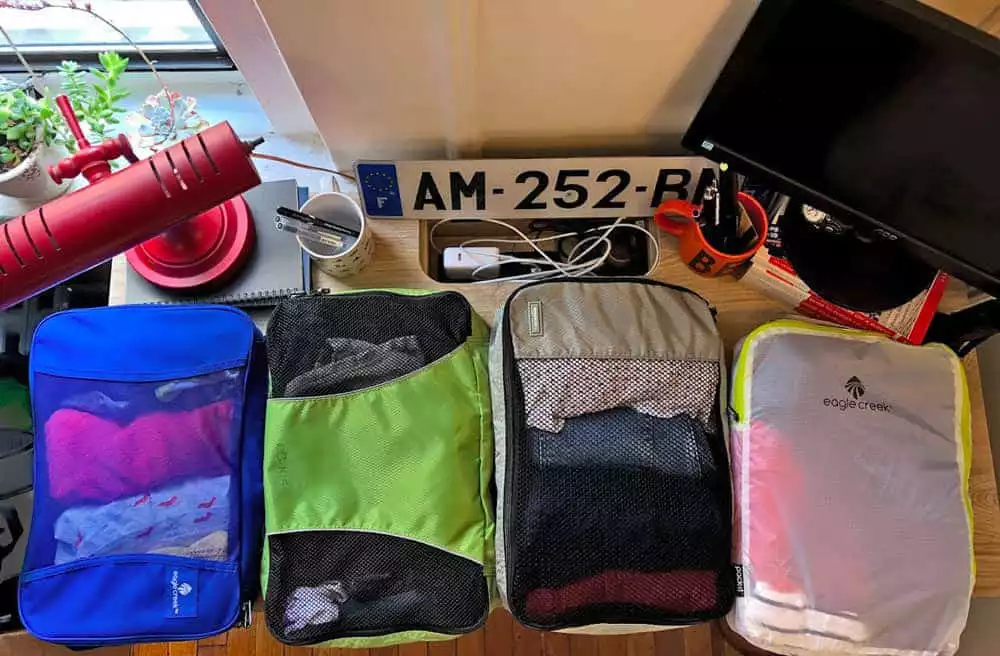
Behold the magical packing cubes.
They may not look like much but these simple travel accessories make packing so much easier.
The idea behind packing cubes is simple — you divide your clothing up between different cubes (socks in one cube, underwear in another cube, etc.). This keeps all your clothes compressed and organized.
This way you can quickly grab what you need. And these make repacking all your stuff easy as well since you know where everything goes.
As an added bonus, packing cubes can also help reduce wrinkles by preventing your clothing from shifting around in your bag. And the compression lets you fit more stuff into your luggage.
There are a ton of companies that make packing cubes but here are a few of our favorites:
- Eagle Creek Pack-It Cubes (best overall)
- eBags Packing Cubes (close second place)
- Eagle Creek Spectre Tech Packing Cubes (ultra-lightweight favorite)
- AmazonBasics Packing Cubes (best budget option)
Learn More: Read a more in-depth review of the best packing cubes .
We don’t personally use packing folders but they’re a popular travel accessory. Basically, packing folders are designed for larger items like dresses, button-up shirts, and pants.
We recommend Eagle Creek Packing Folders — which cost anywhere from $16-$25 depending on size (via Amazon ).
Hanging Toiletry Bag
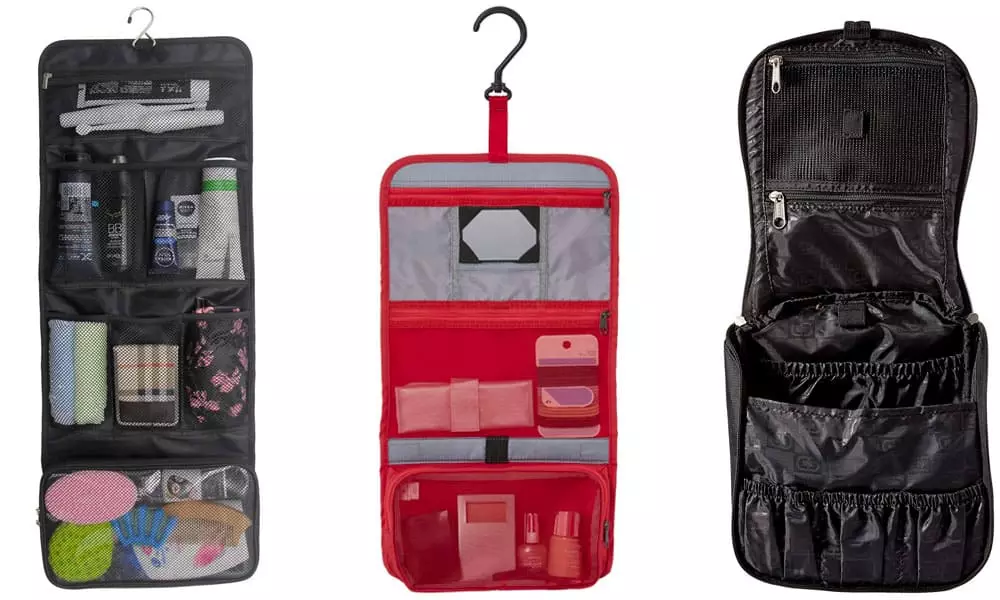
A toiletry bag is essential for keeping all your toiletries contained.
Do yourself a favor and buy a toiletry bag with a hook so it can be hung up since most European bathrooms have little/no counter space. There are a bunch of different bags available on Amazon but here are a few popular travel toiletry bags:
- The Ogio Doppler Kit (via Amazon ).
- The Lewis N Clark Hanging Toiletry Case (via Amazon ).
- Eagle Creek Toiletry Kits (via Amazon ).
- TANTO Toiletry Bag (via Amazon )
Other Helpful Organization Aides
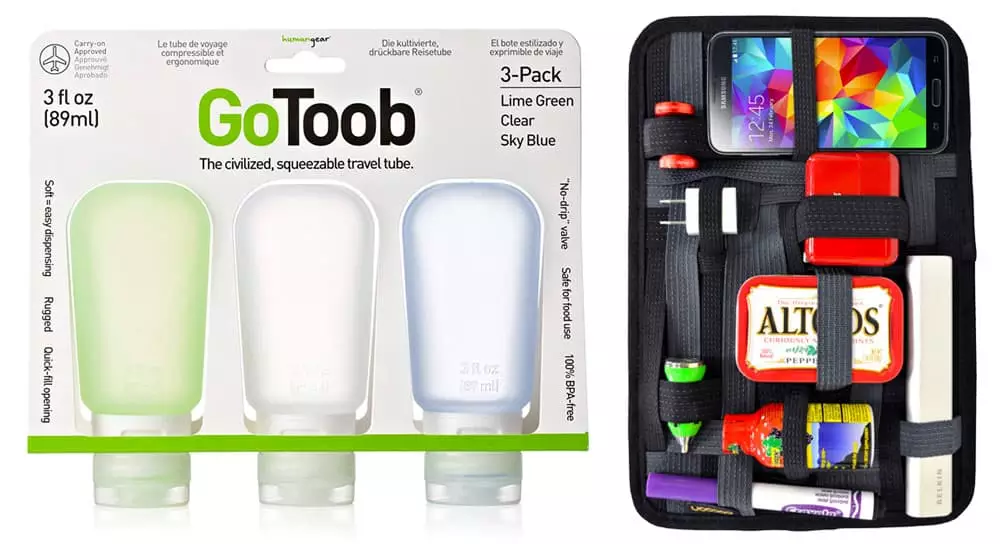
- Humangear GoToob Travel Bottles are probably the best travel bottles for shampoo and other liquids/gels. They are a little expensive ($17-$25 for a set) but they don’t leak. There are multiple sizes so check Amazon to see what works best for your needs.
- The Grid-It Organizer is a handy way to keep all those electronics and wires in order. They cost about $15-$20 and come in different sizes (via Amazon ).
- A compression stuff sack is nice for keeping dirty clothes away from your clean clothes, and it serves as a good bag for doing laundry. Multiple companies make them and they run about $10-$40 depending on the size (via Amazon ).
- Ziploc bags come in handy for storing multiple things and keeping liquids from spilling over all your stuff (I like to keep my passport in a plastic bag for safekeeping). Ziploc makes multiple sizes of bags, so I like to pack multiple bags just in case I ever need one. There is even a three-gallon bag that works well for storing an extra pair of shoes so you don’t get your clothes dirty.
Travel Clothing Packing List
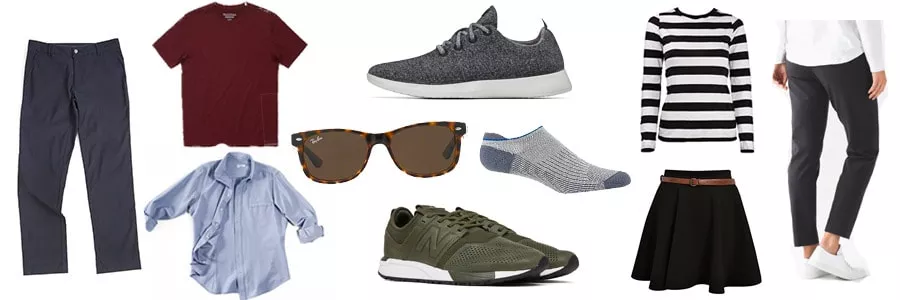
The majority of the weight in your luggage will come from clothing so it’s important to limit your clothes if you want to travel light. Of course, this is easier said than done.
In this section, we’ll help you choose which types of clothes to pack, some general tips for packing light, and packing tips for all seasons (summer, fall, winter, and spring).
Efficient Clothing Packing Tips
- While it might be a bit boring, it is usually easiest to pack mostly dark colors since they’re the easiest to coordinate. Additionally, dark colors do a better job of hiding stains than light colors.
- Avoid Single Wear Clothing: Don’t bring anything that you’ll only wear once because it’s not worth lugging around for your entire trip. Choose pieces that can be worn for a variety of occasions.
- High Maintenance is No Good: You’re going to be wearing your clothes a lot so you want things that can take a bit of punishment and is machine-washable
- Accessorize: You’ll probably get tired of wearing the same thing all the time so throwing in a few accessories (hats, scarves, sunglasses, etc.) is a good way to change up your outfit.
- Buy Clothes as You Travel: We know a lot of travelers who only bring the bare minimum of clothing and then buy new stuff as needed.
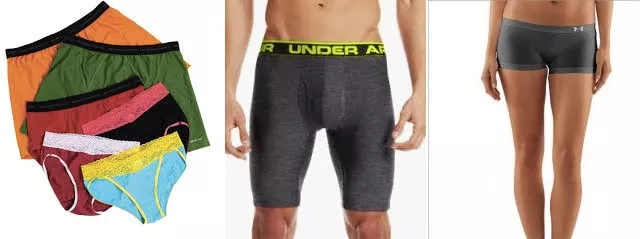
I’m a big fan of travel underwear — mainly because you can easily wash them in the sink and they’ll dry in a few hours. They’re also designed to be more comfortable when you’re traveling all day. When you’re searching for travel underwear, look for the following things:
- Furthermore, cotton can take well over 24 hours to air dry — which makes it a pretty poor choice.
- Cotton does the exact opposite — it retains sweat and it leads to that “swampy” feeling we’ve all experienced.
- Odor Control: The best travel underwear helps manage odors. Cheaper synthetic underwear will start to smell pretty quickly but the higher-quality synthetic fabrics will do a better job. We’ve found that fine Merino wool does the best job of stopping odors.
The number of pairs you bring is a personal preference. We don’t like washing underwear every night so we bring five or six pairs — but you could conceivably get away with two pairs (if you don’t mind washing often
Recommended Women’s Travel Underwear
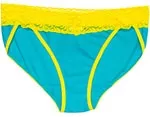
The most popular travel underwear is made by ExOfficio — they get a ton of great reviews on Amazon . They are ideal for travel because they’re breathable, odor-repellant, and dry in just a few hours. They do tend to be more expensive than normal underwear but most experienced travelers swear by them.
ExOfficio has a fairly wide range of underwear styles available and they’re priced anywhere from $8-$20/pair (depending on style and color):
- ExOfficio Thong
- ExOfficio Lacy Low Rise Bikini
Patagonia also makes some really nice underwear that is great for travel. They get good reviews for being soft and comfortable. The Patagonia underwear won’t dry quite as quickly as ExOfficios but they still dry quickly. Patagonia stuff is always high quality but it also comes at a price — these normally cost about $20/pair.
- Active Hipster Briefs
- Barely Hipster Briefs
- Active Boy Shorts
Bring two or three comfortable bras . You may also want to bring a quality sports bra for those long travel days.
Recommended Men’s Travel Underwear
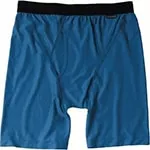
ExOfficio Give-N-Go underwear is the most popular underwear for travelers ( read our personal review here ) and their boxer briefs have over 5000 reviews on Amazon .
I wear mine even when I’m not traveling because they are pretty damn comfortable. ExOfficios breathe well, inhibit odor, and air dry super quickly. ExOfficio offers a few different styles and they cost between $15-$25/pair ( via Amazon ). They’ve also just released their new Give-N-Go Sport boxer briefs that look really nice. They cost $30 ( via Amazon ).
Under Armour also makes HeatGear underwear that performs similarly to the ExOfficios. They cost around $20/pair ( via Amazon ).
If you prefer wearing natural fibers, we suggest Merino wool. The Smartwool underwear is nice and will keep you cool and dry. They usually run about $48 so they are on the expensive side. We also have a pair of boxer briefs from Wool & Prince that we really like.
Socks For Travel
It might not be exciting but a quality pair of socks will make a world of difference when you’re traveling. I’m a huge fan of socks made from fine Merino wool.
Lightweight merino wool socks are great in the summer because they’ll actually keep your feet cool and dry. Heavier-weight socks are good for traveling in the winter because they’ll keep your feet warm and dry.
Quality socks are expensive but they’ll last for a long time if you take care of them. Synthetic/wool blends also work well.
Ideal Travel Socks:
- Wick Moisture: Your feet will sweat but a good pair of socks will draw moisture away from your feet. Keeping your feet dry will help eliminate odor and will also help stop blisters.
- Dry Fast: A lot of good wool and synthetic socks can be washed in the sink and will dry overnight (about 6-8 hours).
- Eliminate Odor: High-quality wool is naturally odor-resistant. Some synthetic socks have special anti-bacterial features that help eliminate odor but they’re not quite as effective as wool. Synthetic-wool blends also work well.
- Aren’t Cotton: Cotton is a terrible choice when it comes to socks. Cotton traps moisture and dries very slowly — this will lead to blisters and smelly feet. Additionally, cotton socks take a long time to air dry (24+ hours) so they’re difficult to wash in the sink.
A good pair of socks can be worn 2-3 times before they start to stink (although you’ll want to rotate the days you wear each pair so they can “air out”). For a more in-depth article about the wonderful world of socks, check out our article about the best travel socks .
Recommended Travel Sock Brands
- Darn Tough Socks: Darn Tough Socks are known for being super durable — in fact, they’re guaranteed for life. Plus they’re made in Vermont.
Shoes For Traveling Europe
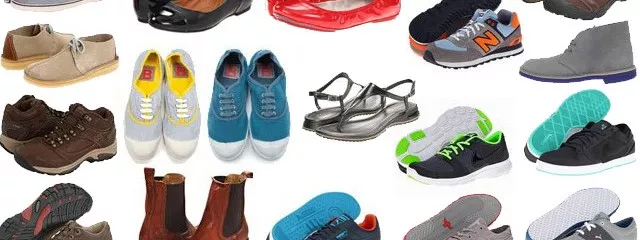
Wear. Comfortable. Shoes.
The most important packing tip is to wear sturdy, comfortable shoes when traveling Europe.
Trust me — you’re going to be on your feet way more than usual and your feet are going to take a beating. That’s why you should put comfort over fashion — luckily there are plenty of fashionable and comfortable shoes on the market.
So let’s look at a few tips for ensuring your feet stay happy:
- Here’s a list of what I think are the best travel shoes if you want my top picks.
- Have bad feet? Consider adding a pair of insoles to your shoes. Superfeet insoles get a lot of great reviews but there are a lot of other brands available.
- Consider Your Environment: Match your footwear to your environment. For example, you may want to consider a waterproof shoe if you’re traveling to rainy/snowy locations. Conversely, you probably don’t need heavy-duty mountain-hiking boots if you’re spending all your time in cities.
- Break In Your Shoes Early: Even comfortable shoes can take a little while to get broken in. That’s why I recommend wearing your shoes for a few weeks before your trip so you know they won’t give you blisters or foot pain.
- For Winter Travel : I recommend a lightweight pair of waterproof boots for poor weather (snow, rain, cold, etc.) and sneakers for the nicer days. Luckily, boots can often be dressed up a bit they still look nice enough at restaurants, etc. Check out our guides for the Best Waterproof Boots for Men and Best Waterproof Boots for Women for some fashionable and functional options.
- For Hostel Travelers: Don’t forget a cheap pair of sandals for the showers…
Learn More: Take a look at our guides to the Best Travel Shoes For Women and the Best Travel Shoes For Men —both articles go into much more detail about what you should look for in a pair of travel shoes as well as a selection of footwear perfect for travel.
Shirts and Tops For Travel
Now let’s dive into shirts and tops. To help keep things simple, I’ve split this section up into a women’s section and a men’s section.
Treat these sections as general guidelines on what kind of shirts/tops to pack — don’t forget the general rules of durable fabrics, dark colors to hide stains and wrinkles, and choosing items that can be easily paired with other items.
By the way, if you’re an ultralight traveler, you’ll probably want to pack less than what is listed below.
Tops For Women Packing List
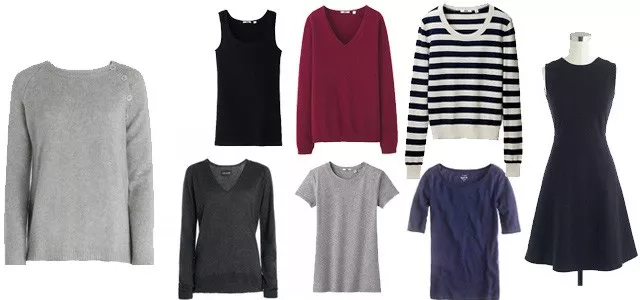
- Shirts (3 or 4): A mixture of short and long sleeve tops is ideal. Remember to dress for the weather, but also realize that it can get cool at night during the summer. Bring a mixture of casual and dressy tops so you can mix and match.
- Light Sweater/Cardigan: Even during the summer, temperatures don’t always get really hot (although they can). In Paris, the average high temperature in June is around 72 degrees and it can drop into the low 60s at night. That’s why it is a good idea to bring a light sweater or a cardigan.
- Dresses (1 or 2): Look for a versatile lightweight dress that can be worn casually or dressed up.
- T-shirts and Tank Tops: Sometimes you just want to wear a simple t-shirt so be sure to bring a few. Just pick whatever you’re comfortable wearing. The ExOfficio Lacy Shelf Bra Cami is a nice undershirt or sleep shirt — it is super lightweight, breathable, and air-dries overnight if you want to wash hand wash it.
Women’s Travel Clothing Brands
- Athleta : Athleta has really stepped up their travel clothing and they have a lot of solid options.
- Lululemon : Lululemon has a number of good travel clothing options.
- Anatomie : Anatomie has a bunch of higher-end clothing that looks really nice
Tops for Men Packing List

- Bluffworks Meridian shirt is a super-tough wrinkle-free travel shirt that can be worn casually or dressed up. It retails for $125. Available via Bluffworks
- Wool & Prince sells a number of nice 100% merino wool shirts. Their long-sleeve button-ups retail for $128 and their short-sleeve sell for $98.
- Bluffworks recently released its performance t-shirt which sells for $45.
- Wool & Prince sells super nice 100% merino wool t-shirts ($68) and polos ($98).
- Uniqlo makes a number of budget t-shirt options that we always dig. Their inventory changes often but they always have something.
- Sweaters (1 or 2): A lightweight sweater is nice if you want to dress up a little or if the temperature drops when the sun goes down. Layering a sweater over a button-up shirt looks nice (so make sure all your button-ups match your sweater). Of course, if you’re traveling in the summer, you probably don’t need to pack a sweater but having one or two in the winter is nice.
Jeans, Pants, and Bottoms Packing Guide
I usually only pack two pairs of pants — mainly because they take up a lot of space in your luggage. Also, pants are one of those things that you don’t really need to wash all that often so there’s no real need to pack multiple pairs.
Pants & Bottoms for Women
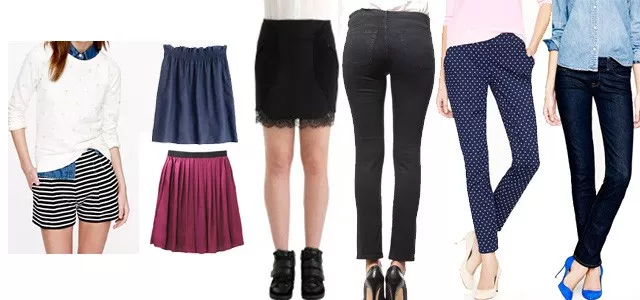
- For Cold Weather: Throw on a pair of lightweight micro-wool long underwear (i.e. a base layer) under your jeans — SmartWool and Icebreaker are two great brands.
- Capri Pants: Capri pants are a nice option in warm weather that still looks nice but are also functional.
- Skirts: Skirts are dressier than shorts and they take up essentially no space in your luggage. Feel free to bring a mixture of shorter and longer skirts.
- Shorts: Shorts are starting to become more popular in Europe so, contrary to popular belief, you won’t feel out of place wearing them — especially in the south of Europe. That said, we recommend bringing a fashionable and well-fitting pair as opposed to ‘athletic’ shorts.
- Athleta : Athleta has multiple options for pants that work well for travel.
- Lululemon : Lululemon has a few jogger pants and other options that would work well for travel.
- Anatomie : Anatomie has a bunch of higher-end travel items.
- Uniqlo : Uniqlo always has a few pairs of travel pants that are friendly on your bank account.
Pants & Bottoms for Men

- Jeans: A pair of dark jeans are essential for traveling in Europe. They look great during the day and they can be dressed up for nighttime. Additionally, jeans can go weeks without needing to be washed.
- Bluffworks makes a series of lightweight, durable, and quick-drying travel pants that also look like regular pants. Pairs range from $98-$140. They also make some solid Travel Jeans for $125.
- AT Slim Rivet Pant from Western Rise and stretchy, stain-proof, and incredibly durable. They retail for $129.
- The Brion Pant from Prana is one of the more fashionable “outdoor” pants and they sell for $79.
- Shorts: In the past, you wouldn’t find many adult men wearing shorts in Europe but this is changing very quickly. Stick to well-fitting fashionable shorts but stay away from things like athletic shorts or the classic “touristy” khaki shorts.
- Cold Weather: When the temperature drops, it can be nice to have a lightweight base layer to go under your pants. SmartWool and Icebreaker make some of our favorite high-quality base layers.
Outerwear Guide
It’s a good idea to prepare for the elements so you’ll want to look into a few options — especially in the non-summer months.
- The Marmot Precip is a great lightweight rain jacket that is also pretty affordable.
- Check out REI.com for a wide range of rain jackets.
- Our top choice is the Patagonia Better Sweater Fleece ( Men’s and Women’s ) but there are plenty of great options at REI or Amazon .
- We use Patagonia Nano Puff but for more budget-friendly options check out Uniqlo .
Clothing Accessories
Here are a few handy accessories to round out your outfit.
- Scarf: Scarves are a handy item that adds style and comfort on cooler days. You can always buy a few as you travel because they make great souvenirs.
- Sunglasses: Sunglasses are a must-have because they’re both practical and fashionable. After living in Europe, we noticed that Ray-Ban Wayfarer sunglasses were a top choice of the truly fashionable but you might want a cheap pair if you’re on the move all the time.
Europe Winter Weather Packing Guides
Winter travel in Europe poses a few extra packing challenges to consider so we’ve written a few handy guides to help guide you on your way.
- Europe Winter Travel Packing List
- How To Dress For Winter in Europe
- Best Waterproof Boots for Men
- Best Waterproof Boots for Women
Travel Accessories Packing List
We’ve put together a list of our favorite travel accessories to help make traveling in Europe easier and more enjoyable.
SIM CARD FOR CHEAP MOBILE DATA
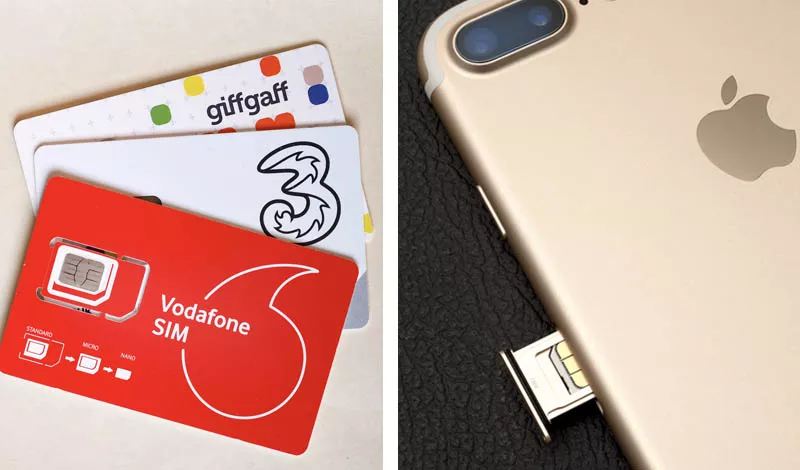
The cheapest way to get mobile data for your phone is by using a European SIM card — this is much cheaper than using your home carrier’s International Mobile Data plan.
You can read about my guide to using smartphones and data plans in Europe but I recommend buying your SIM card from SimOptions.com or Holafly .
Travel Daypack
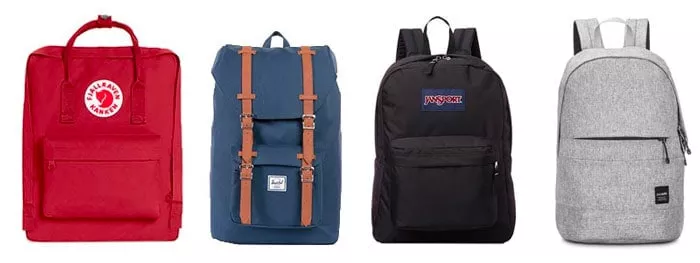
A small backpack is essential for carrying around your day-to-day stuff (camera, souvenirs, rain jacket, guidebooks, etc.) as you’re sightseeing. We recommend a small daypack that can be easily packed away in your luggage and that won’t strain your back as you wear it all day. Here’s a list of the best daypacks . — we’ve also included a few anti-theft backpacks which are handy if you’re visiting areas known for pickpockets .
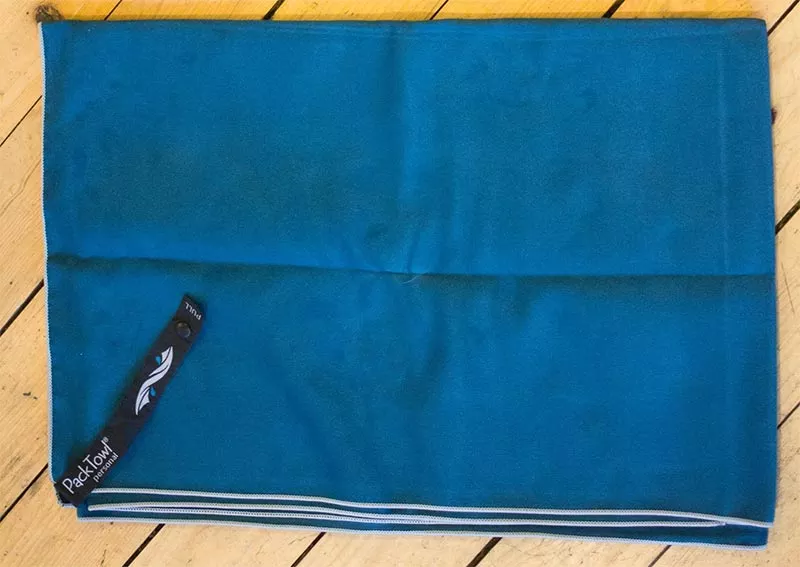
Packing a quick-drying travel towel will come in handy if you’re staying somewhere like a hostel that doesn’t provide towels. That’s because traditional cotton towels, in addition to being very bulky, take hours to dry — which will lead to a musty smell if you pack it before it is dry. Travel towels work well because they are compact but can still absorb plenty of liquid as they dry overnight.
Note: Travel towels are often much smaller than normal towels. We suggest buying the large or XL size—especially if you have long hair (or buy two).
There are a ton of travel towels on the market but these get great reviews:
- PackTowl Personal Microfiber Towel
- Biospired Footprint Lightweight Microsuede Towel
Keychain Flashlight

Most people use their phone as a flashlight light but a small keychain flashlight is still a nice accessory — especially in dark dorms and city streets.
We love the Streamlight 73001 Nano Light Miniature Keychain LED Flashlight because it’s super small (it fits on a keychain) but it provides a ton of light. Streamlight also has a ton of other great-quality pen lights if want other compact light options
Padlock & Retractable Cable Lock

If you’re staying in a hostel, you’ll need a lock so you can secure your stuff in the lockers. We recommend the Master Lock Set-Your-Own-Combination Padlock because it allows you to create your own combo so it’s easier to remember.
Retractable cable locks are nice for securing your bag to your bunk or a luggage rack. They will deter a thief from running by and snatching your bag.
Earplugs & Eye Mask
An eye mask is nice for trains/planes/buses or if you stay in hostels (some jerk will turn the lights on at 3 am). Additionally, you’ll be glad you brought earplugs if you stay in hostels because you’ll eventually share a room with someone who snores. These Mack’s Pillow Soft Silicone Earplugs are really nice for sleeping.

Throw in a small notebook like the Moleskine Notebook , Field Notes , or Rhodia notebooks to make notes of things as you travel. We write down directions, phone numbers, addresses, restaurants, spending, etc. At the end of your trip, your notebook will end up being a nice little souvenir.
Water Bottle or Flexible Water Bottle

Stay hydrated with a water bottle. A basic water bottle is perfectly fine but this flexible water bottle by Platypus Soft Bottle is a great choice because it can be rolled up when empty.
Travel Sleep Sheet
Are your hostel sheets clean… who knows? If you don’t want to take the chance, think about packing a sleep sheet/sleep sack. A cotton Sleep Sheet is cheap but bulky. Silk Sleep Sacks cost but they’re a lot lighter, less bulky, and the silky feeling is nice.

- Sink Stopper: A cheap Travel Sink Stopper is necessary for sink laundry.
- Travel Laundry Soap: Woolite Travel Laundry Soap or Travelon Laundry Soap Sheets are perfect to travel laundry.
- Flexible Travel Clothesline: The best way to dry your clothes is with rubber braided clothesline . Plus, braided clotheslines don’t need clothespins.
- Stain Remover: Toss in a Tide To Go Stain Remover Pens or individually wrapped Shout Wipes for any stains.
Patch up stuff with duct tape. A whole roll because it is too bulky so just wrap some around a pencil. Or buy some travel duct tape .
Digital Luggage Scale
Make sure your bag isn’t too heavy with a digital luggage scale .
Photocopies Of Important Documents
Make copies (physical and electronic) of your passport and other important documents. We email them to ourselves or save them to Google Docs.
Ziploc Bags (Multiple Sizes)
Plastic bags are a great way to store your dirty or wet socks/underwear so they don’t get mixed with your clean clothes. We’ll also put our liquids in a sealable bag in case of a leak. The large 3 gallon bags are nice for storing shoes so you don’t get your clothes dirty.
One of the best ways to avoid becoming a pickpocketing victim is to wear a money belt ( learn more about avoiding pickpockets here ). Personally, we don’t really like money belts because they’re kind of annoying to wear but a lot of people always wear one — it comes down to personal preference.
Collapsible Umbrella
A travel umbrella is optional if you’re traveling in the summer. However, the fall, winter, and spring tend to be rainy, so you might want to bring one along.

We eat a lot of meals from the grocery store so we always bring a set of Plastic Travel Utensils . If you really want to go all out, you should check out this sweet titanium spork .
Toothbrush Cover

Keep your toothbrush germ-free with the Steripod Clip-on Toothbrush Sanitizer cover. It protects the brush and sanitizes it using voodoo science. Yeah, science! Or you can just get a normal toothbrush cover if that’s how you roll.
Lint Roller
A lint roller is an easy way to help keep your clothes looking presentable.
Guide Books and Phrase Books
Despite loving internet resources, we are still huge fans of using printed guidebooks to research wherever visit. Learn more about our favorite travel guidebooks & websites .
A small phrasebook can also come in handy if you’re not familiar with the local language (but most people in big cities will speak a little English).
Electronics Packing List
We travel with more electronics than ever so here’s a list of things you might want to bring along.
IMPORTANT: North America and Europe use different voltages (120v vs 220v) for their electronics. So what does that mean for you? For high-end electronics like phones, cameras, laptops, iPads, etc… it doesn’t matter. All you need is a plug adaptor because these electronics are all designed to work at multiple voltages. However, electronics with heating elements and motors like hairdryers, curlers, straightening irons, hair clippers, etc. aren’t designed for multiple voltages so they’ll fry if you use them in Europe. Read our guide to traveling with electronics for more in-depth advice about using electronic devices while traveling.
Outlet Plug Adapters

You’ll need a couple of outlet plug adapters for all your electronics. Most of Europe uses the same plug but the UK uses a different configuration. There are dozens of adaptors out there but this affordable plug adaptor set from Ceptics will work fine. They also sell UK, Ireland, and Switzerland-specific versions if you’re traveling there.

Many hostels and hotels may only have one or two power outlets per room. That’s why we often pack a travel power strip to power our various gadgets. The Belkin Travel Power Strip with USB ports is a well-rated option but there are plenty of other travel power strips on Amaz on .
Portable Phone Charger
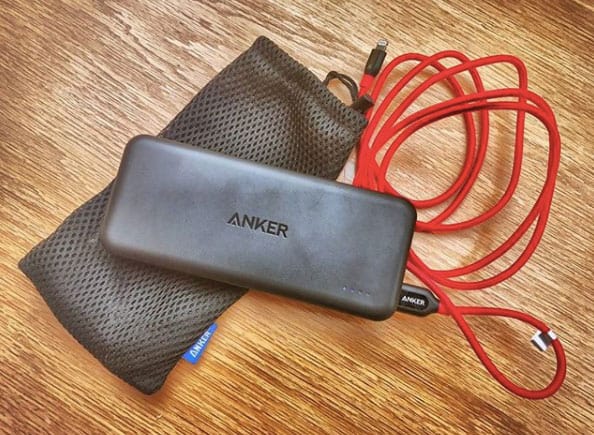
If you’re anything like us then you’re going to use your phone a ton when you’re traveling so you’re going to drain your battery before noon. That’s why a portable phone charger is a must-have travel item. We use the Anker PowerCore 10000 because it’s the size of a deck of cards and is affordable.
Dual Voltage Travel Hairdryer
Standard North American hairdryers and straighteners won’t work in Europe — even if you use a voltage adapter. That’s because Europe uses a higher voltage than North America. That’s why you need a dual-voltage hair dryer. The Revlon 1875W Compact Travel Hair Dryer is a top choice for travelers because it is powerful, lightweight, and foldable.
Don’t forget about dual voltage straightening irons and dual voltage curling irons .
We use our iPhones for a majority of our travel photography but you’ll want a quality digital camera if you want nicer photos. We’ve already written an in-depth article about choosing the best digital camera for trave l. Don’t forget the extras:
- Extra Memory Cards: Pack a few extra memory cards because you don’t want to run out of storage space — it’s better to have too much than not enough. And memory cards are cheap .
- A portable external hard drive is great for backing up all your photos. Another great option is to upload all your photos to cloud storage.
- Google Drive is free cloud storage and it gives you 15GB of space. We pay for their premium version to get even more space — especially since we have it synced with Google Photos. The main problem with cloud storage is not having reliable internet access when you travel.
- Extra Battery: I always carry an extra battery. Generic versions are cheap on Amazon (you’ll have to search for the specific battery that your camera uses).
Tablet or Laptop
We love traveling with our iPads — they’re the perfect travel computer. So, unless you really need the full functionality of a laptop, we suggest sticking with an iPad.
Smart Phone
Everyone has a smartphone these days. Here’s our guide to the best travel apps if you’re curious to know our favorite apps.
Be sure to read our guide to using Data Plans Abroad
It’s nice to listen to tunes as you travel. Additionally, there are a lot of downloadable audio guides for cities and museums — which are great ways to learn more about the places you’re visiting. We absolutely love our Apple Airpods (not having wires is so amazing). But we still throw in a cheap pair of headphones for flights. We’ve written more about our favorite travel headphones .
Travel Toiletries for Europe

We suggest minimizing your toiletries since liquids are heavy and you can purchase anything you need once in Europe. That said, here is a list of things you might want:
- Shampoo/Conditioner/Body Wash: Pour liquids into these small GoToob travel-sized bottles because they won’t leak.
- Toothpaste & Toothbrush: We travel with a normal toothbrush but add a toothbrush cover . We did find that dental floss was much more expensive in Europe so bring some from home.
- Non-Aerosol Dry Shampoo: Dry shampoo is amazing for getting your hair ready when you don’t have time to jump in the shower.
- Shaving Stuff (Razors & Cream): Razors are more expensive in Europe.
- Deodorant: For whatever reason, we find that deodorant in Europe didn’t seem to work as well — maybe it was all in my head.
- Chapstick w/Sunscreen : Protect your lips.
- Contact Lenses/Solution/Glasses: Contact solution can be a pain to purchase since it’s often only sold in pharmacies.
- Lipstick (or something similar): Parisian women seem to never leave the house without sexy lipstick. You can also use lipstick as blush.
- BB Cream: BB Cream is a great ‘all-in-one’ product. It’s a moisturizer that contains sunscreen and provides light coverage as a basic foundation — it also evens skin tone.
- Mascara: Mascara should be changed every three months, so this is a great excuse to buy a new bottle.
- Cream Blush: You really don’t want to have makeup brushes in your bag, so a cream blush is a great option.
- Condoms: You don’t want some souvenirs so we suggest buying some now. Amazon seems to have the best price/selection of condoms .
- Travel Fabric Freshener: Keep away the funk with travel-sized Febreze To Go.
- Travel Toilet Paper: Travel toilet paper is never a bad thing to have in an emergency.
- Wet Wipes/Baby Wipes: Cottonelle Fresh Flushable Wipes can be a lifesaver and so they’re super easy to pack.
- Hand Sanitizer: Who knows what kind of things you’ll be touching.
- Body Powder: A lot of walking can equal chafing — especially in hot weather. Anti Monkey Butt is great for those hot days.
- Foot Cream: Take care of your feet because you’ll be walking a lot. O’Keeffe’s Healthy Feet Cream will keep your feet from becoming rough and cracked.
- Pepto Tablets: Traveling can take a toll on your stomach. Pepto-Bismol tablets are super easy to throw in your bag.
- Band-Aids: They’re nice to have on hand. A lot of people will develop blisters on their feet so we recommend Band-Aids for feet .
- Pain Medicine: Over-the-counter pain medicine is normally only sold in pharmacies so it can somethings be hard to find after-hours.
- Prescription Drugs: Ensure you have enough medicine to cover your trip since getting refills can be difficult.
Travel Insurance
We recommend picking up some travel insurance — which will help cover your stuff, flights, hotel, train tickets, rail passes, medical emergencies, and more. World Nomads is our top choice but you can check out our guide to buying travel insurance .
Where to Buy Travel Gear
- Amazon : Our top choice for buying gear is Amazon because they seem to have the best selection and prices.
- Zappos : Zappos has a solid selection of travel gear. Their prices are sometimes a bit higher than other stores, but their free super-fast shipping and dead-simple returns are often worth the extra cost.
- REI : One is the largest outdoor retailer so they have a nice selection of backpacks and clothing.
- Recent Posts
- The Best Travel Backpacks | In-Depth Buyer’s Guide & Backpack Reviews - April 28, 2024
- Best Prepaid UK eSIM | Data Plan Buyer’s Guide - April 21, 2024
- How to Avoid Pickpockets in Europe — Tips for Outsmarting the Thieves - April 19, 2024

No Funny Business
The Savvy Backpacker is reader-supported. That means when you buy products/services through links on the site, I may earn an affiliate commission—it doesn’t cost you anything extra and it helps support the site.
Thanks For Reading! — James
Questions? Learn more about our Strict Advertising Policy and How To Support Us .
Related Reads
The best travel backpacks | in-depth buyer’s guide & backpack reviews.
A list of my favorite travel backpacks for every travel style.
Backpacking Europe Packing List — My Europe Travel Packing Guide
A comprehensive packing list and advice for budget backpacking and ultralight travel in Europe — including electronics, clothing, toiletries & accessories.
Helpful Travel Tips & Articles , Packing
Fashion Advice: How to Avoid Looking Like An American Tourist In Europe
Fashion advice to help you look like a local when visiting Europe.
Packing , Product Reviews
Best Travel Shoes — Fashionable & Comfortable Shoes for Traveling
The ultimate guide to the best travel shoes that are both stylish and comfortable.
City Guides
Choosing travel insurance, travel packing lists, budget travel newsletter.
The best budget travel tips sent straight to your inbox.
Join My Journey
Europe travel tips, advertising & privacy policies.
TheSavvyBackpacker.com is a participant in the Amazon Services LLC Associates Program, an affiliate advertising program designed to provide a means for sites to earn advertising fees by advertising and linking to amazon.com.
© 2010 - 2024 The Savvy Backpacker
Website Design by FHOKE

The Complete 2-Week Europe Packing List
Last Updated on November 15, 2023
by Maggie Turansky
Disclaimer: This article contains affiliate links. That means if you click a link and make a purchase, we may make a small commission. As an Amazon Associate we earn from qualifying purchases. For more information, see our privacy policy.

Putting together a 2-week Europe packing list can prove incredibly difficult regardless if it’s your first trip to the continent or if you are a seasoned traveller.
Especially if you’re trying to travel light and minimalistically, prioritising things for your trip to Europe can be a bit tricky. We have travelled extensively all over Europe and have refined this ultimate packing list in order to ensure that you have everything you need, but also not too much!
So if you’re after the perfect packing list for Europe, then look no further. We’re here to make sure that you’re perfectly well-equipped for your trip without bringing one item too many in your limited space!
Table of Contents
Europe Packing Tips
Before I jump right into what you actually need to pack for Europe, we do need to discuss a few things in order to ensure that you are completely prepared to leave on your trip to Europe.
One of the most important things to be aware of is the season where you’re travelling, along with the region. Europe is vast with an array of varied climates and what you need to bring to be prepared largely depends on where and when you are visiting.
What you eventually end up taking with you really inevitably comes down to if you’re visiting Europe in winter or summer, northern or southern Europe.
Another thing to keep in mind when you’re planning out a packing list for visiting Europe is just how much you plan to bring with you.
It can be really hard to know what you’ll need or use on your trip, especially if you haven’t travelled much in Europe before. However, it is always a great idea to try to limit the amount of stuff you cart around with you.
Packing light can be a lot more pleasant in almost every aspect of travelling, from not having to worry about the weight limits on airlines or hauling your bags up stairs, through train stations and luggage racks.
Packing light also has the added benefit of making your things a lot easier to pack up and move when you move destination. It is unlikely that you will plan to stay in just one location on your trip and you don’t want to have to unpack and repack a bunch of different things every few days – not only is this simply a pain, it can also be very stressful.
The packing list below is quite minimalist, however, in times of travelling for similar-length trips to Europe, I’ve found that it is beyond sufficient.
When it comes to selecting items of clothing, especially, try to stray away from anything that you cannot mix and match and, often, opting for darker colours can be a great option.
Thinking more in the mindset of bringing a small capsule wardrobe rather than individual outfits to wear will help you be able to pack light while also mixing and matching to create a new look every day.
The other tip when it comes to packing light is to find accommodation that offers laundry facilities. Planning to do a wash while on the road will allow you not to have to bring so many things considering the fact that you can do a load of laundry mid-way through your trip.
Many hotels and hostels offer laundry services or, alternatively, you could find an Airbnb that has a washing machine you could use yourself. Laundromats are also always an option, though I can’t imagine it’s the preferable option considering the limited amount of time you have when it comes to exploring Europe.
Finally, when it comes to bringing items such as a hairdryer, curling iron or straightener, I would recommend refraining from this.
The vast majority of accommodations will have at least a hairdryer on-site and, especially if you’re travelling to Europe from North America, the voltage in the plugs is completely different and you risk completely ruining your devices should you use them, even if you are using an adaptor.
All in all, there are a number of things that one needs to take into consideration when figuring out what to pack for Europe. Follow the guidelines below and you should be perfectly well-equipped for your trip!
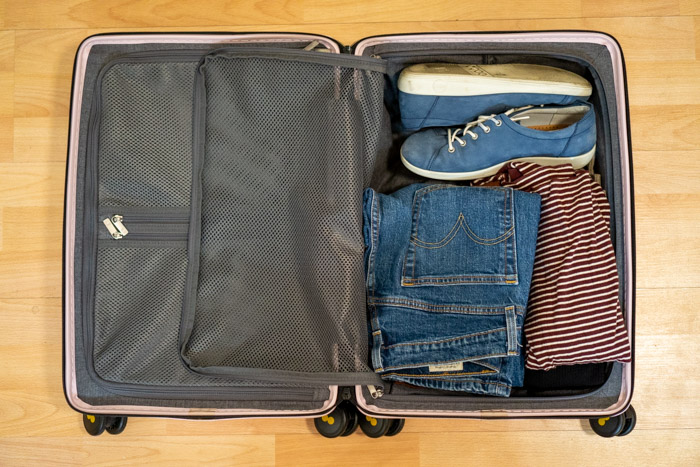
Ultimate Packing List for Europe
This ultimate Europe packing list is perfect for those looking to pack light and be a bit more minimalist in their adventure. While this certainly isn’t a complete bare-bones packing list for those who want to, say, travel carry-on only, it is good for those looking to not bring everything but the kitchen sink.
This is intended that you pack in a larger main piece of luggage (whether that be a travel backpack , wheeled backpack or traditional suitcase) along with a smaller piece of carry-on luggage such one from Level8 .
If you want to keep your items all organised then we also suggest using some packing cubes like the Eagle Creek Pack-It Compression Cubes
This checklist is also appropriate for all sexes and genders, just pick and choose some things as they don’t apply to you.

Figuring out what kind of clothing to bring is arguably the most important and most difficult thing about packing for Europe.
As mentioned earlier, it’s always a great idea to opt for neutral colours and items that you can mix and match to ensure that you can have some variety in your outfits without having to bring too many things and take up necessary valuable space in your luggage.
- Depending on the season or region of Europe you’re visiting, either bring a mixture of long-sleeve and short-sleeve tops, just long-sleeve or just short-sleeve tops to wear in Europe.
- I always recommend bringing one or two nicer tops or button-down shirts along with more casual t-shirts or tops. We like Bluffworks t-shirts as they’re both practical and also look good!
- Bringing one pair of jeans and one pair of another type of trouser is a great idea or one pair of lighter jeans and one pair of darker jeans. Having at least one pair of pants that can be dressed up is always a good idea
- You can browse some of our the best options in our best pants for travel in Europe guide.
- I, personally, love Bluffworks’ dresses , which have concealed pockets, a classic and flattering cut and can be dressed up or dressed down depending on the situation. Oh, it also is wrinkle-resistant and fully machine washable.
- If you’re visiting Southern Europe or simply travelling in the summer months, then having one or two pairs of shorts can be a great idea, especially when you need to keep cool or are heading to the beach.
- If your trip is during winter, having a tank top or light base layer will keep you warm without having to result in a bulky coat or jacket.
- Depending on the season or region, a cosy wool sweater or a light cardigan is a great idea when packing for 2 weeks in Europe. It can also be a good idea if you bring one that can be dressed up or down depending on the occasion (are you seeing a trend here?).
- Of course, you likely don’t need to include a jacket at all if you’re travelling to, say southern Spain or Malta in July, however, depending on the season, a warm, lightweight jacket is always a good idea for your trip.
- We recommend a packable down jacket ( click here for men’s version ), however, we have written a detailed guide for the best jacket for Europe depending on your needs.
- No matter the region or season, a rain jacket is always a good idea, as you can get caught out in a storm regardless of where and when you are travelling.
- We love the North Face Resolve ( click here for men’s version) as it has consistently kept us warm and dry in the rainiest of conditions.
- How much underwear you bring really depends on at what point in your trip you want to do laundry. If you want to avoid washing at all, then go ahead and bring 14 or 15 pairs of underwear. They do take up valuable space, however.
- Like underwear, how many socks (and the kinds of socks) you bring really depends on your shoe preference and just how often you want to do laundry.
- Bringing a swimming suit is a great idea even if you’re not going to a seaside destination. You never know when you may go to a bathhouse, sauna or pool on your Europe trip no matter the season.
- If you happen to be travelling to a beachy destination like Italy or Spain , consider bringing 2 pairs so you have time to dry each suit between wearings.
- I, personally, like to bring one regular bra and one sports bra, but this really depends on your needs and preferences.
- If you’re not a pajamas person, then don’t bother. I am, so I bring them. One pair for 2 weeks is sufficient.

Shoes take up A LOT of space in your luggage so limiting the footwear you bring on your Europe trip can be the ticket for maximising the space in your bags.
We have a complete guide on the best shoes for Europe to help you pick the right footwear for you. This is just what we recommend bringing when you’re compiling a packing list for 2 weeks.
- A good pair of sturdy, stylish walking sneakers is essential. Pick comfortable walking shoes that you can walk in for hours and kilometres and not have sore feet.
- I, personally, love the Ecco Soft 7 trainers and wear them all the time. For a men’s version consider the Ecco Soft 7 Runner.
- Choose your second pair of shoes depending on your style and the season you’re travelling in.
- If you’re an active traveller, are visiting a largely outdoor destination, or simply plan to do a bit of walking and hiking, then a good pair of hiking boots such as the Merrell Siren Edge for women ( available on REI here ) or Merrell Moab 2 for men ( available on REI here ) is essential.
- Small, compact, and helpful for everywhere from the beach to a hostel shower to a public pool, a pair of flip flops should always make it into your luggage!
Accessories
Whether fashion accessories or handy electronic gadgets, some of these are absolutely essential items to bring with you on your trip to Europe!
- The most important accessory of them all!
- Perfect for add a splash of style to any outfit, sipping over your head or shoulders if you’re visiting a church, using as a makeshift blanket, and also for its traditional use, a scarf is absolutely necessary to bring with you no matter the season.
- A warm hat to keep you toasty in the winter in Europe is always welcome, as is a sun hat to protect you from the harsh rays during summer in Europe.
- An essential item on any winter packing list!
- A solid anti-theft handbag like the PacSafe Cityscape or day pack is perfect for keeping your valuables safe and secure while you’re out and about sightseeing and exploring.
- Buying water and using plastic water bottles is a thing of the past. There are an infinite number of great water bottles for travelling to choose from like a Hydro Flask and you’ll never need to buy a single-use plastic bottle again.
- If you’re more serious about your photography than simply relying on your phone, then bringing a good camera is a great idea.
- We love the Sony A6400 for its high-quality images at a decent starting budget and there being several great travel lenses to use with it. Make sure to bring extra memory cards!
- You always need to have something good to read, but don’t want to pack a bunch of heavy books to bring with you – a Paperwhite Kindle solves all of these problems and it is an absolutely essential item if you love to read.
- Buy a prepaid SIM card like the Orange 20GB SIM either as physical SIM or eSIM to ensure you can stay connected in Europe.
- Finding a universal plug adaptor with a number of different USB drives is a fantastic option and is an absolutely essential item when travelling to Europe from elsewhere in the world!
- Finally, a power bank will give you peace of mind should your phone die while you are out and about or if you forget to give something a much-needed charge when you need to use it.
- Making sure you have an adequate number of charging cords for all of your devices will ensure that you can make sure everything can get the best battery life possible.
- A travel pillow is nice to have if you have a long flight or are taking overnight trains or buses.
- World Nomads offers flexible and simple travel insurance policies with coverage for more than 150 activities that you can buy or extend while on the road.
- SafetyWing offers travel medical insurance policies that can are an option for long term budget travellers.
- Save your money and landfill space and forgo the travel-sized toiletries for refillable bottles of your shampoo and conditioner. We love GoToobs .
- You might want to bring earplugs if you’re staying at a hostel or budget accommodation where street noise can be an issue or for your flight.
- To avoid unnecessary spills in your toiletry bag, we recommend using a bar soap rather than a shower gel, but this is really up to you
- Keep your dry skin nice and hydrated!
- Bring as little makeup as you need. Personally, I limit myself to one lipstick, one eyeliner, mascara, a small eye shadow palette, foundation and a few brushes. I also make sure I have facial cleansing wipes for makeup removal and just to wash my face at the end of the day.
- If you’re a lens wearer, you need to pack this!
- Blisters and cuts happen, best to be prepared rather than have to hunt for a pharmacy to find these things while travelling.
- While you can get ibuprofen and the other over-the-counter pretty much everywhere, it’s always nice to have it on hand should a headache threaten to put a damper in your Europe trip. Ditto with other OTC medications you take regularly.
Piecing together the Europe packing list for 2 weeks doesn’t have to be all that difficult if you take into consideration all of the things outlined above. Think minimally and pack light and you’re sure to have a fantastic time on your adventure — wherever it may be that you’re going!
Are you trying to figure out what to pack for two weeks in Europe? Was this packing list helpful for your trip? Let us know in the comments!

Related Posts:

25 Best Travel Accessories for Europe

The Best Mobile WiFi Hotspot for International Travel

Bluffworks Review: Stylish Clothes for Travel

About Maggie Turansky
Maggie is a co-founder and writer for The World Was Here First. Originally from the US, she has lived in five different countries and has travelled to dozens more, both solo and with her partner, Michael. She particularly loves exploring Spain and spending time in the Caucasus and the Baltics. Read more about Maggie
This is a great comprehensive list. It helps to prioritize what is really essential and can serve as a thorough starting point even if you want to tweak it some to meet your needs. I would add socks, belt and 1 or two costume jewelry pieces to the list.
Great list. I reviewed it against my list and they were pretty close. I have been reading your other articles and they have been most helpful. Many thanks!
This is very helpful. Thanks. I always seems to pack too much. Helen
Can most of this fit in a carry on and a personal bag?
This can be really dependent on the kind of bag, how you pack and the airline’s requirements! Sorry I couldn’t be more helpful 🙂
Thanks this was very helpful for a first time traveler 😉
Leave a Comment Cancel reply
15 essential packing items for a Europe trip
Recently updated on April 23rd, 2024 at 02:45 pm
So you’ve booked your dream tour and organised your flights… Now you need to pack! Europe is a massive continent with all kinds of different climates, cultures and landscapes. So where do you start? From what to wear in Europe to gadgets and medical essentials, here is our guide to everything you need to pack when planning a trip to Europe .
1. Versatile clothing
Europe has a reputation for being fashionable, from the minimalist clothing of Scandinavia to the elegant style of the Mediterranean. While you don’t need to walk around in haute couture, you also shouldn’t wear sloppy clothing or gym wear everyday. If you want to blend in and be comfortable, go for casual yet refined options. So what exactly do you wear in Europe?
In general, go for versatile layers that can take you from day to night. For example, you can wear dark wash jeans, a light t-shirt and sneakers during the day, then dress it up with a nice jacket, accessories and sandals by night. Or, go for trousers, dresses or skirts that can easily be dressed up or down. Of course, what you wear in Europe will change depending on the season (it can go from blazing hot summers to freezing snowy winters), but in any season, remember to pack light and choose layers you can mix and match.
We think you’ll also like: Top 10 Hidden Gems in Europe

2. Comfortable shoes
Although you’ll want to blend in with the stylish locals, the top priority is comfort when you’re planning a trip to Europe. You’ll be walking a lot, often on bumpy cobbled streets or hillsides, so you’ll need a comfortable pair of shoes to carry you through your trip.
Depending on the weather, that may be sneakers or sturdy sandals, or you may need hiking boots if you plan to hit the Alps. It’s also good to bring sandals or flip-flops for lounging by the pool or the beach. Whatever shoes you bring, make sure you break them in before you leave to avoid any nasty blisters.
Discover Europe’s landscapes on Grand European

3. Accessories
When you’ve got minimal clothing options, accessories are a great way to jazz up an outfit. You can pack light, colourful scarves, hair ties, hats and sunglasses, or throw on some jewellery (don’t bring any expensive stuff) like earrings, necklaces, bracelets or even use belts to stand out and complete your look.
We think you’ll also like: Where to travel in Europe in your 50s, 60s and 70s


4. Sun protection
Whether you’re travelling in summer, winter or somewhere in between, you always need to bring sun protection for your trip to Europe. Bring a hat, sunglasses and plenty of high SPF sunscreen.
Discover Europe in 14 days on European Whirl
5. Rain protection
You also need to consider the rain when planning a trip to Europe. Come prepared in any season with a raincoat, small travel umbrella or rain poncho.

6. Day bags
When you’re planning your trip to Europe, you’ll probably want to dedicate most days to sightseeing and different activities. Since you’ll spend so much time out and about, you’ll need a secure bag to hold all your daily essentials like your water bottle, sunscreen and camera. Whether you bring a backpack or cross-body bag, make sure it’s lightweight, waterproof, theft-proof and has plenty of pockets. For the evenings, you might like to bring a smaller bag or purse.
We think you’ll also like: 21 random fun facts about Europe you never knew
7. Toiletries
Your toiletries are up to you, but we always recommend pouring your products like shampoo and moisturiser into smaller, reusable travel bottles, to save space and produce less waste. If you don’t want to bring a bunch of liquids (that always seem to explode in your bag), you can try solid toiletries, like shampoo, soap, moisturiser and deodorant bars and toothpaste tabs. It’s also handy to bring a hanging toiletry bag to make it easier to reach in the bathroom.
Go back in time on our Traditional Europe tour

8. Medical kit
While you can usually find everything you need once you arrive, it’s always useful to bring a small medical kit when planning a trip to Europe. You’ll firstly need to pack any prescription medication you need and bring enough for your whole trip.
Other handy items include hand sanitiser, painkillers, electrolytes, antiseptic ointment and bandaids, eye drops, insect repellent and travel sickness tablets. If you’re a light sleeper, bring earplugs and an eye mask. Be sure to consult your doctor for specific travel health advice for your trip.

9. Reusable water bottle
You can help reduce plastic waste and save money by bringing your own reusable water bottle. You can refill it in destinations where it’s safe to drink the tap water, or use the filtered water at your hotel, or drinking fountains and refill stations found across Europe.
Curious as to whether it’s safe to drink the tap water in Europe?
10. Smartphone or camera
This is one of the most essential items on anyone’s list when planning a trip to Europe. From the icons like the Eiffel Tower and the Colosseum to the magical landscapes like the Swiss Alps and Amalfi Coast, you’ll want to take hundreds of stunning photos on your Europe adventure. Whether you use your smartphone camera or bring a separate SLR camera, make sure you bring extra memory cards, chargers and waterproof cases.
We think you’ll also like: Stays with Stories: 5 Unique Accommodations in Europe

11. Travel adaptor and power strip
Speaking of gadgets – you can’t leave home without a travel adaptor. Check the plug type and voltage of the destination you’re visiting before you go, or bring along a universal travel adaptor if you’re visiting multiple countries with different plug types.
If you have a lot of electronics, or you’re travelling with other people, a power strip is very handy. You can charge everything at once, or if you only have one outlet in your room, you won’t be fighting over who gets to use it first!

12. Entertainment for the road
When you’re planning a trip to Europe, you’ll probably have some long plane rides or coach journeys. Come prepared with some light entertainment like headphones to listen to music, or an e-reader stocked with books. While paperbacks are great, they can be very heavy, which isn’t ideal when you need to pack light.
Take our Travel Quiz: Where Should I Visit in Europe?
13. Sealable bags
It’s always a good idea to bring a few waterproof, sealable bags. They can be small dry bags or toiletry bags, and they’re great for storing wet clothes, liquid containers to prevent spillage, or valuables like your passport, cash or phone.

When you’re planning a trip to Europe with Trafalgar , most of your expenses will be covered before you go, including hotels, transport and some activities and meals. But you’ll still need to bring some extra money for things like souvenirs and extra activities or meals. We recommend bringing your debit and credit cards, and some extra local cash. UK pounds and euros will get you across most of Europe, however you’ll need to check your specific destinations for their local currency.
We think you’ll also like: 15 European destinations that really come into their own in the winter
15. Important documents
You probably won’t leave home without your important documents like your passport and visa (we hope!), but you should also bring photocopies of these documents. In the unfortunate event you lose or damage your documents, the photocopies will be very useful in getting replacements or important information. We recommend bringing copies of your passport, visas, travel insurance and any tickets. It’s also handy to write down local emergency numbers on a small card and keep it in your bag on your trip.
Are you planning a dream trip to Europe? What essentials will you pack for Europe? Let us know in the comments below!
Want to hear more from us?
Sign up to receive inspiring travel articles, offers & news
" * " indicates required fields
Privacy Overview
Sign up for our emails.

Packing for a Trip to Europe: Essential Things to Pack When Going to Europe Any Time of Year

There are some essential things to pack when going to Europe , no matter what type of European trip you are planning.
Whether you are going backpacking in Europe for several months or plan to visit some of Europe’s most popular cities on a much shorter trip, in this article I want to share a packing list for Europe that covers the basics for any trip.
I’m from Europe myself (from the Netherlands ) and I have traveled around Europe for as long as I can remember.
It started with my parents taking us to France for our summer vacations, followed by me moving to Spain for a summer job after high school. Since then I have lived in several European countries and traveled to many more.
And yes, I want to start by saying that every European country is different and that does influence what things to pack when traveling to different parts of Europe. Therefore, in this article I will list both packing essentials I’d recommend for any trip, plus some tips specifically for certain destinations, times of year, and types of trips.
I hope that after reading this article you’ll have a good idea of things to take on a trip to Europe.
What to Pack for a Trip to Europe
1. the basics: passport & other documents.

Let’s start with the basics: make sure you have a passport and that it’s valid for at least another six months after the last day of your trip.
Six months is a nice general rule that I always stick to, but it does vary per country. The EU actually asks for a validity of at least three months after the day you intend to leave the EU, and most other European countries have that same rule, but not all. They will never ask for more than six months though.
So, if your passport is still valid for more than six months you are fine, if it isn’t you might want to check the requirements for the specific countries you plan to visit.
Residents of many countries will get a visa on arrival for visiting European countries, but just make sure that’s the case for you as well. If you need a visa , apply for it on time. Your home country (or the country of which you hold a passport) will most likely have a government website that can provide you with all the information you need.
Or, you can contact the Embassy in your country of the European country/countries you are visiting. For example, if you are going to France and live in Mexico, you can contact the French Embassy in Mexico City.
If you plan to drive in Europe , make sure your driver’s license will be accepted in the country or countries you are going to.
And if you are renting a car , it’s good to know that most car rental agencies require a credit card in your name to be able to rent a car. If you don’t have that, ask in advance if your chosen rental agency will accept other means of payment.
Also Read: Tips for Driving Abroad for the First Time
2. A Universal Adapter and a Power Bank
Different European countries use different plugs. I therefore always carry a universal travel adapter and recommend this as one of the things to buy before traveling to Europe.
If you are only traveling to one European country you can look up which plugs they use there and only buy an adapter suitable for that country. But, assuming you’ll visit other countries in the future a universal adapter is very useful.
Whichever option you go for, buy them online, as doing so in the airport might be a lot more expensive.
I would also recommend packing a power bank . Most likely you’ll be using your phone a lot to take pictures and to find your way around the European destinations you are visiting.
And the last thing you want is for your phone to run out of battery right when you want to take a great picture or have lost the way back to your hotel.
I really like this solar power bank because I can recharge it while I’m having a drink on a sunny terrace somewhere (and it’s a lot better quality than solar power banks I’ve tried before). But of course any reliable power bank will do.
3. Medicines & Painkillers

Although you’ll find good pharmacies throughout Europe, think about which medicines you’re likely to need when packing for a trip to Europe .
Bring enough of any prescription medication you take. And if you prefer a specific brand of painkillers, food supplements, etc., it might be easiest to bring them as well.
4. A Borderless Debit Card
A question I often hear is how much cash you should bring when traveling to Europe.
My advice: don’t exchange money in your home country because that is expensive! Fees are sometimes absolutely ridiculous.
No matter which European airport you fly into, there will always be an ATM. So, just make sure you pack a debit card (or credit card) that works abroad and take money out as soon as you arrive at the airport.
Credit cards aren’t as widely accepted in Europe as in some other parts of the world. The Netherlands is a good example. We use credit cards for online purchases and car rentals but a debit card to pay in shops, restaurants, etc.
Therefore I highly recommend bringing both a borderless debit card and a credit card .
I’ve been using Wise (previously called Transferwise) for many years as my borderless debit card. With Wise, you get some of the best exchange rates on the market.
You can simply create an account online and order your debit card. You can use the card to pay in stores anywhere, and to take out money at ATMs, with low or no fees.

Now, what clothes to pack for a trip to Europe really depends on where you’re going and what time of year.
Spending the summer in Spain will require completely different clothes from going to see the Northern Lights in Finnish Lapland in winter .
So those standard Europe packing lists you sometimes see, recommending a set list of clothes for traveling to Europe don’t make sense to me. What I would recommend is to base your clothes on where you are going and what the weather will be like:
• Will you mainly be spending time in European cities? Then bring clothes that are comfortable yet a little stylish. People in European cities tend to follow fashion trends more than in small towns, and especially for an evening out you might want to dress up a little. Don’t go crazy though. In most European cities we walk a lot (or cycle a lot) and we like to be comfortable doing so.
• If any rain is predicted , an umbrella is more common in cities and towns, where a good raincoat is what I’d recommend bringing on nature walks/hikes.
Also Read: What to Bring on a Hike
• Bring layers. This way you are prepared for different temperatures and you can combine them differently on different days, making your outfits look more varied.
• Bring comfortable shoes. No matter where you are going in Europe, you will probably be walking a lot, so make sure you bring shoes that are comfortable.
• Shorts and flip flops aren’t worn much in European cities, no matter what the temperature is. In fact, in Spanish cities they are frowned upon a bit and it’s even illegal to drive in flip flops ! But hey, you want my opinion as a European? Wear what makes you feel comfortable! If it’s hot and you like to wear shorts, just go for it!
• Wear modest clothes when visiting religious sites. Some churches won’t let you in if your clothes don’t cover your shoulders and knees (it happened to me in Milan , Italy). And although most churches and other religious sites won’t actually stop you from entering, they do prefer you to dress modestly so that’s something worth keeping in mind.
• Don’t forget that there are shops everywhere , including many international chains you’ll most likely know from back home. So, my advice would be to travel light . It’s so much better to buy an extra top or dress locally (which also makes a great souvenir) than to lug around a big suitcase packed with items you won’t wear.
6. A Suitcase or a Backpack?

Ok, there is no answer to this question. It depends on what you prefer.
When traveling in Europe I bring a suitcase. And, if my trip isn’t too long I try to only take a suitcase that fits the hand luggage requirements for the airline(s) I’m using, plus a small purse or laptop bag.
This way I don’t have to pay extra for checked luggage and won’t have to wait at the airport to collect my luggage. Plus, it forces me to travel light and think about what really is essential for my trip.
Although I would say Europe is perfect for suitcases, I can find some arguments in favor of using a backpack.
Dragging my suitcase up a hill, over a cobblestone road in a small town in Spain wasn’t great.
And you may find yourself staying on the fourth floor of a ho(s)tel that doesn’t have an elevator. A backpack will be easier then as well.
But if your European trip takes you mainly to cities, staying in mid-range hotels, or maybe you’re going on a European road trip, then I would say a suitcase is perfectly suitable.
Note: whether you bring a backpack or a suitcase, these packing cubes are great and I use them all the time! It helps organize your clothes and other items to easily find them. Maybe it’s just me, but my suitcase tends to be a mess after a couple of days of traveling, so these cubes really help me to keep things organized.
One final tip: if you plan to go hiking or spend time at the beach, bring a daypack or beach bag.
7. Other Accessories
If you like to use a particular shampoo or toothpaste , and you can take it with you, then do it.
Of course you’ll easily find shops anywhere in Europe selling shampoo, toothpaste, etc., but there is a good chance they won’t have (all) the brands you are used to.
Bringing a reusable water bottle is a great way to save money and use less plastic. In most of Europe you can drink the tap water, but just ask whenever you arrive in a new part of Europe to make sure.
Bring appropriate sun protection (sunglasses, a hat, and sunscreen) if you plan to visit sunnier places.
I like to bring a travel pillow for long plane, train and bus rides.
And if you plan to stay in hostels I’d recommend bringing a padlock . Most hostels have lockers to securely store your belongings, but they sometimes only provide padlocks at a fee.
How to Stay Safe While Traveling to Europe

Awareness and thus prevention is your best friends when it comes to traveling. Though Europe is a safe continent to travel to, it’s better to take some precautions.
Do some research before you travel . Read a few articles about safety in the countries or areas you are visiting.
Avoid walking around alone late at night in areas you don’t know and don’t show off your new phone or expensive jewelry.
Consider bringing a money belt to hide your money, passport, and other valuables.
And of course, make sure you have the right travel insurance .
Be wary of public WIFI. Making sure nobody can hack your phone or laptop while traveling is a serious concern. Cybercriminals may steal your personal information when connecting to your hotel internet or other public WIFI.
Your phone is often the most vulnerable gateway to your bank account and other critical personal information.
Apart from this, a VPN will also allow you to bypass online geo-restrictions and censorship . This means you have access to your favorite shows, blogs, Youtube videos, etc. which you sometimes can’t access abroad without a VPN.
- How to Stay Safe While Traveling
- Things to Know Before Traveling to Europe for the First Time from the USA
- How to Find the Cheapest Flights
- How to Save Money When Traveling
- Practical Tips for Traveling Alone
- Staying in a Hostel: Pros, Cons & Other Things to Know
- 4 Lesser-Visited European Capitals You Should Check Out
Like this article about packing for a trip to Europe? Pin it!
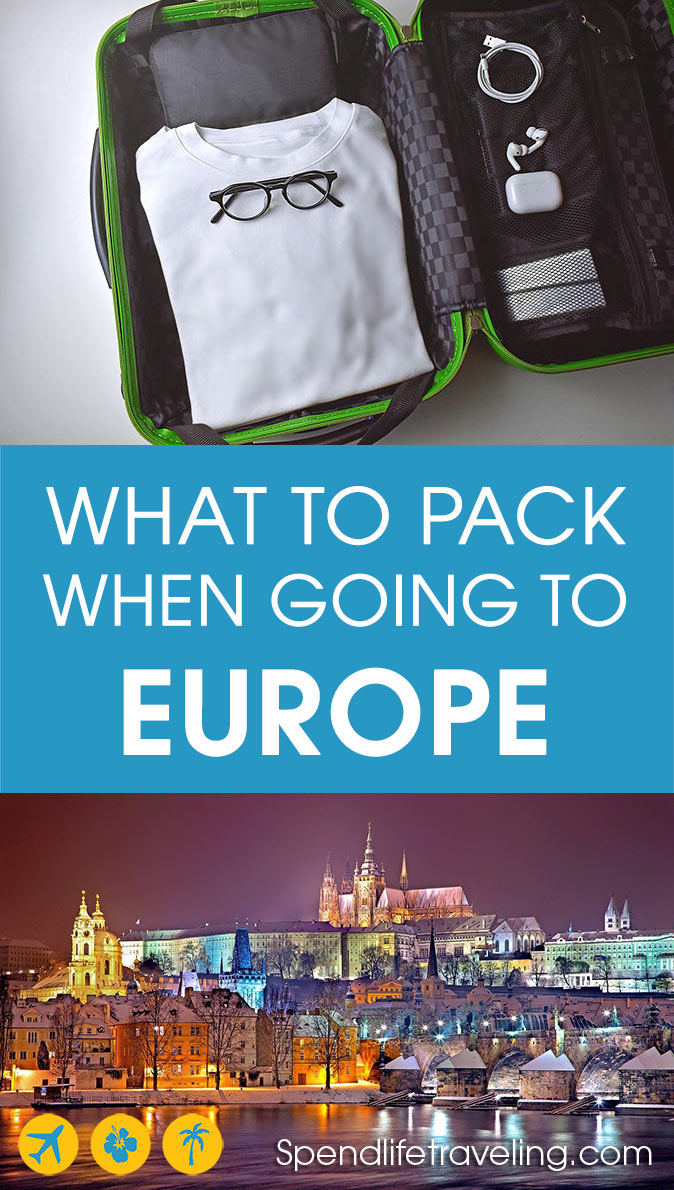
This packing list for Europe contains affiliate links. I may receive a commission for purchases made through these links, at no additional cost to you. As an Amazon Associate I earn from qualifying purchases.
Leave a Comment Cancel reply
Contact: [email protected]
Created by Mar y San Design

Packing List for Europe: Travel Essentials for Trip to Europe
Disclosure: Some links are affiliate links – which means, at no extra cost to you, I earn a small commission if you make a purchase through a link.
Heading to Europe soon? Planning a trip to Europe can be such an exciting and exhausting experience. On one hand, you’re excited about all the wonderful things you’ll see and do on your trip around Europe. Yet, on the other, you find yourself worrying about two things.
#1. Will you be able to see everything there is to see? I won’t lie, FOMO is very real.
#2. Does your packing list for Europe have every essential item you need to make your trip smooth sailing?
While this post won’t be able to solve problem #1, I’m here with my ultimate Europe travel checklist to help you with problem #2! A complete list of travel items you need for your trip abroad!
Let’s get start!
Table of Contents
Top Europe Travel Essentials
These are the top travel items that should be on everyone’s Europe packing checklist. Don’t leave home without them. Have these travel necessities before you arrive at your destination to ensure a seamless start to your trip. Otherwise, you’ll be frantically searching for these items in Europe instead of enjoying your trip!
1. Travel Adapter
Before traveling to Europe, it’s important to know that the voltage and the electrical outlets in Europe differ from the US.
The voltage in Europe is at 220 volts, so you can’t plug your electronics into the wall without using a voltage converter . You’ll fry it, just like how I almost fried my Nintendo DS in China. However, if you see “100-240V” listed on your charger, then you’re good. It means this electronic is dual voltage and you won’t need the voltage converter.
Now, let’s talk about the outlets in Europe. Without a travel adapter, you won’t be able to plug in your standard US chargers into the sockets in Europe.
An European travel plug adapter is good for Type C sockets (two round prongs). This is the common socket type used in most European countries, but not all.
Instead of buying multiple types of travel adapter, save the hassle and get yourself a universal travel adapter that can plug into any outlets in the world. This small yet essential item will help you charge all your electronics and prevent any inconveniences. Trust me, it’s a must-have to keep your phone alive!
2. Durable Suitcase
If there’s one thing worth splurging on, it’s spending money on a good suitcase with very durable wheels. This suitcase will be the home to all your stuff for the entirety of your travels.
The last thing you’d want during your trip is to have a cracked suitcase or a suitcase with broken wheels. Imagine dragging that through Europe’s cobblestone streets during the heat of the summer. Not a pretty scene, I assure you.
Proof you need a durable suitcase:
I had to run while dragging two 50lb suitcases with broken wheels through the airport trying to make a connecting flight. For the cheaper suitcase, 3 out of 4 wheels had gone MIA during the rough unloading process by the baggage handlers..
- In another incident, a friend had to find tape to patch up her cracked suitcase (another unfortunate victim of the check bagged unloading process).
3. Comfortable Walking Shoes
It’s not an exaggeration to say that you’ll be walking a lot while exploring these European cities. From cobblestone streets to hilly terrains, comfortable walking shoes are a must.
That’s why you need to invest in a good pair of walking shoes. Find one that provides lots of support and cushions. This will keep your feet happy even at the end of long travel days.
However, never travel with brand new shoes. Break them in before you travel so you won’t get blisters. If needed, pack some blister plaster to prevent blisters.
Some recommendation of good walking shoes are Adidas (their cloudfoam soles are godsend), Allbirds , and Tevas .
4. Travel Insurance
While it’s not a travel accessory, travel insurance is must-have whenever you’re planning a trip. It’s a safety buffer that offers protection for unexpected events that could ruin your trip.
SafetyWings is my go-to travel insurance during my trips. It is travel insurance specifically made for digital nomads and travelers. Which is why there’s so much flexibility when purchasing a plan. You can include all the countries you plan to visit during a single trip in the coverage.
Plus, it covers both medical and travel insurance. So you will be covered for medicinal emergencies, medical evacuations, trip delays, lost luggage, and much more.

It’s crucial to do your own research and select a comprehensive travel insurance plan that meets your specific needs. Before purchasing insurance, always carefully read the terms and conditions. Look very very carefully at the fine prints!
5. Portable Power Bank
When you’re constantly snapping photos and using GPS on your phone, your battery will be nearing 0% by mid-day. Especially during the hot European summer. That’s where a portable power bank comes to your rescue, ensuring you never run out of juice while on the go.
I highly recommend this Anker power bank . Not only is it lightweight and easy to pack, it also has enough power to give you multiple charges. The wireless charging feature is great when you forget to bring your cables. I had to hunt down a charging cable in Spain because the one I packed was defective, so the wireless feature really came in handy.
So, when you’re packing your day pack, don’t forget this essential lifeline!
6. Refillable Water Bottle
You’ll definitely want to bring a refillable water bottle when you’re traveling to Europe. It’s a great way to cut down on plastic waste and help save some money, especially in European cities where tap water is safe to drink. For example, Madrid has one of the best tap water in Spain, so I just fill up the water in the sink before leaving for my day trips.
For other cities in Europe where tap water is not consumable, you will want to pack a water bottle with a filter .
7. Theft-Proof Daypack
It won’t take you long on your European trip to hear some horror stories about pickpockets. Sadly, we’re all easy targets walking around an European city, especially in crowded tourist sites.
You won’t even feel these pickpockets sneaking up on you. I thought I was saved from pickpockets on my 5 week trip to Europe until someone pickpocketed me on the very last day!
Get yourself a theft-proof backpack or anti-theft cross-body bag with secure compartments to keep your belongings safe. The slash-proof material will prevent pickpockets from slashing your travel bag.
8. Packing Cubes
Ever since I found out about packing cubes, I cannot travel without them anymore. Which is why I think everyone should have them. Especially, if you’re flying with a budget airline and need to deal with the luggage restrictions.
Unless you’re a minimalist packer, it can be quite difficult to pack everything you need into a small suitcase. However, by using packing cubes, you can keep your clothes compact, organized, and wrinkle-free. There’s no need to unpack your entire bag to find that one shirt again!
I swear by these Osprey packing cube sets. For something that weighs close to nothing, it’s super durable. I’ve squeezed my clothing for multiple week trips into these 3 packing cubes!
9. Credit Card with No Foreign Transaction Fees
Don’t travel internationally without first getting yourself a travel credit card. By using a card with no foreign transaction fees, you will save on the 3% fees that regular credit card charges on every international purchase you make.
During my first international trip, I didn’t know about this and swiped up $$$ in fees alone! My heart dropped when I saw that credit card statement.
No one wants to hunt down missing luggages. Pack an AirTag into your suitcase or attached it to your important items so you can track their whereabouts!
Plus, when you’re not traveling, you can dump the AirTag in your car. This will save you the trouble of wandering the streets hunting down your car because you forgot where you parked it.
Whenever we’re on the go, it’s unavoidable that we’ll connect to a public WI-FI. Secure your browsing by using a VPN. They also work great if you don’t want to miss out on your Netflix shows while overseas. Just connect to a USA server and you’ll have your show! The VPN I use while on the go is Surfshark VPN !
Backpacking Europe Essentials

1. Durable Travel Backpack
You’ll want a backpack that’s durable enough to withstand all the throwing and lugging on your backpacking trip across Europe.
My go-to travel backpack is the Osprey Fairview . It has traveled with me across all over Asia and Europe.
Weighing at less than 3lbs, it’s great for backpackers because you’ll need to pack light. And since it’s only 40L, you can easily take it onto your flight as the carryon bag.
2. Flexible Combination Lock
If you’re staying in hostels, you’ll need to bring your own lock when using the hostel lockers. I love using the flexible combination lock . It is the perfect item for the job. Plus, when you’re on the road, you can also use them to lock up the zippers to your backpack or suitcase.
Don’t forget to include a dry bag on your travel essentials checklist! You don’t want to mix your clean clothes with your worn dirty clothes, right??? Repeat after me: No, we don’t.
A dry bag will hold those stinky clothes for you and prevent the odor from spreading until your next laundry day. If you’re going to a water activity, it’s also great for holding your wet swimsuit until you can dry it.
4. Portable Travel Door Lock
One travel essential item for anyone’s list is a light portable door lock . When you’re traveling for a while, you’re bound to come across some doors with wonky locks. A portable door lock will keep that door closed and secured, giving you a good night’s sleep.
Bring this with you on your next trip, especially if you’re going alone!
Read this blog for more safety trips when solo traveling !
5. Portable Luggage Scale
This digital luggage scale will be your best friend when you need to make sure your luggage doesn’t go over the airline’s weight limit. It’s small and lightweight and will easily fit into your luggage. This is how I make sure my luggage does not go over 15lbs when taking budget flights in South East Asia.
6. Travel Umbrella
You’re bound to encounter rain if you want to backpack for weeks in Europe. Pack a small durable travel umbrella for those rainy days. They’ll easily fit into a daypack so you can carry it on the go for days with 50% rain.
7. Hanging Toiletry Bag
A toiletry bag is useful for organizing your personal care items and keeping them easily accessible during your Europe travel.
When you’re staying in hostels, you’ll often notice the lack of counter space at the sink for your stuff. This is where a hanging toiletry bag that easily hangs on a hook or door is a godsend.
Store your liquids together in a clear plastic bag/case and keep them all under 100ml each to comply with airport travel restrictions. Packing travel-sized toiletries is the way to go!
8. Quick Drying Travel Towel
Hostels rarely provide towels for free. If you do not bring your own, you’ll need to rent one from the reception.
Now, before you pack that soft (but bulky!) bath towel into your bag, let me introduce you to the quick dry travel towels !
This amazing product is perfect for travelers who are constantly on the go. Unlike regular towels that take forever to dry, these quick dry towels are optimized for travel. It’s made from a special microfiber material that not only absorbs water quickly but also dries in no time.
Which means.. you don’t worry about a damp towel in your backpack! Plus, they pack small so you don’t have to worry about them using up half your luggage space! Get one now !
9. Portable Travel Hangers
Need something to hang your wet laundry? Pack a pair of these portable travel hangers so you can hang up your clothes anytime! Once you’re done, it folds into a compact size you can easily slip into your luggage.
I also love these convenient and lightweight cloth hangers . It’s super easy to find a pole or hanger to attach the cloth hangers to. Once you’re done, just clip your socks and undies and leave for the day.
Ultimate Travel Packing List for Europe
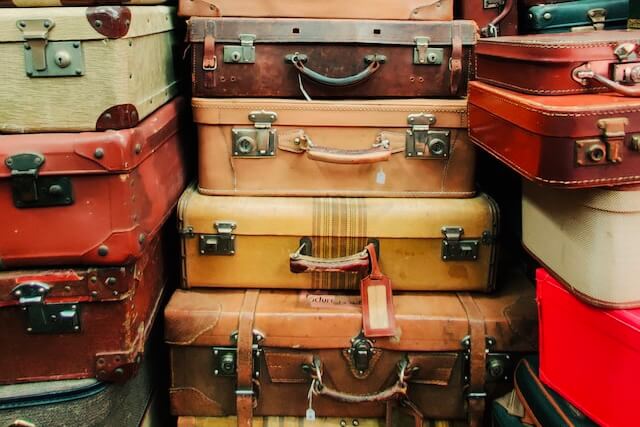
Adapt this Europe packing list based on the specific activities, climate, and duration of your journey.
Travel documents:
- Visa (if required)
- Travel insurance
- Copies of these important documents
- Enough outfits for each day of your trip (up to 7 days)
- Pants/Skirts
- Dresses (pack more one piece outfits if you want to reduce weight)
- Underwear x days of trip
- Cardigans for layers
- Windbreaker jacket
- Comfortable walking shoes for sightseeing
- Sandals (warmer weather)
- Flip-flops for shower & beach
- Dress shoes (for special occasions)
Accessories:
- Sun hat or cap
- Scarf / shawl (versatile use: cover up, cold weather)
Toiletries:
- Toiletry bag
- Shampoo & conditioner
- Skin care products
- Feminine care products
- Necessary medications
Electronics:
- Phone charger
- Selfie stick / tripod
- Camera (and charger)
- Adapter plugs for European outlets
- Any other devices you need & their charger
- External storage hard drive
Money and cards:
- Cash in the local currency
- Travel credit cards with zero foreign transaction fee x 2 minimum
- Debit cards x 2
- Notify your bank about your travel plans.
Miscellaneous:
- Refillable water bottle
- First aid kit
- Dry bag (serve as laundry bag)
- Portable fan (for those hot European summers)
- Download offline maps of destination
- Download country’s language pack in Google translate
Tips for Packing for Europe
Make copies of travel documents.
Before leaving for your trip, make sure you have all the travel documents, including your passport, visas, and any required vaccinations.
Make copies of these documents and store them in a separate location, as well as keeping digital copies in the cloud. This will speed up the replacement process if your documents ever get lost.
Is backpack or suitcase better for Europe trip?

When choosing luggage for your Europe trip, it really depends on your preference and travel plans.
If you’re planning a longer trip or like to bring back souvenirs, a checked suitcase will give you that flexibility in storage spaces.
Something to keep in mind, however, you’ll most likely be walking through the cobblestone streets in Europe. With a suitcase, lugging it through the uneven paths could get annoying at some point. If there’re no elevators in your accommodation, you’ll also need to lug your suitcase up the stairs.
Carrying a backpack will solve that mobility problem, but there’s another issue. Unless you’re packing super light, you’ll most likely feel the dead weight on your shoulders for the whole trip.
Carefully weigh the pro and cons of both options before you decide on which to bring on your trip!
What should you wear in Europe?
Dress your best because you’ll encounter Instagram worthy spots everywhere you go. You’ll even fit in better since you won’t be seeing many T-shirt and shorts combos in Europe. So pack clothes that are BOTH comfortable and stylish (ditch the uncomfortable clothes at home).
Since you’ll be moving around a lot, opt for lightweight, breathable fabrics. And choose versatile pieces that can be dressed up or down depending on the occasion.
Layers are essential to have, since they allow you to adjust to changing temperatures throughout the day.
Don’t forget to check the weather forecast for your destination, and make your list of items to pack accordingly.
How to pack light for Europe?
Packing light is key to having a stress-free travel experience in Europe. Start by making a list of everything you need and then carefully consider each item’s necessity. Do you really need to bring it or can you buy it in Europe? If you know your accommodate provides toiletries, you can even ditch the shampoo and conditioners.
Pack versatile clothes that can easily mix and match. Neutral colors work really well in this case. Minimize the number of shoes and accessories.
Having fewer items in your bag will make packing much easier as you move around places in Europe.
What to keep in your carry-on bag?
If you’re traveling with both a checked baggage and a carry-on, there’s a few things you’ll need to keep in your carry-on.
Make sure to pack your important documents, passport, travel itinerary, visas, and medications in your carry-on bag. In case your checked luggage gets delayed, pack a change of clothes and basic toiletries. Keep your electronic devices, chargers, and adapters in your carry-on.
By following this Europe travel essentials packing list, you will be well-prepared for your trip to Europe in 2023. No more scrambling to pack. Happy travels!
Interested in traveling with eco-friendly travel gears? Check out my 20+ eco-friendly travel product recommendations!
More Resources to Help You Plan Your Trip
- Don’t forget about travel insurance! I use SafetyWing for all my trips.
- Booking.com is great for finding deals on hotel stays.
- I love using Hostelworld for finding hostels with great vibes!
- Use GetYourGuide to find that unique experience you’ll remember forever.
- Book cheap connections to your next destination with Omio .
- Stay connected everywhere you go with Airalo eSims .
Untermyer Park and Garden: A Free to Visit Botanical Garden in Yonkers, NY
You may also like, untermyer park and garden: a free to visit botanical..., holiday gift guide: practical travel gift ideas for..., guide to cold spring, ny – a day..., the perfect 2 days in venice itinerary for..., best way to spend one day in boston:..., perfect 5-7 day cancun itinerary for first-timers tips..., leave a comment cancel reply.
Save my name, email, and website in this browser for the next time I comment.
Sign me up for the newsletter!
This website uses cookies to improve your experience. We'll assume you're ok with this, but you can opt-out if you wish. Accept Read More
The Backpacker Network
Travel Essentials for Europe – Packing List for Backpacking!
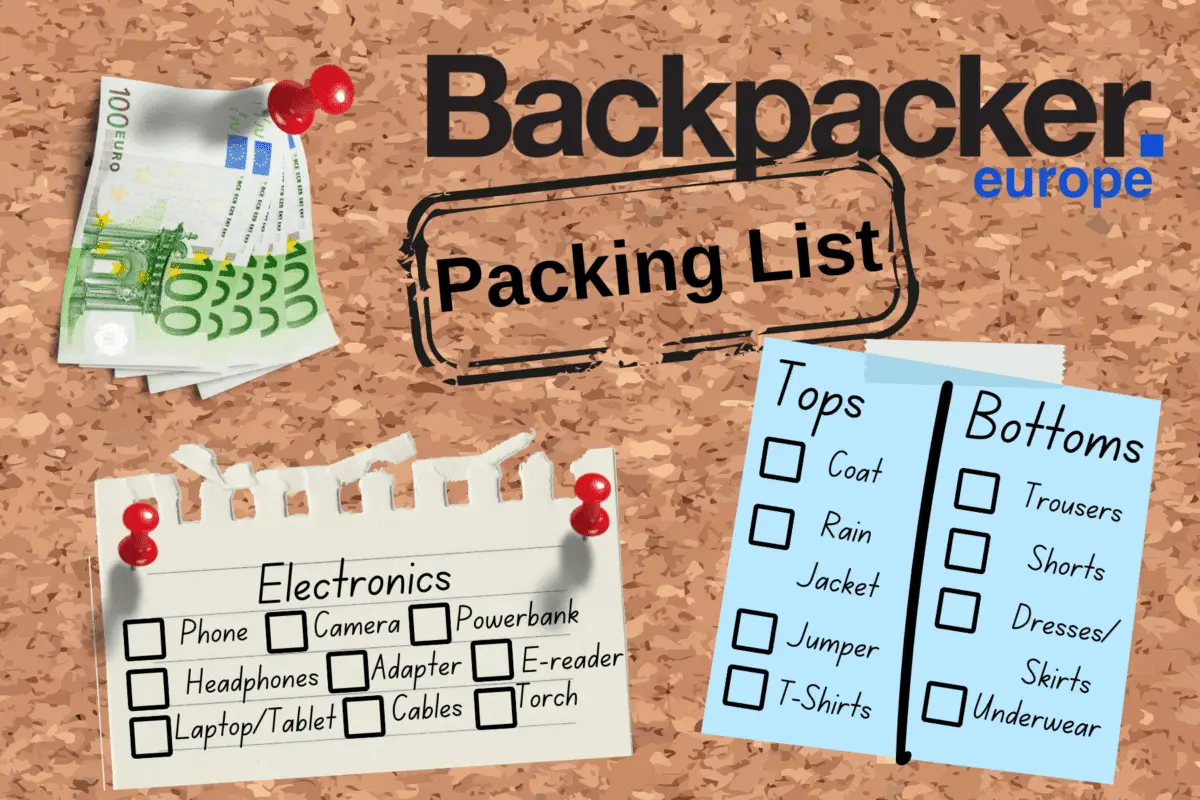
Choosing what to pack for Europe can make or break your trip. Pack too much and you’ll be frustrated dragging around stuff you never use. But if your packing list is too short, you may find yourself spending a ton of money on things you could’ve just brought from home!
So, if you’re tired of working out exactly what should be in your backpack, we’ve got you. This list of travel essentials for Europe will help guide you on your next trip!
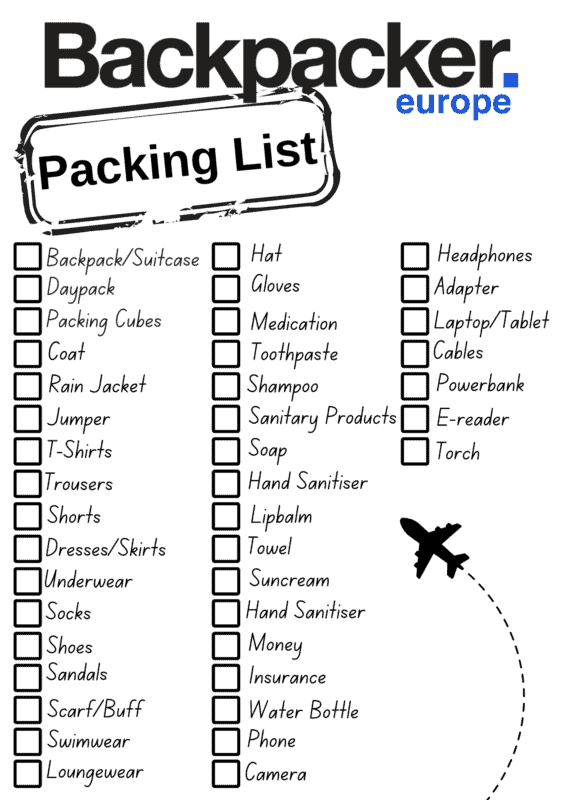
Read More: (Links open in a new tab)
- Europe Backpacking Routes
- Top Backpacking Destinations in Europe
- Backpacks for Europe
Ultimate Packing List for Europe
Luggage for europe, backpack or suitcase.
Before planning what to take to Europe, you need to work out how you’re going to take it. While we here at Europe Backpacker are big fans of travelling with a backpack , the suitcase vs backpack debate is always whispering away in the background.
Outside historic centres, streets in Europe tend to be smooth and there aren’t that many locations that involve getting too far off the beaten track to reach your accommodation – so suitcases are more than suitable for most trips. However, if you’re travelling for more than a couple of weeks – or plan on moving between locations a few times – backpacks tend to be easier.

For light-packing travellers, a 40-litre backpack is ideal. They can usually be taken as carry-on bags and due to their smaller size, are easy to take on public transport in Europe. But if you like more home comforts as you travel, you’ll want something bigger. At the end of the day, choosing the right size backpack is personal preference, don’t let anyone decide for you!

Osprey Farpoint/Fairview 40
Osprey's 40-litre Farpoint (men's) and Fairview (women's) are the best-performing travel backpacks for Europe. They're spacious, comfortable and easy to get your gear in and out of!
Some travellers to Europe will opt for a duffel bag . Sitting somewhere between backpacks and suitcases, duffel bags are easy to pack and manoeuvre but aren’t as comfortable as backpacks and are harder to transport across long distances than suitcases – especially if they’re heavy!
Regardless of what we think the best luggage for Europe is, if you strongly prefer one option over another, go with that!
Packing Cubes
It doesn’t matter which luggage option you pick, you’re likely to want some semblance of organisation within it. Packing cubes to the rescue! They allow you to keep your stuff organised and easy to find in your bag. They make packing easier and some can even compress soft items like clothing, to maximise space within your luggage!
Whether you use a backpack, duffel bag or suitcase, include a daypack in your packing list for Europe! Daypacks allow you to carry your day-to-day essentials as you explore your new surroundings!

Stubble & Co The Roll Top
Stubble & Co's Roll Top makes an excellent daypack for travel in Europe! It's durable, comfortable to wear and can hold plenty of stuff for your day-to-day explorations!
If you’re tight on space or don’t want to carry an extra backpack on the plane, consider a packable daypack . These pack down super small and can be stuffed into your main luggage until you need them!

Clothes to Bring to Europe
- Jacket – Unless you’re travelling to Southern Europe in the middle of summer, a travel jacket is a great idea for any European packing list. They’re lightweight, don’t take up much room and will keep you warm on chilly evenings or cool days.
- Rain Jacket – No matter when you choose to visit Europe, bring a packable rain jacket just in case. You never know when a freak downpour could catch you out. Plus, rain jackets offer excellent wind protection if it’s a bit too breezy for you!
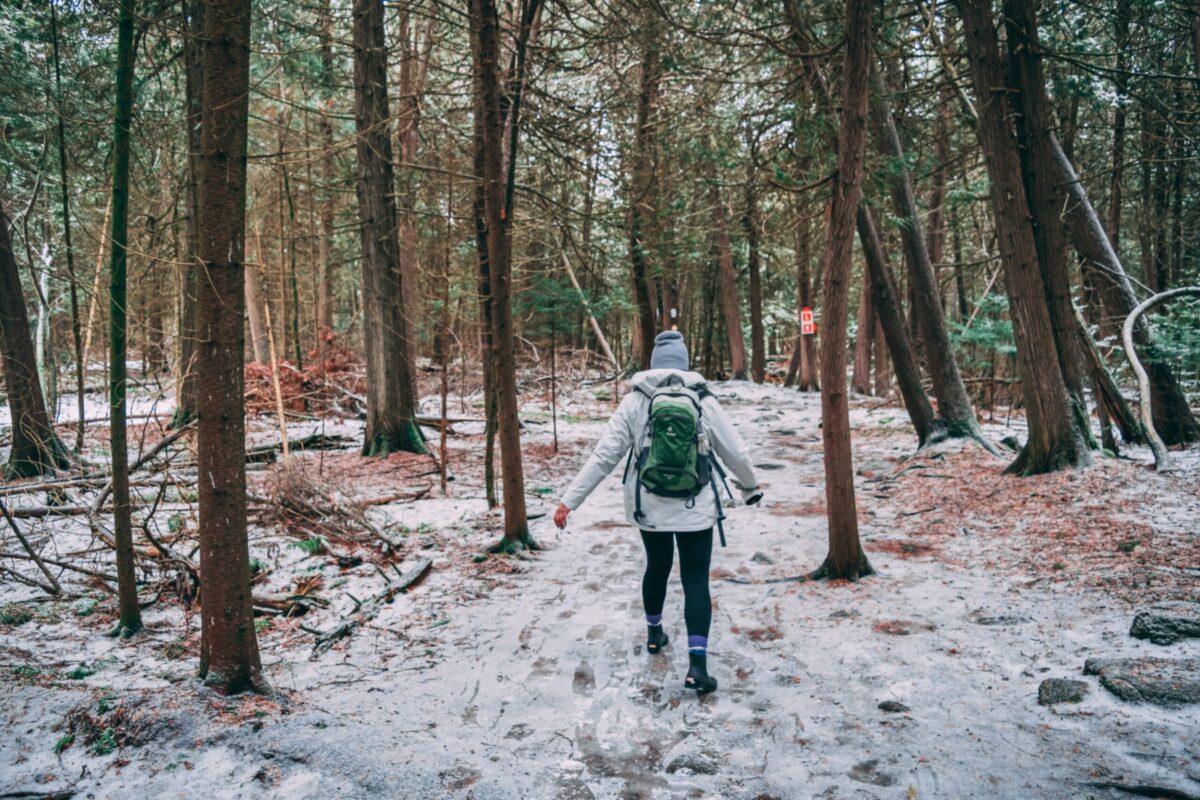
- Jumper – Even if you travel during summer, a thin, lightweight jumper will offer insulation on cool days. If you’re travelling Europe in the winter , you’ll want a couple of thicker (but not too thick) jumpers that you can wear with other insulation layers!
- T-shirts/Vests – No matter the time of year you travel to Europe, there should always be a few t-shirts in your bag. They’re the ultimate multipurpose clothing item! 4-5 different tops is the ideal number but enough for a week is recommended (note: it doesn’t have to be a clean top every day)! If it’s going to be hot, consider replacing a t-shirt or two with vests or tank tops. Likewise, if it’s going to be cold, long-sleeved t-shirts will be a welcome addition.
- Trousers – Jeans, travel pants or leggings, no matter how you choose to cover your legs, it’s worth packing at least one pair of semi-formal trousers. For men, a good pair of jeans or dark travel pants will do the job. For women, dark leggings, jeans or travel pants are perfect. In the winter they’ll keep you warm and you may want a few pairs! Long, semi-formal pants also mean you can get into classy clubs or restaurants without worrying about a dress code!
- Shorts – Especially important in the summer, shorts help keep you cool while exploring or hanging out at the beach. If you’re travelling in colder climates, shorts aren’t so important but having a lightweight pair is always a good idea – even if they’re just for hanging out at your accommodation while you wait for your laundry!
- Dresses/skirts – If you’d rather wear a dress or skirt than trousers, pack them instead! Dresses and skirts are excellent for summer in Europe as they’re breathable and offer protection from the sun! They can be worn to the beach, in nice bars and restaurants or even for just chilling out at your accommodation!
- Pants – I don’t need to know how many pairs of pants you usually wear in a week! If you plan to do laundry as you travel, a week’s worth is a good estimate. But if you don’t, plan for the length of your trip!
- Bras – A couple of comfy day bras plus at least a sports bra is recommended.
- Socks – Again, a week’s worth of socks is a good estimate. Include at least one merino wool pair if you are planning on tackling any of Europe’s best hikes ! If most of your trip will be around the pool or at the beach, you may not need a new pair of socks every day. Remember, the more time you spend barefoot, the fewer socks you need to carry!
Loungewear/Pyjamas
- Comfy Clothes – Sometimes you just want your PJs to snuggle down in for the day. If you’ve not already planned a set of comfy clothes for sleeping or relaxing in, now’s the time to include them!
- Swimming Gear – For men, this is as simple as a few pairs of board shorts, swimming trunks or god forbid, budgie smugglers. For women, a few bikinis or swimsuits will be plenty for a summer trip to Europe. Even if you’re on a winter trip, be sure to check whether your accommodation has a hot tub or spa before taking the swimming gear out of your bag!
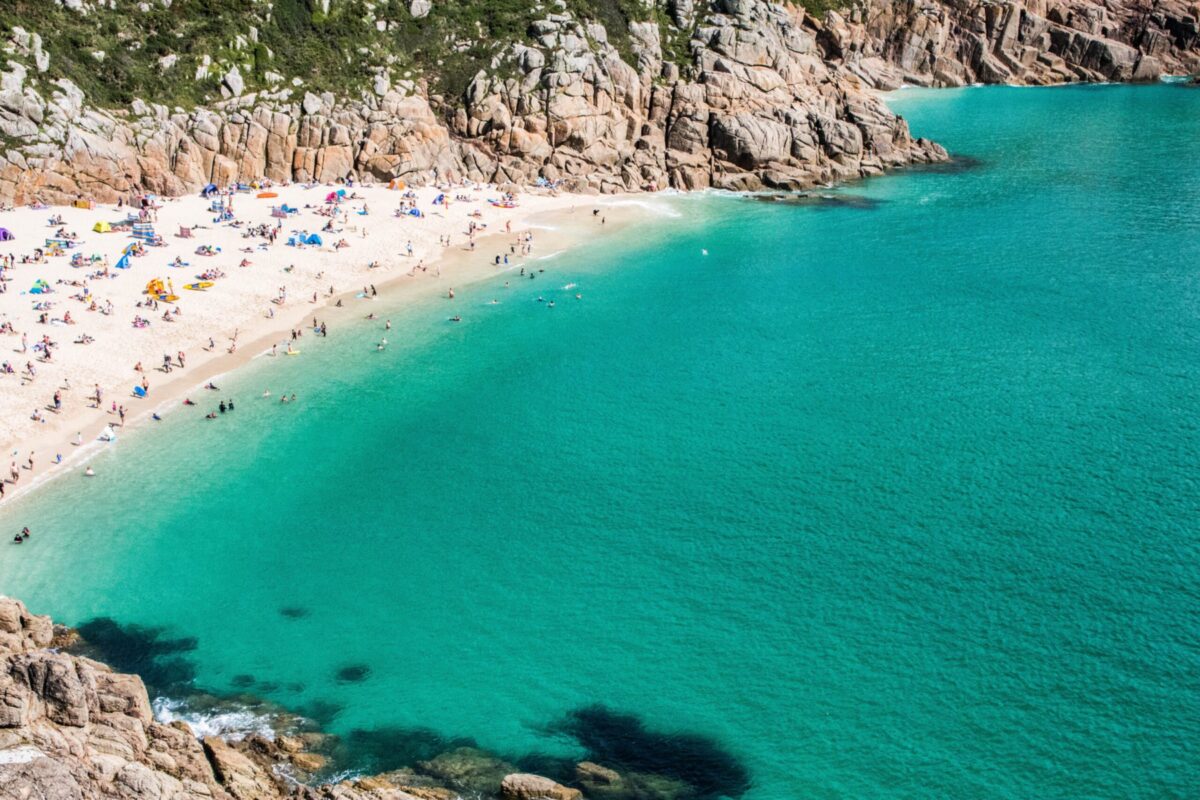
Footwear for Europe
- Shoes – Choosing travel shoes for Europe is relatively simple. Unless you’re doing a lot of proper hiking, a comfy pair of sneakers or walking shoes will more than suffice. If you’re travelling somewhere cold, wet or snowy, consider waterproof shoes for added protection against the elements. Black or dark-coloured shoes are best as they can pass as semi-formal if required. One pair of closed-toe shoes is usually enough for most trips to Europe! However, if you’re tackling some proper hikes, you might want to consider a pair of hiking boots or rugged hiking shoes.
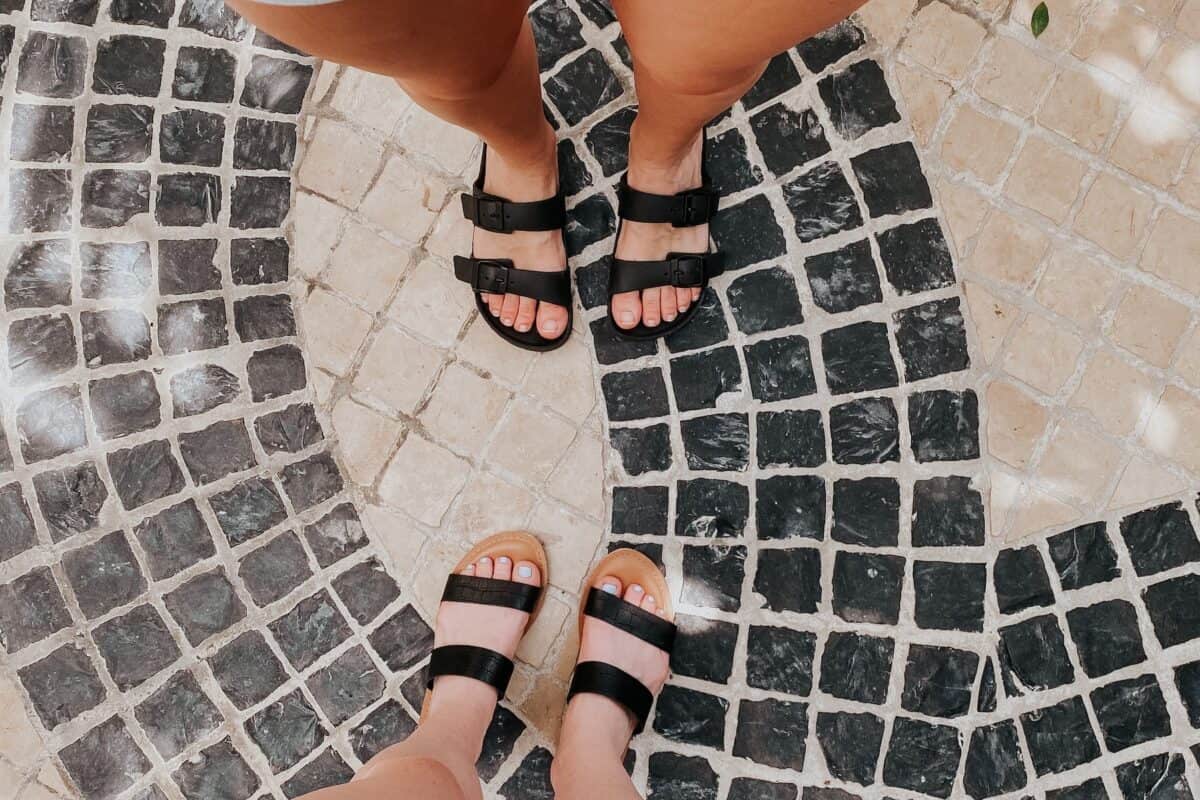
Tropicfeel Shoes
Tropicfeel make comfortable, lightweight shoes for travel. They're versatile, easily replacing 2-3 regular pairs of shoes from your backpack!
- Sandals – Whether you’re at the beach or wandering around Europe’s most romantic cities in summer, sandals are an ideal choice for keeping your feet cool! For most people, 1-2 pairs of sandals is more than enough. Just make sure they work with multiple outfits!
- Flip-Flops – An alternative to sandals, flip-flops are a good choice for beach days or shower use if you’re staying in a hostel!
Accessories for Europe
- Buff – Buffs are excellent travel accessories that should be on every packing list for Europe. In summer, they protect you from the sun and help wick sweat away from your skin. In winter, they protect you from the cold.
- Scarf/Sarong – Scarfs and sarongs are up there with some of our favourite accessories for Europe. They’ll keep you warm in the winter and offer protection from the sun in the winter. You may want to carry a sarong if you’re visiting religious sites as you can use it to cover your legs or shoulders if there are particularly conservative rules in place!
- Hat – Whether it’s hot or cold, there’s a travel hat for you! Woolly hats, beanies and bobble hats are all ideal for travelling to Europe in winter, while caps and sun hats are perfect for a summer trip to the continent!
- Gloves – It’s no secret that vast swathes of Europe get cold in winter. Protect your hands with a good pair of gloves. They don’t need to be thick – even lightweight travel gloves make a big difference!
- Water Bottle – A reusable water bottle is a must-have travel accessory. Throughout most of Western Europe, tap water is safe to drink. This means you can fill up your water bottle from wherever you’re staying, so you don’t need to waste money (or single-use plastic) on buying bottled water every day! If you don’t have much room in your bag, consider a collapsible water bottle , like the Platypus Soft Bottle or Vapur Anti-Bottle , they fold or roll down super small when not in use.

- Filtered Water Bottle – While much of Western Europe has safe drinking water, that’s not always true in Eastern Europe. Rather than take a standard reusable bottle, opt for a filtered bottle instead, so you can create your own clean drinking water from any source! Our favourite water purifying bottle it the Grayl UltraPress !
- Travel Towel – Lightweight, absorbent and quick drying, a travel towel should be in your bag for every trip. They can be used at the beach, at the pool or just to dry off after a shower at your hostel.
- Money Belt – While Europe generally has an excellent reputation for safety , certain parts of the continent are well known for pickpocketing and petty theft. Rather than fall victim to this, opt to wear a money belt , or an alternative secret stash , to keep the bulk of your money and belongings safe from thieves.
- Face Mask – While some countries have completely forgotten a pandemic ever happened, others are still enforcing mask-wearing on public transport and in some public spaces. Keep a face mask to hand in case you need it while on the road.
Electronics to Pack for Europe
- Phone – This one pretty much goes without saying. We all tend to carry our phones without even thinking about it anyway. But a smartphone is an amazing piece of travel gear. It allows you to connect to the internet (either via WIFI, a local SIM or an eSIM ), translate words or phrases and work out money conversions on the fly. Plus, a smartphone can be both your camera and entertainment device, with games, podcasts and streaming services!
- Camera – Cameras are great, I love travelling with mine. However, unless you’re a keen photographer or are trying out a new skill, you’ll likely get just as good (if not better) photos from your phone – have you seen the camera on the new iPhone?! 🤯
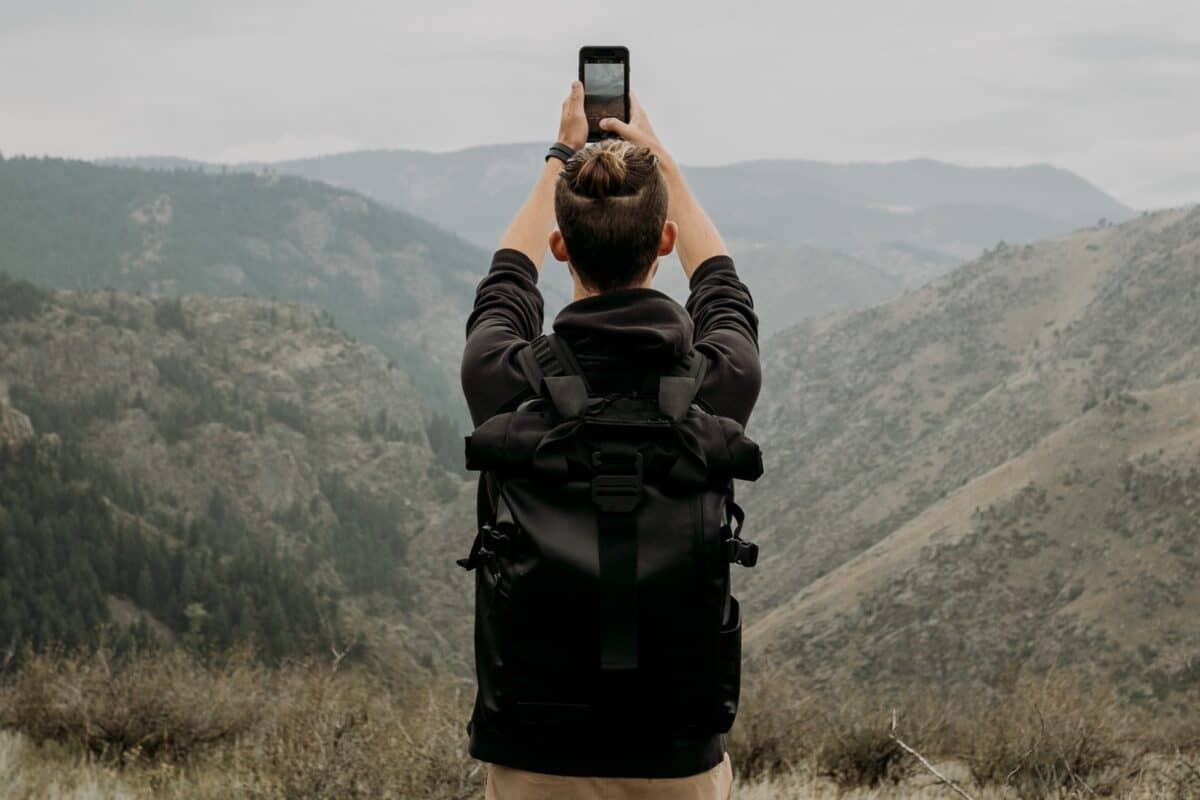
- Laptop/Tablet – Not everyone likes travelling with a laptop. Even lightweight options are heavy and take up a load of room in your bag. Plus, some of us like to disconnect when we travel. If you don’t need a laptop but still want a screen bigger than your phone, opting for a tablet is a good compromise. They’re lighter, easier to pack and can do almost everything a laptop can!
- E-reader – an e-reader, such as a Kindle , Nook or Kobo , is an excellent addition to any traveller’s backpack. E-readers can store thousands of books and e-books are much cheaper to buy than their physical counterparts – what’s not to love?!
- Powerbank – Electronics need charging and sometimes you’re nowhere near an outlet. Having a power bank means you can keep your phone charged if you’ve got important documents saved on there, or keep your e-reader chugging along, so you can read your way through an entire flight!
- Relevant Cables – Don’t leave home without all the necessary cables for your electronics! While most can be found abroad, it’s a hassle if you have to spend the first day of your trip searching for a charging cable.
- Universal Adapter – Not all power outlets are the same as at home. Having a universal adapter means you don’t need to worry about getting separate adapters for each country you visit!
- Travel Insurance – You’d be foolish to travel without good travel insurance . From losing your luggage to breaking an arm, the right travel insurance will protect you financially from all manner of things that can go wrong while on the road.

SafetyWing Nomad Insurance
SafetyWing is the travel insurance of choice for scores of backpackers!
- Subscription style insurance
- Cheap and flexible
- Available after your trip has started
- Torch – While smartphones tend to have a torch as standard, carrying a separate torch for travel is a good idea. You can use them to illuminate a dark street, navigate a dorm room at night or find your way to the trailhead pre-sunrise!
- Headphones – Whether you prefer your headphones wireless or still crave the nostalgic feeling of a cable, pack at least one pair of headphones for your trip. That way you can listen to music or podcasts whenever you want and watch Netflix in the evening without disturbing your dorm mates!
- Money – Get some local currency before you leave home – but not too much. Just enough to get you from the airport to your accommodation. ATMs are everywhere in Europe and you’ll often find it’s cheaper to withdraw money than convert it from your home currency. This is especially true if you opt to use a travel card for Europe – these tend to have no or limited fees for withdrawing money abroad!
- Personal Medication – If you take meds regularly, you’ll need them while you travel! Make sure you’ve got enough and know how to travel with prescription medication .
- Soap/Shower Gel – Not all accommodation options provide soap or shower gel. Make sure you’ve got a small stash (flight sized) to take with you! Soap bars are a good option because they don’t take up your liquid allowance on the plane!
- Shampoo and Conditioner – If you use shampoo and conditioner regularly, make sure you’ve got some travel bottles ready to go! As with soap, shampoo and conditioner bars are an excellent choice for travellers!
- Toothpaste – It’s rarely supplied, so bring some with you – you’ll likely need to pick up some more as you travel but it’s easy to find in any shop or supermarket in Europe!
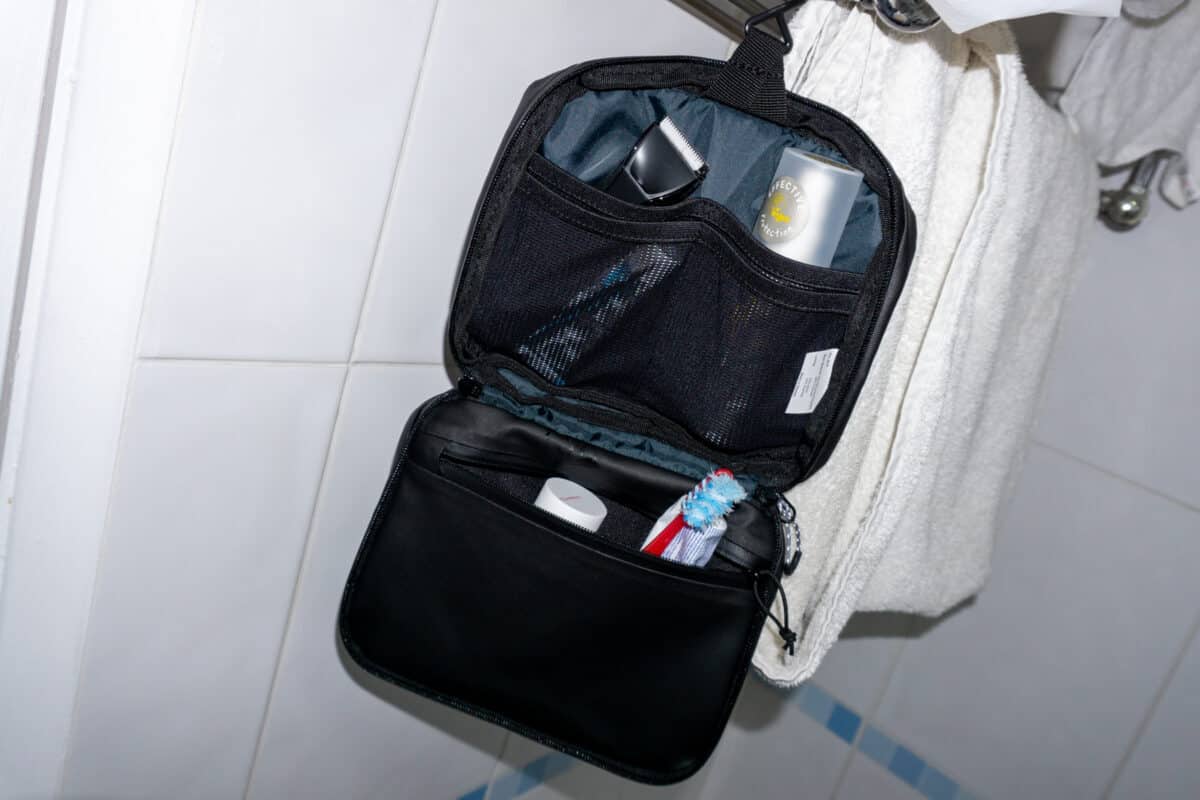
- Sanitary Products – While tampons and sanitary towels are easy to find throughout Western Europe, your choices may become more limited if you get too far off the beaten track. Make sure you’ve got what you need. And if you’re interested in reducing waste as you travel, consider buying a menstrual cup !
- Lip Balm – Long flights and days out in the sun can dry your lips out. Lip balm with SPF protection should be on every traveller’s European packing list!
- Hand Sanitiser – Even in a non-pandemic world, hand sanitiser is a must for travellers. It means you can clean your hands when there’s no soap in the bathroom and helps prevent you getting ill while on the road!
- Suncream – Especially important if you’re travelling in summer or spending a lot of time outdoors, suncream protects you in both the short and long term!
- Moisturiser – If you’re travelling somewhere particularly cold or dry, or spending a lot of time outdoors, a tube of moisturiser is a welcome addition to your packing list!
- Makeup – For those who wear it, don’t travel without your makeup! It can be expensive to replace in Europe!
Where to Buy Travel Gear
If you travel a lot, you’ll likely have most of what you need already. There’s no point buying new stuff just for the sake of it. Save the money for a cheeky beer or two on the road instead!
However, if you do need to go shopping for new gear, these are our favourite places to do it.

- A huge range of travel and outdoor gear on offer
- Excellent prices and feature some of the world's top brands
- Easy-to-navigate website

- A disruptive company changing the face of travel brands
- Produce everything from travel shoes to clothing and backpacks
- One-stop travel brand

- Well known and well-respected backpack brand
- Offer luggage options for every type of trip
- Well-priced – high-quality gear
But they’re not the only places. You can often find most of what you need in your local supermarket or shopping mall!
Things to Consider When Packing for Europe
When you visit Europe will have an impact on what you need to pack. You don’t want to pack for long, hot days at the beach if you’re visiting in the middle of winter! Likewise, packing a bunch of jeans and jumpers for a summer trip to Europe will weigh you down with items you’re unlikely to need!
Pay attention to the time of year you’re travelling and research average weather conditions for your trip. This will give you a good idea of what clothes you’ll need!
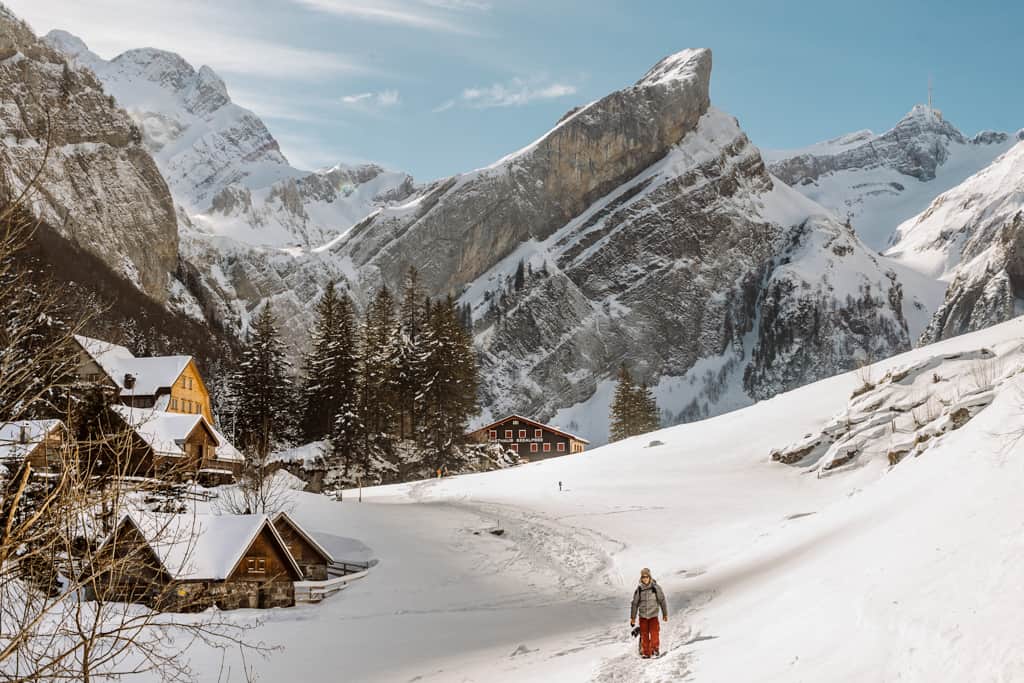
As important as the season you’re travelling in is the destination you’re visiting. Summer in Southern Spain is very different to summer in Iceland . And winter in Scotland throws up a very different set of conditions to winter in Southern Italy . Make sure you know what the conditions will be like at your destination when choosing what to pack for Europe!
Activities
Pack for your activities! If your trip revolves mainly around chilling on the beach, pack plenty of beach clothes. But if you’re heading into the mountains for some serious hiking, your bikini and swimwear will be of little use.

You don’t need to pack a fresh outfit for every day of your trip. Laundrettes are common in many European cities and if you can’t find one near you, hotels and hostels in Europe frequently offer a laundry service!
Length of Trip
While the amount of clothes you need for a two-week or two-month trip is the same, versatility becomes more important for a longer trip – especially if you’re travelling between different countries, climates and seasons!
Versatility
It doesn’t matter where you backpack, choosing versatile clothes and travel gear is always a good idea. By packing items with multiple uses, you can reduce how much you need to carry. A good long-sleeved top can be used for insulation on cold days and sun protection on hot days. Likewise, a universal plug adapter can be used all over Europe and even in the UK – meaning you don’t have to carry multiple adapters for a trip to multiple countries!

If you’re travelling in winter or somewhere particularly cold, don’t pack a massive jumper or coat. Instead, bring a series of thinner items you can layer together. They’re easier to pack and offer much more versatility than one bulky item!
Packing List for Europe – A Round-Up
With this list of essentials for European travel, you’ll be well set to enjoy your travels without worrying about what’s in your bag! Of course, every person is different and this packing list is only a guide. Add and remove things to customise the list for you!
Europe is a wonderfully varied continent – get out there and enjoy it!
What additions would you make to this packing list for your trip? Let us know in the comments below!

Tim Ashdown | Writer and Gear Specialist
After a life-changing motorcycle accident, Tim decided life was too short to stay cooped up in his home county of Norfolk, UK. Since then, he has travelled Southeast Asia, walked the Camino de Santiago and backpacked South America. His first book, From Paralysis to Santiago, chronicles his struggle to recover from the motorcycle accident and will be released later this year.

Thoughtful Travel Experiences

The guide to ultimate Travel Essentials for Europe packing Checklist
Many guides tell you what to pack for Europe, but through this one, we’ll show you how to pack your travel essentials for Europe trip. It’s natural that we want to prepare well because preparation lets us make the most of every moment.
So, we stress out and pour over so many blog posts, articles, and guides in hopes of finding practical advice. This can get overwhelming especially for first-timers because of the surplus of resources. We also end up a lot more confused because they all tout to be the ultimate checklist.
But you don’t need to stress because it really just boils down to what’s essential and what’s not. Meaning, what’s relevant to you and the kind of trip you’ll be going on.
What Are Europe Travel Essentials?

Merriam-Webster defines essential as something that’s basic, indispensable, necessary . Something that’s so important your trip won’t happen or won’t roll out well.
Examples of necessary, indispensable, and basic travel essentials are:
- Visa, money, travel insurance, clothes, and travel advisory knowledge.
Why should you include these in your things to pack for Europe? Here are a few Europe travel tips that will help you get the principles behind essential and non-essential.

The Schengen Visa is your document for entry to European countries in the Schengen area. Entry isn’t possible without it. Northern region countries like Denmark, Finland, and Sweden require a Schengen Visa. Southern region countries such as Italy and Spain require this visa too.
But you won’t need a visa for entry if you’re from a country who has an agreement with the European Union (EU) for a visa-waiver. Read more about Schengen Visa requirements on the European Commission’s official website .

Opinions vary whether travelers should purchase Euros before the trip or simply withdraw via ATM upon arrival. A good rule of thumb is to have enough cash to get you by. Pro Europe travel tips are bringing cash and your credit card too.
Bring cash that’s at least a day’s worth of meals and transportation in case the ATMs or your credit card won’t work. Then upon arrival, withdraw in local currency using the ATM. Use your credit card to pay for larger expenses like hotels and restaurants.
Additionally, make sure your cards (ATM and credit) are activated or eligible for international use so you can withdraw and swipe without hassle.
Travel Insurance

This will cover the costs of any mishap that may occur (that’s included in the policy) like accidents and hospitalization, lost or stolen items. An insurance is a travel essential you’d want to keep handy so you’ll always be ready.
If you travel without one and then something unexpectedly happens, you might end up spending your budget on those mishaps. Save your money and spare your piece of mind by letting a travel insurance cover you for those.
Seasonal Clothes

Packing the right kind of clothes for the season will determine how much you’ll enjoy your trip. The chill factor of winter is different from the climate of fall.
And so is the breeze of spring different from the balmy weather of summer. You’d want to have the appropriate clothes in your travel essentials so the weather won’t get to you. But rather, add enjoyment to you and your trip.
Travel Advisory Knowledge
Get to know the European Commission’s latest travel advisory . Travel advisories are like your Europe travel guide, they update visitors about official tourism information about the country. Knowing the allowed activities will help define what items you’ll need to prepare for your Europe travel revenge.
You’ll also get to know what countries are allowed for non-essential travel to Europe. And also, the specific travel guidelines of each European country.
- Check out the European Commission’s website for these. It’s best to get info from an official source.
- Additionally, visit the Re-Open EU website. This is the European Commission’s official website that gives travel advisories for the European Union’s reopening. Updates are per country. Just click the dropdown list, choose the country, then you’ll find the travel advisory of the country you’re visiting.
Travel Essentials for Europe Starter Pack
In this section, we’ll share Europe travel essentials in context of its top destinations. We’re sharing these Europe travel tips because we want to set you off on a great start. Let’s go!
Northern Europe
Southern europe, western europe, eastern europe.
As you choose what to pack for Europe, keep in mind the European country you’re visiting because each one’s local setting has its own needs. Bring this together with the country’s current season or climate and this will help you narrow down to only the most essential.

Northern Europe Top Destinations : England, Scotland, Norway, Iceland, Sweden
This region is where you’ll find the Northern Lights, the London Bridge, the Midnight Sun, endless hills to ski, beautiful fjords and landscapes amidst bustling modern cities.
Being up in the north makes these countries really cold during spring and winter so make sure to bring layers like coats, jackets, gloves, and sweaters to keep you warm. Remember to pack clothing items that are neutral in colors as well to blend in with the European fashion style. Pops of color are alright as long as they’re in taste.
Umbrellas and rain jackets are a must too because these areas experience moderate amounts of rain.
- Wind-breaker jacket, rain jacket
- Coats, gloves, warm jackets, thermal tops and pants, long sleeves
- European power adapter
- Sturdy city boots or hiking boots
- Comfortable and stylish loafers, boat shoes, ballet flats
- Light-weight backpack for nature trips, stylish daypacks for the city, backpacks you can wear in front
- Sunglasses, sunscreen

Southern Europe Top Destinations : Greece, Italy, Portugal, Spain, Croatia
Southern Region offers a Mediterranean Europe travel experience that indulges you with fresh seafood, turquoise waters, warm summers, and mild winters.
Things to bring for Southern region involve a more relaxed checklist for the warm enjoyable weather. Include your trench coat, gloves, jackets, and boots if you’re visiting during winter.
- Sunscreen, sunhat, umbrella
- Stylish sandals, loafers, walking shoes and flats
- Plain tops and bottoms in neutral colors, avoid shirts with graphic logos
- Beach wear: shorts, swimsuits
- Power adapter, power strip
- Light scarves, sweaters

E astern Europe Top Destinations : Hungary, Poland, Russia, Romania, Czech Republic
Eastern Europe is where you’ll find Europe top destinations like Budapest in Hungary, Russia’s historical and richly cultural St. Petersburg, and the fascinating architecture of Prague at the Czech Republic. Art, history, culture, and panoramic nature scenes greet you in Eastern Europe.
Eastern Europe enjoys a continental climate where winters are colder compared to other its Mediterranean counterparts. But summers enjoy some heat too which makes for pleasant walks around the city.
- Jackets: Parka, hoodie jacket, down jacket, insulated jacket, rain jacket
- Dark or neutral-colored t-shirts and dress shirts, long sleeves, slacks
- Sunhat, sunscreen
- Beanie hat, ear muffs for winter
- Sandals, ballet flats, comfortable dress shoes
- Walking shoes
- Hiking boots, snow shoes
- Thermal socks
- Daypack or small backpack you can wear in front

Western Europe Top Destinations : France, Germany, Austria, Belgium, Switzerland
Home of the iconic Eiffel Tower, the majestic Swiss Alps, the medieval architecture of Belgium, and the awe-inspiring blue mountains of Austria. Western Europe enjoys a generally mild climate throughout the year in its cool summers and comfortable winters. You’ll get to enjoy warmth and chill in Western Europe.
You might notice that the list will contain clothes that are a notch higher than the usual casual. It’s because the locals’ way of styling in Europe is a bit dressier than normal.
Blend in like one by dressing up in classic shades, staples, and shoes. It will be good for the pictures too! Additionally, having a light carryon daypack will make transit in between cities easier as you tour Eastern Europe.
- Dress shirts, slacks, elegant dresses or outfits
- Sweaters, cardigans, scarves, neutral-colored t-shirts, pants, jeans
- Dress shoes, pumps, stylish walking shoes
- Rain jacket, umbrella
- Water bottle
- Power adapter
So there you go, travel tips and travel essentials for Europe trip! We hope you learned a lot from this article. Bon voyage! You got this! If you have any ideas to share on travel essentials or travel experiences, please share them in the comments below or contact us
Leave a Comment Cancel Reply
Your email address will not be published. Required fields are marked *
Save my name, email, and website in this browser for the next time I comment.

The Ultimate Packing List for Europe: What to Pack for Your Trip
Planning a trip to Europe and wondering what to pack? Don’t miss this complete packing list for Europe – with key essentials and seasonal additions to help you plan your trip.
Packing for Europe is a tough call and getting your packing right is going to depend on a lot of different factors.
How long are you going for? Are you travelling with checked luggage or carry on only? Which season are you going in?
That’s a lot of questions right there – I can already feel you starting to give in to the temptation to shove a whole load of stuff in and hope for the best.
Step away from the luggage. There’s no need to panic, or to pack everything – making your case so heavy that you can barely pick it up.
This Europe packing list will walk you though:
- What to pack for Europe
- Additional things to consider when packing for Europe in the Spring/ Summer / Fall and Winter
- Practical tips to help you ensure you don’t pack too much
In short – everything you need to pack efficiently, conveniently and stylishly for your Europe trip.
What to Pack for Europe
Packing essentials for Europe at any time of the year.
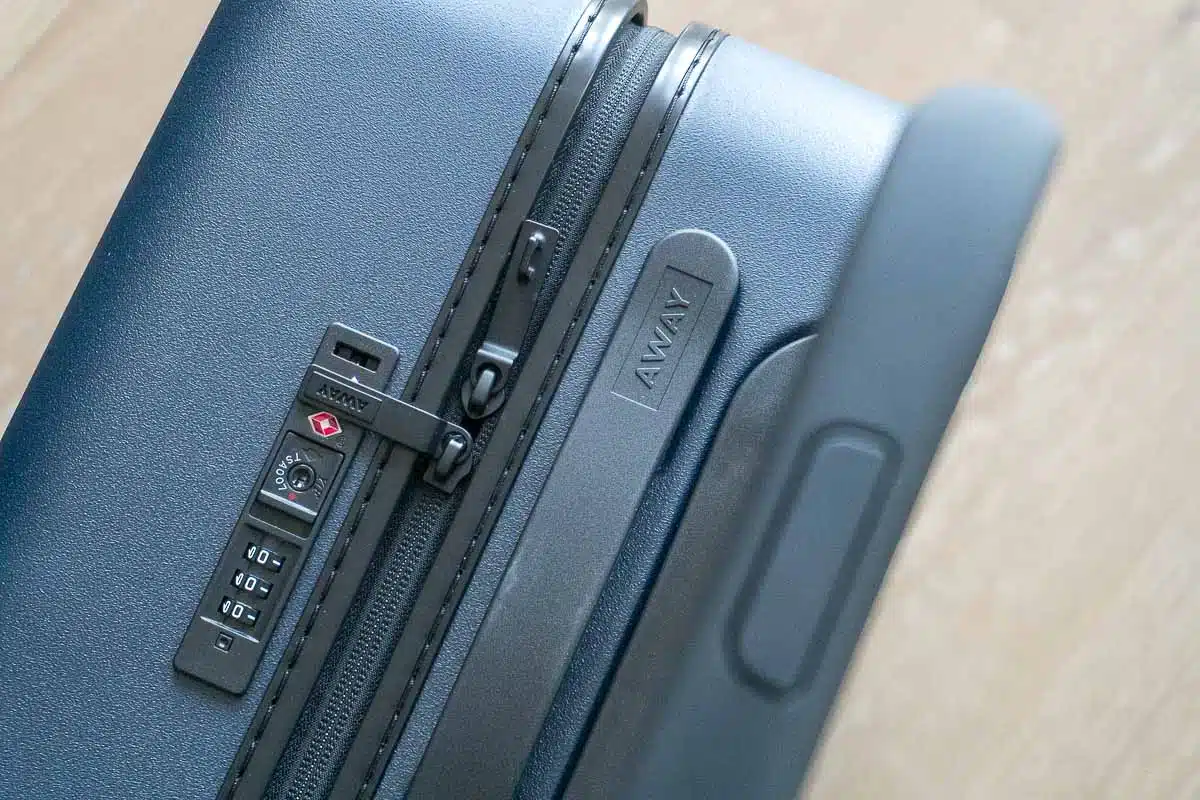
You might think that starting a packing list talking about luggage is a bit of a hot take, but hear me out. Luggage can make or break a trip, so you’ll want to choose carefully. Convenience and durability are two big factors you need to consider before you set off.
So what luggage should you use? I’ll do a quick breeze through the pros and cons of the main options below.
Rolling Suitcase
A rolling suitcase is super convenient to roll around places like the airport, and put way less strain on your back.
The downside of rolling suitcases for Europe is that historic cobbled streets just weren’t made for this modern invention. Anyone who has undergone the mortifying shame of your suitcase clack clack clacking along a street for what feels like eternity knows what I’m talking about.
That said, I tend to travel with rolling suitcases these days because they’re so easy to get around with. Pick a hard-shell case to protect your belongings.
Recommended
- Away Carry On (read my full review here)
- Level8 Textured Carry On ( read my full review here)
Convertible Backpack
I love the convenience of a backpack but really can’t go past the style factor of a nice rolling case. The solution? A convertible backpack.
With these, you can wear them as a backpack or change it up to roll like a suitcase. Options are always good when travelling and I love a smart design like this.
Recommended
- Osprey Transporter
- Eastpak Tranverz
Packing Cubes
I’m not sure how I didn’t discover packing cubes way earlier. I can only imagine how many packing-related frustrations could have been avoided if I had.
Packing cubes are lightweight and keep your suitcase in Marie Kondo organised perfection. You’ll be able to find everything you need in a jiffy, and it helps you to fit more into your suitcase.
Recommended
- AmazonBasics Packing Cubes
A good daypack is definitely a must on your Europe trip packing list. This is especially the case if you’re planning on doing any hikes.
A good daypack is light, with straps that are comfortable and distribute weight evenly. You’ll also want to have a peek inside to make sure it’s keeping everything well organised.
- Herschel Retreat Backpack
- Osprey Daylite
A handbag is definitely on my list of things to pack for Europe. A great bag is the perfect addition to any outfit, and it keeps things stylish.
Consider security when it comes to handbags. Pickpocketing is an issue, especially in large cities, so you’ll want something that can be secured.
Reusable Canvas Bag
Plastic shopping bags are so 2015. Around the world, more and more countries are banning single-useplastic.
Even where they’re not banned, they can still wreak havoc on the local environment. Do your bit and bring along a canvas bag instead.

I know, I know – this is the part of any travel packing list for Europe that causes the most headaches. You want to look your stylish best, without bringing your entire wardrobe.
Firstly, take a look at the general weather trends so you know what kind of conditions you’ll be dealing with. Then set about putting together a wardrobe.
I’m a big fan of capsule wardrobes, where a small number of pieces go together in many different combinations. It’s a quick and easy way to look super stylish on the road.
I recommend bringing a handful of tops in fairly neutral colours and patterns. While I’m a big fan of loud clothing, you don’t want to waste too much time trying to find things that match.
You’ll also want to bring a selection of short and long sleeves, especially if you’re travelling in spring or fall.
Skirts
Ahhhh, what says “stylish Europtrip” more than a beautiful, billowy skirt. They’re comfy, stylish and super versatile as well.
I love a maxi or midi skirt, however depending on your style and the length of your trip, you might like to throw a mini in as well.
Dresses
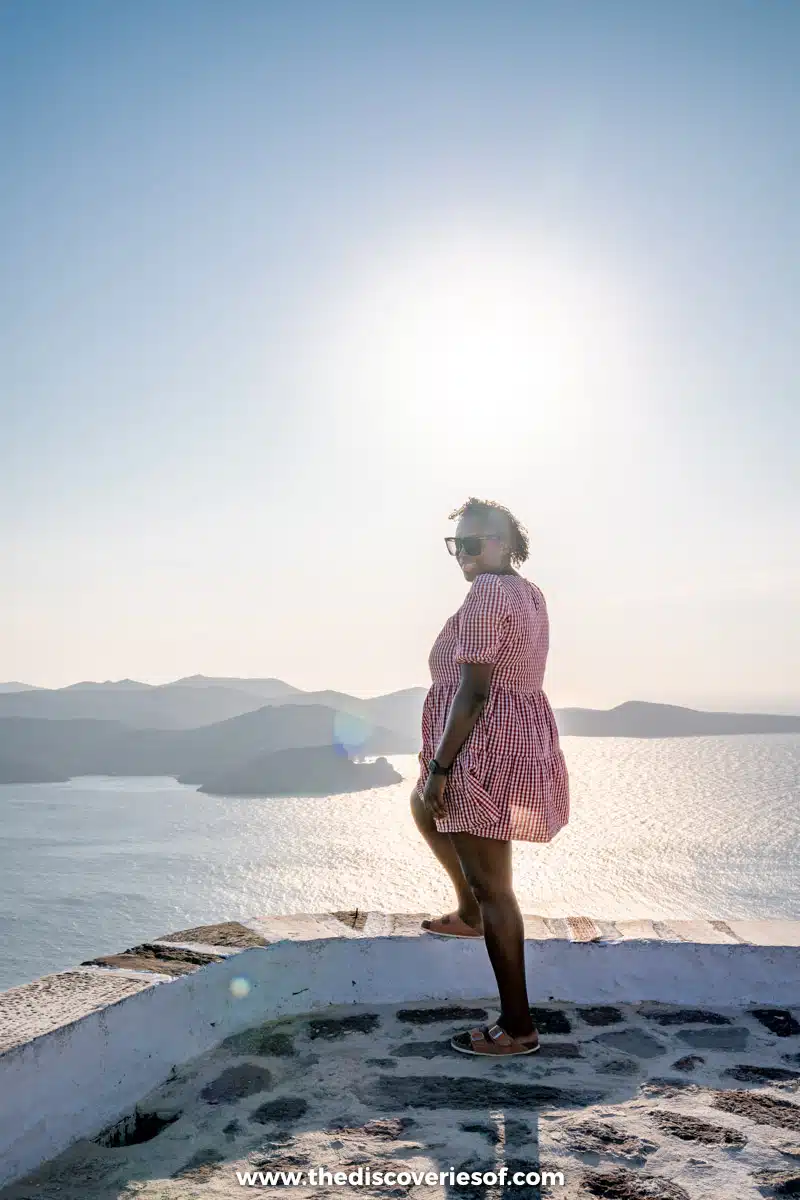
Like skirts, pretty dresses are a staple of pretty much every packing list for Europe in summer. They’re so easy to wear and look gorgeous as well.
I like to bring at least one casual dress, but it’s ideal if you also bring something that’s easily dressed up or down.
Trousers and Pants
Trousers and travel pants are definitely a must for your travel list for Europe. Jeans are the perfect addition to any casual outfit, while loose trousers are also ideal for hiking or more active pursuits.
Outerwear is a definite must in Europe. Even if you’re considering heading to Europe in spring or summer, you’ll still want to add in a jacket or two in case of any chilly days.

Be sun smart, kids! Not only are hats important to stop yourself getting burnt (no one wants to look like a lobster in their holiday snaps) but they are also super stylish.
My pick is a wide-brimmed hat. They get maximum marks in the style and the practical departments.

Let’s be honest, hitting the beach or hotel pool is pretty much non-negotiable for a fabulous summer trip. So you won’t want to forget your swimwear.
What you choose is pretty much up to you and your style. Just make sure you’d tried it on beforehand and that it makes you feel fab.
So travel socks are not the sexiest thing you need when travelling to Europe, but they are important. Travel socks can help you stave off baddies like DVT or blisters, while also keeping you warm and comfy.
They’re especially important if you’re planning on doing any hiking or a lot of walking (which is pretty likely).
Don’t underestimate the importance of some comfy undies for your trip.
I recommend bringing plenty, as they don’t take up much room and you don’t want to be doing your washing every couple of days. There’s way more fun things to do than that.
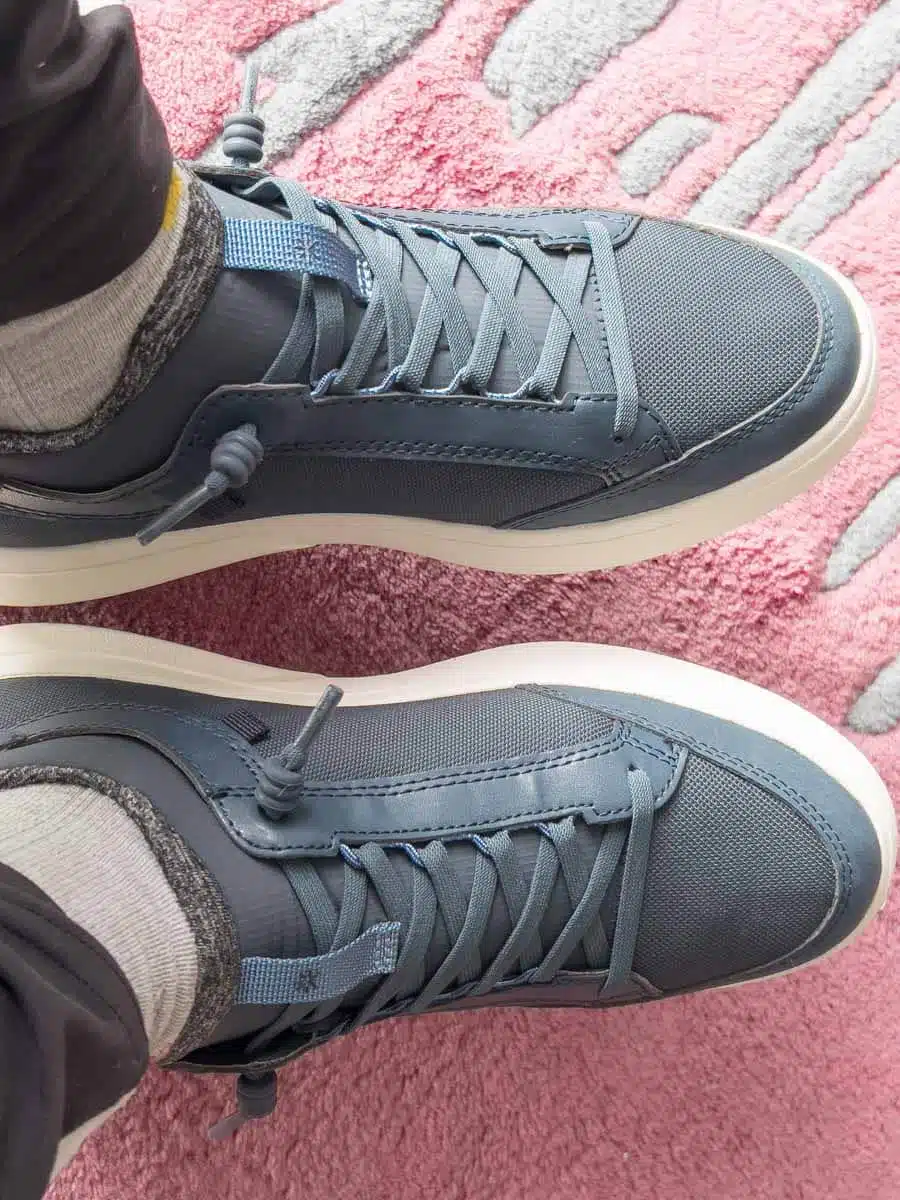
Footwear can be a difficult one when considering what to pack when travelling to Europe. They’re a definite must, but they can take up a lot of room – so choose wisely.
Comfortable Travel Shoes / Trainers
Nothing ruins a day exploring an amazing city quicker than getting a blister. That’s why I never leave London without a pair of comfy travel shoes or trainers in my bag.
I’m a huge fan of Tropicfeel’s Geyser trainers for cooler months – they’re great for walking around the city but are great hiking trainers for hikes where you don’t need much ankle support. I use the brand’s Canyon trainers during the warmer months.
- Tropicfeel Geyser
- Tropicfeel Canyon
- Allbirds Tree Runners
The Full Lowdown on Tropicfeel’s Geyser Trainers
Stylish Travel Shoes
Just as important as a comfy option is a pair that make you feel fabulous as soon as you put them on. Whether it’s a pair of gorgeous boots or maybe your fave heels (that you can walk in easily), you can consider adding in a pretty option.
There’s no point in me lying, I do not bring pretty shoes when I travel anymore, I just think they take up too much space for very little use, but I tend to err on the scruffy side of things, so you can make your own decision.
Hiking Boots / Sandals
If you’re planning on hiking then some proper boots or sandals are a must. They are comfy and help protect you from slipping and hurting yourself.
Boots are a classic option, but if you’re travelling in summer you might prefer to opt for some lighter hiking sandals.
Merrell Women’s Hiking Boots: Comfortable high rise hiking boots with good ankle support and grip for keeping you safe on those adventures
Useful Items

There are a whole raft of items that should make it onto the best packing list for Europe, but often don’t.
We’ve all grumbled as we’ve paid an extortionate amount for something at the airport – so save money and buy it ahead of time if you think you’ll need it.
Travel Towel
A must-have if you’re camping or staying in hostels where they’re not provided, but super helpful for any trip – particularly if you plan on swinging by a beach or two. They’re lightweight, small and can really help you out if you’re stuck without.
Dock & Bay Sandproof Towel: A cute, bright and beachy sand-proof towel. It folds into a small bag making it perfect for summer travels
Earplugs and Eye Mask
You’ll be so glad you brought these if there’s a crying baby on your flight or you find your hotel is perched above a nightclub. Plus they take up hardly any room.
Torch
If you’re camping or hiking then a torch is definitely a travel necessity for Europe. You don’t want to get caught out trying to find the bathroom with only your phone’s flash – so bring a small but powerful torch instead.
Refillable Water Bottle
Like plastic shopping bags, plastic water bottles are a big environmental no-no. Plus, it gets expensive to keep buying single-use water.
Instead, bring a decent refillable water bottle – a filtered one is ideal if you’re travelling to places where the tap water isn’t safe to drink.
Money Belt
The only person who should be spending your money in Europe is YOU. Make sure no dodgy pickpockets get their hands on it by using a discrete money belt.
Worn under your clothes, it’s the perfect place to store your valuables.
Gadgets + Electronics
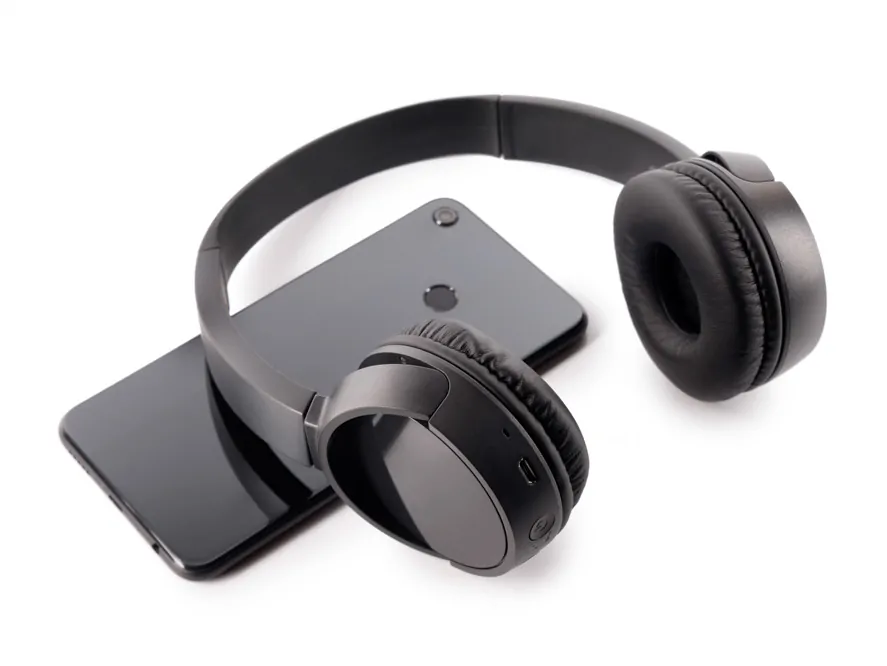
Who doesn’t love a good gadget while travelling? There are heaps that can make your life way easier – but you’ll also want to make sure you’re going to use them enough to make it worth the space they take up.
While some people say a smartphone is enough to take photos for your Euro trip, I’ve got to disagree. Nothing compares to a good quality camera, which will allow you to capture your amazing moments with a little more creativity.
Memory Cards
No packing checklist for travelling to Europe would be complete without some memory cards for your camera. I recommend bringing a few in a durable case, so you don’t need to delete them from the card.
Spare Batteries
We’ve all experienced the ultimate travel disaster that is realising our battery is flat in front of a beautiful attraction. Avoid this by bringing spare batteries and keeping them charged (but remember you can’t bring them in your hand luggage).
Travel Adapter
I can’t tell you how many times I’ve forgotten this and ended up paying double at the airport. Avoid this and make sure you bring along your universal travel adaptor – a good quality one will last you for years.
All in one travel adapter
External Power Pack
Avoid the disaster that is your phone going flat at an unexpected moment with an external power pack that can give your phone or other devices a boost. It’s especially ideal for long bus or train rides, hiking or overnight camping.
Anker Power Pack
Toiletries
While you can purchase anything you’ve forgotten, there are lots of toiletries to pack for Europe.
This includes; shampoo / dry shampoo, conditioner, toothbrush, toothpaste, deodorant, lip balm with sunscreen moisturiser and for the ladies, don’t forget your feminine hygiene supplies.
If you take any prescription medication, you’ll definitely want to bring them to Europe as it is difficult (and not always possible) to get refills.
I also recommend bringing a small medical kit with essentials like aspirin and plasters. Although most of these are available in Europe, it’s much easier to bring them yourself rather than
Avoid looking like a lobster while travelling in Europe, and protect your skin from long term damage. Sunscreen is a definite must for what to bring to Europe, and I recommend going for at least 50+ SPF for fair skin, 30+ for darker skin.
Travel Essentials for Europe
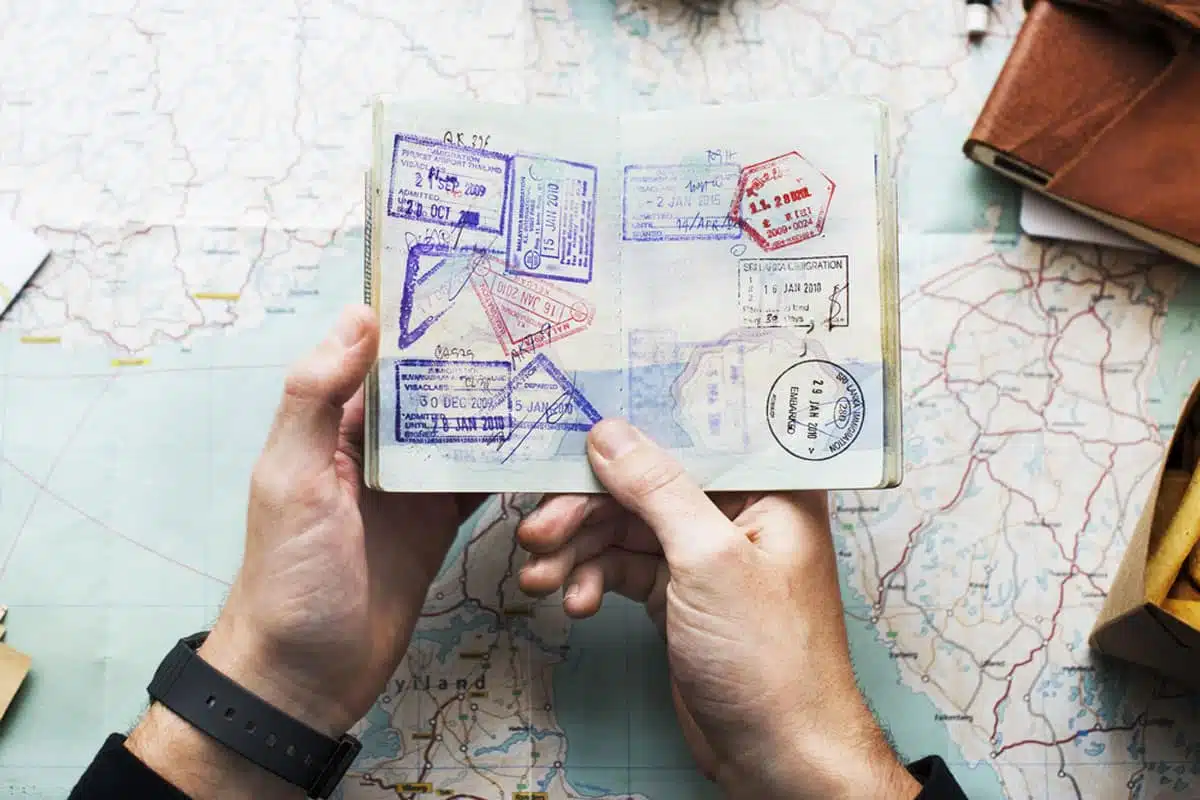
The ultimate packing list for Europe would not be complete without including all the absolute essentials. Without these items, you really aren’t getting far on your trip.
Passport / Visas
You aren’t even leaving the airport with these ones, so make sure you’ve got these sorted well before you fly.
While bringing your passport is pretty obvious, it’s a common travel mistake not to check the visa requirements before you travel. Don’t get caught out.
Travel Insurance
None of us want to think about anything going wrong on holiday, and hopefully it won’t. However, you’ll get lots of peace of mind knowing you’re covered in the event of lost luggage, cancellations or accident/illness. Insurance is a definite must for travel to Europe.
Cash / Credit Cards
Sadly, travel is not free so cash and cards are a must.
It’s worth looking into the best travel cards, especially if you are travelling for a few weeks. Ideally, bring more than one and keep them separate, for security reasons. Another security tip is to alert your bank that you’ll be travelling.
While card / Apple/ Google pay is widely accepted in Europe, I still recommend bringing some cash just in case. The cheapest way to do this is to get it out of the ATM once you arrive (away from the airport).
You might also like to bring a little bit that you’ve swapped at home – but keep in mind this is an expensive way to do it.
Tickets and Reservations
It’s common nowadays to just keep these on your phone, but I’ve definitely been caught out without battery or wifi. For that reason, I recommend bringing hard copies of important tickets and reservations just in case.
Emergency Contacts + Addresses
Like with travel insurance, chances are these will remain in your bag untouched. But it’s still a good idea to keep some information about who to contact in an emergency, just in case.
Copies of Important Documents to Keep Separate from Wallet
One of my most important packing tips for a Europe trip is to keep your most important documents separate from your wallet. This includes documents like your passport as well as, ideally, a backup credit card.
This way, even if your wallet gets swiped, you aren’t totally stuck and helpless.
Guide Book
What? A travel blogger recommending an old school guidebook?
Yep, I totally love a good guidebook. They give you a fab overview of a new place, and can be used even if you’ve got no ‘net. Of course, then you should check out my travel blog for more info.
What to Pack for Europe in the Summer

Are you wondering what to pack when going to Europe in summer? Overall, things are usually pretty warm, but you’ll still want to bring some options for the odd cool day.
Quick Dry Beach Towel
I love this invention. Gone are the days of lugging around a damp beach towel in your suitcase for days on end.
Sunglasses
Any practical or stylish packing list for Europe in summer should include a pair of sunglasses. They’re important for your eye health (not to sound like your Mum or anything), but they also look great with your outfit too.
The perfect addition to any summer wardrobe in Europe is a good pair of shorts. They’ll keep you cool and looking great – I’m especially a fan of the classic that is a pair of denim cut-offs.
What to Pack for Europe in Spring and Autumn / Fall
Layers .
If you’re considering a packing list for Europe in fall or spring, you’ll want to keep in mind the weather can be unpredictable. A great way to get around this is to pack layers like a lightweight jumper, which you can add or remove as necessary.
Rainproof Jacket
Rain is kind of a given in spring and fall in Europe, so pack accordingly. Like a good Brit, a little rain will never scare me off sightseeing – and a good rainproof jacket certainly helps.
A good one is light and folds up easily, meaning it won’t take up much room in your luggage.
As above, a little rain is no match for a sturdy umbrella. Make sure that rain doesn’t put a dampener (haha) on your plans by bringing a good brolly.
What to Pack for Europe in Winter
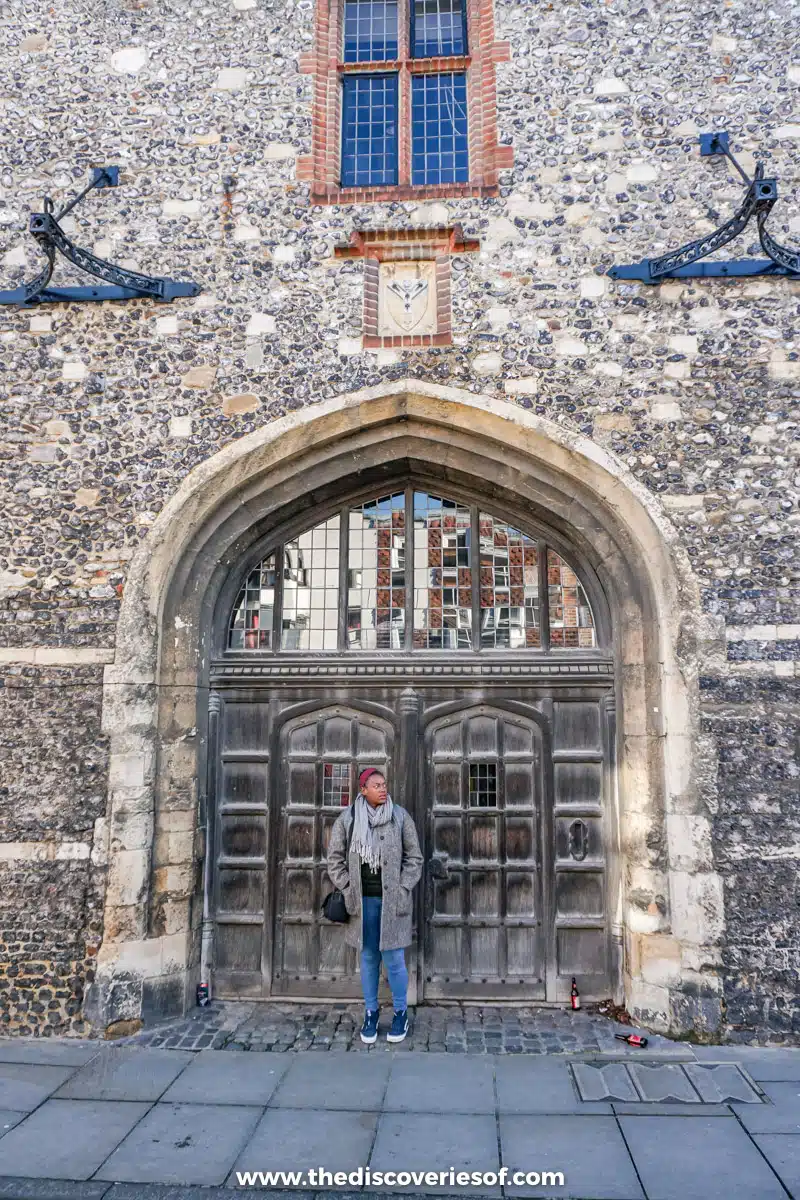
Thick Winter Jacket / Coat
Europe in winter is beautiful, romantic, and cold. Really cold. It’s therefore a must to bring a thick winter jacket or coat, so you’ll be warm (and stylish) even when it’s frosty outside.
I read once that you lose most of your body heat through your head… so make sure to put a cosy hat on it. It will keep you toasty warm, and they look super cute as well. Bonus points if it covers your ears from the chill.
Another must for your packing list for Europe in winter is a good scarf. I absolutely love scarves – not only do they do a great job in keeping you warm, but they also add some immediate charm and interest to your outfit.
A colourful one is a great way to instantly add some pizzazz to your clothes.
Gloves
A good pair of gloves is a must for any men’s or women’s packing list for Europe in winter. Don’t underestimate how much warmer they’ll keep you – you don’t want your fingers going all numb and tingly while wandering around a city. Gloves are a definite must.
Packing Tips for Your Europe Trip
- Versatility is key when choosing what to pack when going to Europe. I love clothes that all wear well together, as well as products with multiple uses.
- Organisation is really key to fitting everything in your suitcase and being able to access it easily. Avoid the nightmare that is having to throw everything out onto the floor, by packing in a sensible way.
- Although it’s tempting to leave packing to the last possible moment, I recommend doing it a day or two before you leave so that you’ll have time to realise if you’ve left anything off your Europe trip packing checklist.
Read More Europe Guides
- The Ultimate Europe Bucket List
- The Insider’s Guide to Travelling Europe
- The Best Places to Visit in Europe
- Stunning City Breaks in Europe
Love this? Save and Share on Pinterest
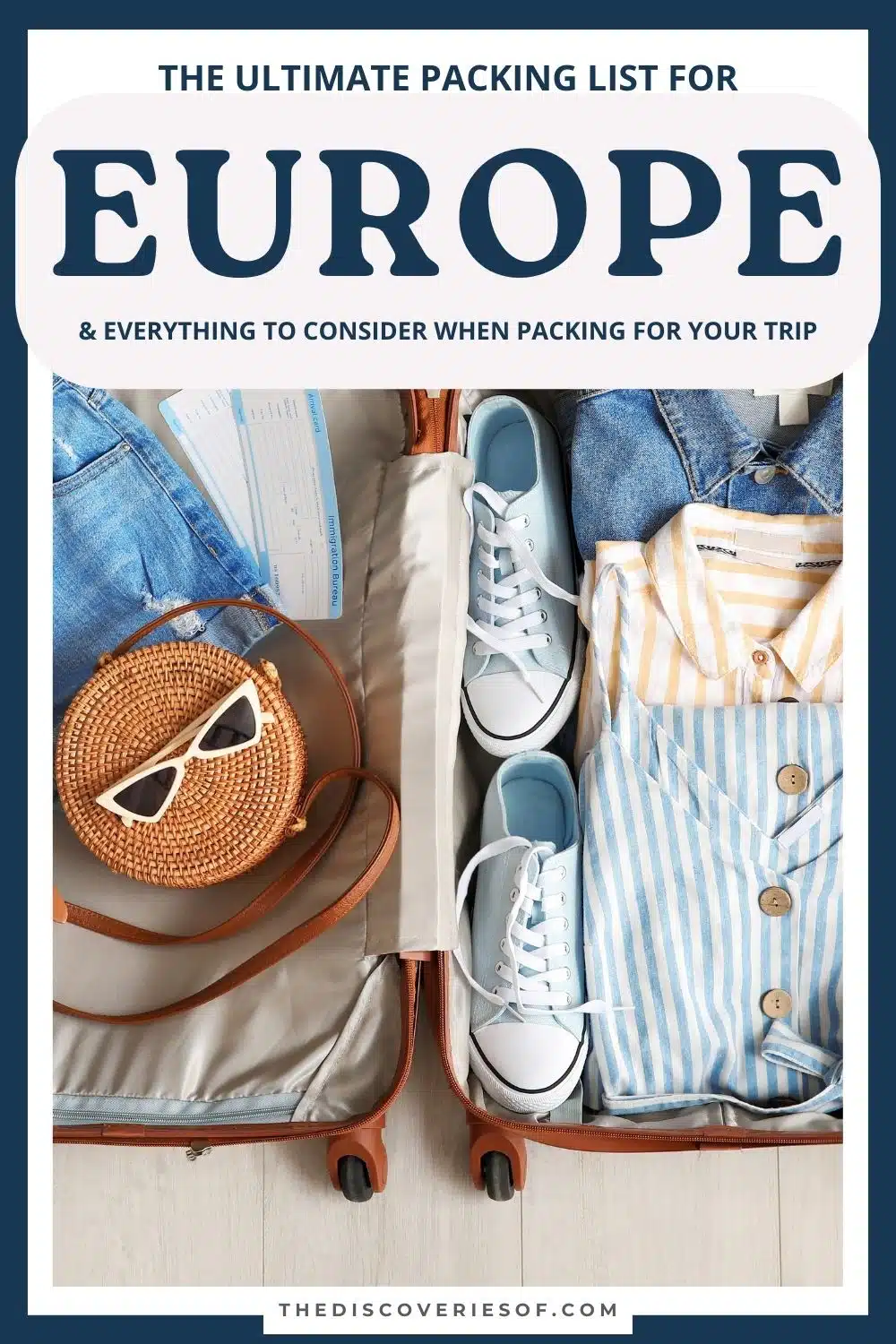
I’m Julianna Barnaby - a professional travel writer and geek extraordinaire. I started The Discoveries Of to help you to discover the best of new destinations from around the world.
Discovering new places is a thrill - whether it’s close to home, a new country or continent, I write to help you explore more and explore differently.
Related Posts

2 Days in Florence: The Perfect Florence Itinerary

30 Wonderful Landmarks in London You Have to See
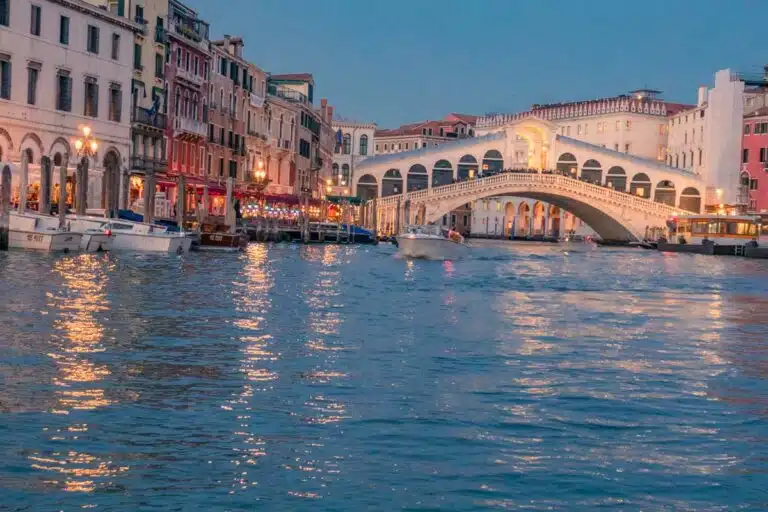
9 Famous Bridges in Venice
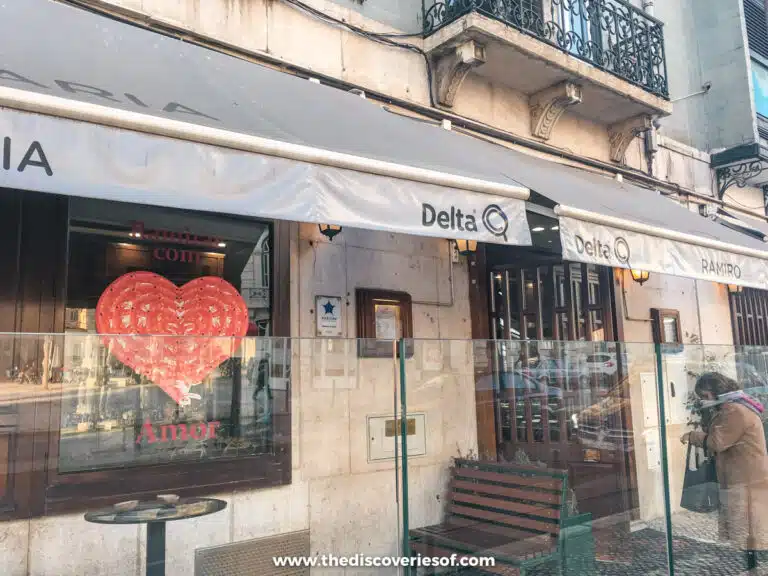
Cervejaria Ramiro Review – The Best Seafood in Lisbon
Leave a reply cancel reply.
Your email address will not be published. Required fields are marked *

Follow me on Instagram for travel inspiration, tips, and guides.

15 Europe Travel Essentials: Backpacking Europe Checklist

It can be overwhelming when traveling to Europe to make sure that you have all of the essentials you need for an international trip. This list of 15 Europe travel essentials will ease your mind and set you up for success on your upcoming travels! Use this as a checklist to make sure you have all of your Europe travel essentials.
1. Universal adapter
A universal travel adapter is an absolute essential when traveling to Europe. You do not want to be that person who takes the power out of the entire hotel!
Here is our favorite universal adapter!
2. charging bank.
Always keep an extra charging bank with you in case you do not have access to an outlet while traveling in Europe.
Large device charging bank Small device charging bank

3. Packing cubes
These packing cubes are an absolute travel gamechanger and definitely a Europe travel essential! They will allow so much extra space in your bag. While we always recommend packing light for travel, these will also allow you to bring a few extra articles of clothing while traveling to Europe.
Read how to pack light for long term travel here.
These are our tried and true favorite packing cubes!
4. travel insurance.
It is always a good idea to purchase travel insurance just in case your items are lost, stolen or any mishaps occur during your travels. World Nomads is a great option for every trip and affordable considering everything they cover!
5. Toiletry bag
Keep all of your extra Europe travel essentials organized with this toiletry bag. Especially if you are moving quickly between cities in Europe, you will be thankful that everything you packed has a place so you are not spending extra time sifting through your bag while getting ready.
Read here for 20 essential travel toiletries you should always pack!
Here is our favorite hanging travel toiletry bag.
6. copy of passport and travel documents.
Always have both printed and digital copies of your passport easily accessible with your belongings. This will save you tons of time if your passport is ever lost or stolen.
We also recommend printing your basic travel plans like flights and housing confirmations before leaving for a trip to Europe. While you will also have these details accessible on your phone, you want to be prepared in case you suddenly do not have access to the internet and need to find the information.
7. Microfiber towel
It is always a good idea to travel with an extra towel whether or not you are going to a beach destination! This towel takes up barely any space in your bag and you will find use for it.
Buy our favorite microfiber towel here.
Use code JLJ10 for 10% off all eSIM purchases.
8. RFID money belt or wallet
Protect your cards and cash with an RFID money belt or wallet while walking around crowded cities.
RFID Money Belt
Rfid wallet, 9. travel credit and debit card.
If this is your first time traveling internationally, then you may not realize the importance of an international credit and debit card. While there are tons of options out there, we use Charles Schwab for a checking account because there are no ATM fees anywhere in the world and Chase Sapphire Reserve credit card because of the high number of points it gives for travel related purchases.

10. Reusable water bottle
You will save tons of money by bringing your own water bottle to Europe. Fill it up for free in the airport or at the public water fountains in Piazzas.
Read other tips for traveling on a budget!
We love this sized water bottle for travel.
11. airtags.
These are very popular these days and totally worth the investment while traveling to Europe! Airlines are losing customer’s luggage more and more and these will keep you in the know of where exactly your bags are located.
Get a four pack of AirTags here.
12. luggage locks.
These are lightweight and easy to put on every bag you bring to travel in Europe. Oftentimes you may find yourself leaving your bag at a luggage storage office or behind the desk at your hotel. These locks will ensure your belongings are safe in your bag.
We also sometimes use these luggage locks on our day bags as a decoy. Whether you actually lock your bag or not, these may simply be used as a decoy to potential pickpockets.
Get a six pack of luggage locks here.
13. reusable shopping bag.
This may seem completely random but we promise, you will get so much use out of a reusable grocery bag. Use it to carry groceries for a picnic or bring home those extra trinkets. Simply lay this bag flat in your bag and it will take up no extra space when you are not using it!
This is the perfect versatile beach bag or reusable shopping bag!
Again, this may seem silly but a pen is essential for European travel. You will be thankful when you have it accessible on your airplane carry-on and can easily fill out any customs documents!
15. Travel apps on your smartphone
You will need specific apps downloaded on your phone to make traveling in Europe a breeze for you and your group.
Down these apps and set up your account on your smartphone before you travel to Europe!
Additional europe resources:.
Read this packing list to know exactly what clothes to pack! Still planning your itinerary? Here are our favorite 10 day Europe trip routes.
We hope this list of 15 Europe travel essentials prepares you for your upcoming travels! Love any of these ideas or have more to share? Let us know in the comments! Happy traveling!
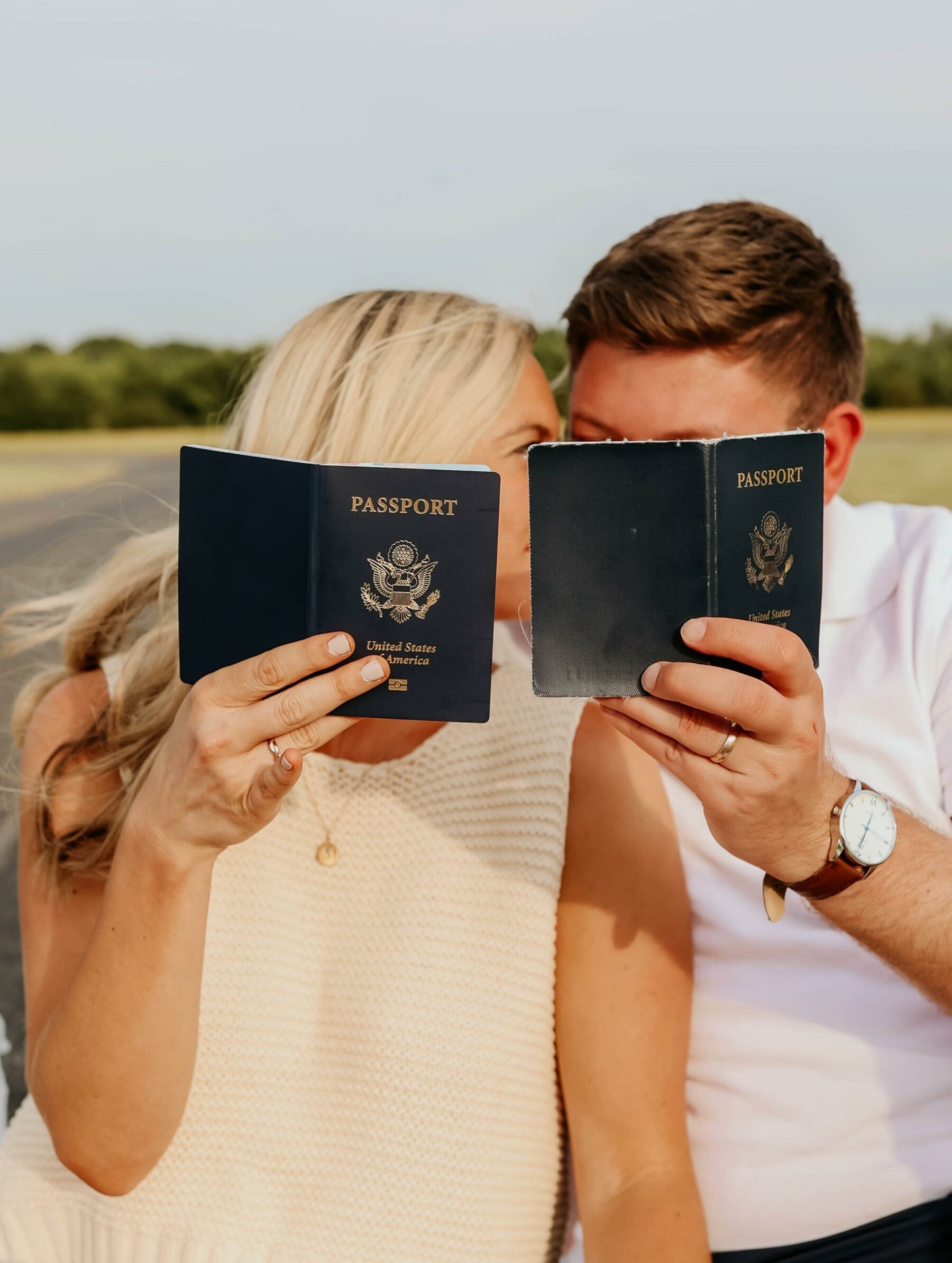
Hi friends! Welcome to The Jet Lag Journey.
This is an online destination that tackles difficult travel questions in order to make worldwide travel practical and accessible. Happy exploring!
Posts to Start with

50 Europe Travel Tips: A First-Timer’s Guide to Traveling to Europe
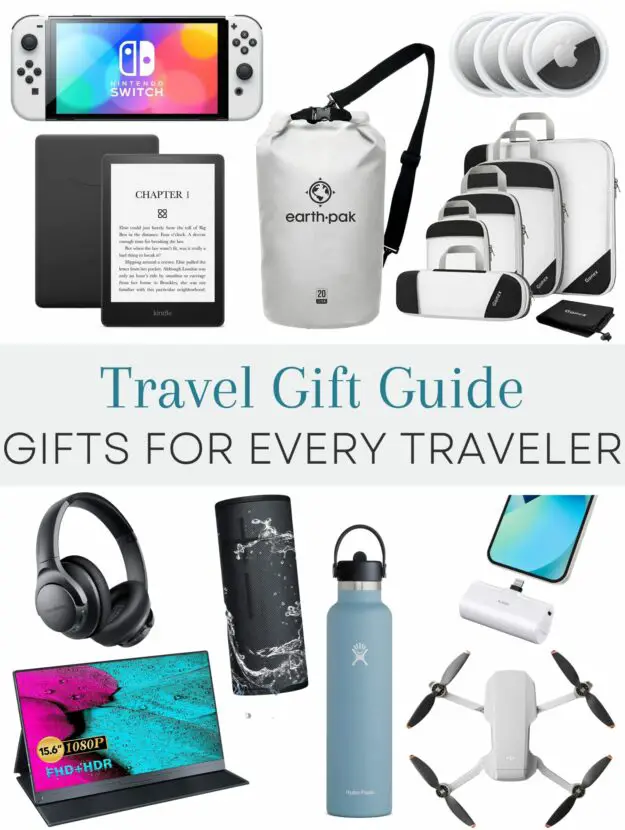
Travel Gift Guide: 25+ Best Gifts for all Travelers in 2023
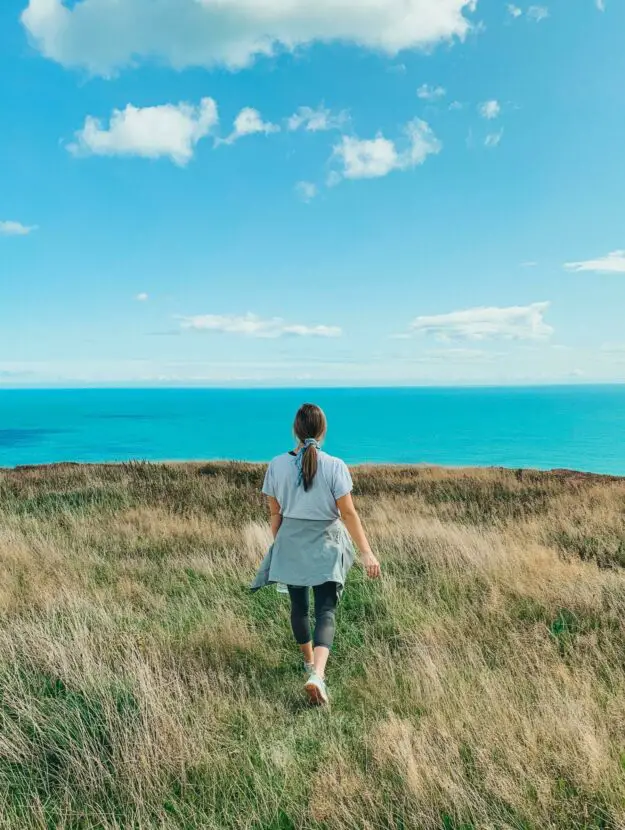
How to Quit your Job and Travel
More posts you might like.
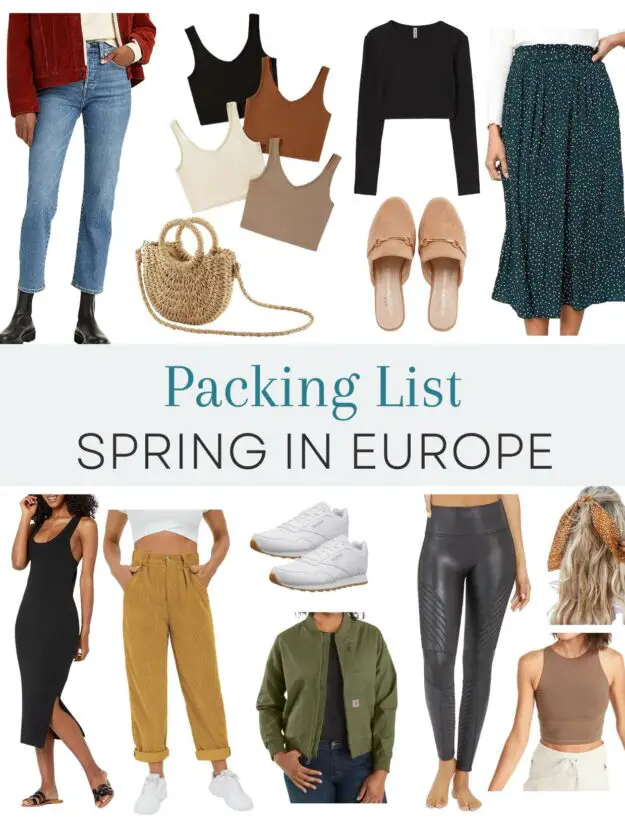
What to Pack for Spring in Europe 2024: A Complete Packing List and Outfit Inspiration

How Much Does 3 Months in Europe Cost: A Complete Budget Breakdown
Leave a comment.
Save my name, email, and website in this browser for the next time I comment.
What are you searching for?


The Ultimate Packing List for Europe: Summer Edition
Beautiful beaches, fashionable cities, epic national parks, blooming flowers: there’s a lot to love about summer in Europe, but when it comes to planning a packing list for Europe, summer weather can make things a little difficult!
The good news? No bulky coats required.
The bad news? Scorching weather, multiple countries with different standards of dress, and an itinerary that likely combines outdoor highlights (beaches, boat rides, chasing waterfalls) with city lights (cooling off in museums, eating gelato on the streets every afternoon) can mean that a summer packing list for Europe can be a bit tricky to put together.
After years spent traveling through Europe in all seasons, we’ve become quite accustomed to packing our belongings up over and over again.
We’ve pulled together years’ worth of travel knowledge to create this packing list for Europe: summer travel is bound to be even more relaxing with these tips!
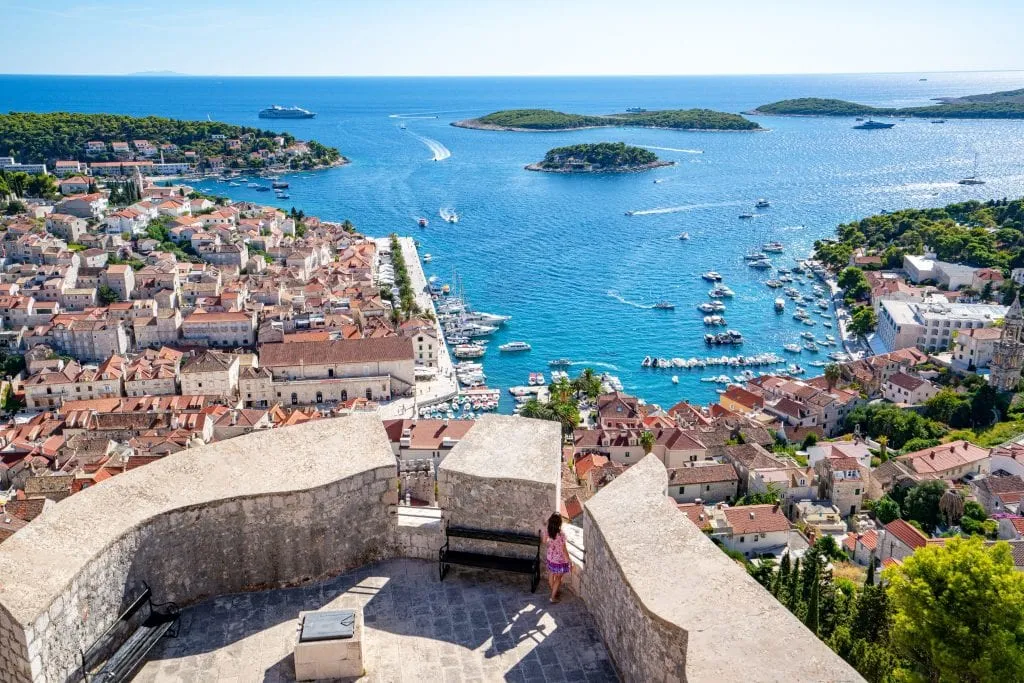
Some links in this post may be affiliate links. If you make a purchase through one of these links, we may earn a small commission at no extra cost to you. Please see our disclosure policy for more detail.
Table of Contents
The Absolute Essentials for Visiting Europe in Summer
Travel gear you should definitely pack for summer in europe, packing list for europe: summer wardrobe for women, packing list for europe: summer wardrobe for men, other travel gear for your packing list for europe in summer.
Passport — If you’re traveling internationally, your passport is an absolute must: there’s no point in packing for Europe in summer without it!
Travel Insurance — We don’t ever suggest traveling without travel insurance–anything can happen, and an epic summer trip to Europe is definitely a case of better safe than sorry. We use and recommend Safety Wing for trips to Europe.

Visa (If Needed) — Though 26 countries in Europe are part of the Schengen Zone that allows many nationalities (including US citizens, Canadians, and Australians) to enter and travel freely between their countries for 90 days for tourism, that still leaves around half of Europe’s countries that are not part of this agreement.
Regardless of where you are from, always double-check entrance requirements before showing up at the airport to fly to any European country (or any country at all that isn’t your own, for that matter).
Money — We recommend bringing two credit cards (one to use, and one to keep as a backup), and two debit cards. Ideally, bring cards with no foreign transaction fees. We’ve never felt it necessary to obtain currency before arriving (we just withdraw from an ATM when we get there), but you can purchase most currencies in your home country if it makes you feel more comfortable.
Keep in mind that not all countries in Europe are on the Euro, so be sure to double-check what currency you’ll need based on your itinerary!
International Driving Permit — If you are visiting Europe from outside the EU and plan to rent a car, you may need an International Driving Permit to do so! Italy in particular is well-known for enforcing this requirement. Be sure to check the rental requirements in any country that you plan to drive in before you arrive!

Camera — We recently upgraded to our Sony a7R III and absolutely adore it, but whatever camera you’re comfortable with works–just make sure you have something with you to preserve your memories!
Comfortable Day Bag — We currently use Pacsafe’s sleek anti-theft backpack and love it, but if you don’t want to shell out the cash for this trip, that’s totally understandable. Just aim for something comfortable to wear, not flashy, and medium-sized–we used a Northface Jester backpack for years and loved it as well.
Sunglasses — You’ll be glad you put these on your summer packing list for Europe–though of course, if you forget them (or lose them during your trip like I’ve definitely done more than once), it’s extremely easy to pick up a pair while traveling just about anywhere else in Europe.
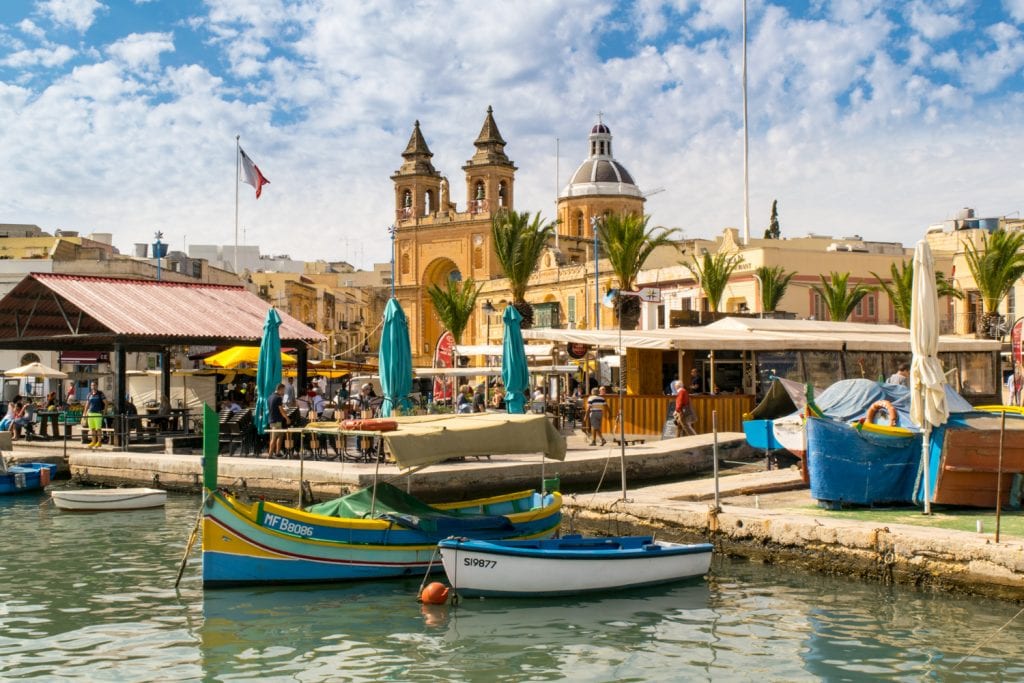
Student ID — If you’re a student, you’ll be entitled to lots of discounts on museums and attractions throughout Europe. Be sure to add it to your packing list for Europe.
Cell Phone — We spent more than a year traveling without working cell phones, just relying on wifi… and while that’s completely fine, we would never go back.
Consider purchasing an international plan for your cell phone (most carriers offer them), or, if you have an unlocked phone, you can just by a local SIM card once you land in Europe.
While you’ll likely want to structure your wardrobe for your packing list for Europe in summer slightly differently based on where exactly you’re going (for example, you’ll want to dress up a bit more on a city tour through Italy than on a sailing trip through Greece), if you’re looking for an all-purpose summer wardrobe that will sustain you through multiple European destinations, these suggestions are for you!
As full-time travelers for nearly 4 years, we are extremely well accustomed to living out of a backpack as we traipse around Europe, and these suggestions reflect my personal favorite things to wear in Europe during the summer.
I love wearing dresses in Europe in the summer! They’re easy to pack, easy to wear, look great just about anywhere you go, and manage to look pulled together while only requiring one piece of clothing.
Dresses like this and this are generally what you’ll find me in when traveling through Europe in the summer. Be sure to bring at least one or two maxi dresses ( I love this one , for example), which fulfill the double purpose of being extremely photogenic and also allowing you to visit religious sites like churches and mosques without issue.
Rompers like this can also be a fun option if you want an all-in-one outfit that isn’t quite a dress, and so can two-piece outfits (I personally love the lemon pattern on this one , it makes me think of the Amalfi Coast!).
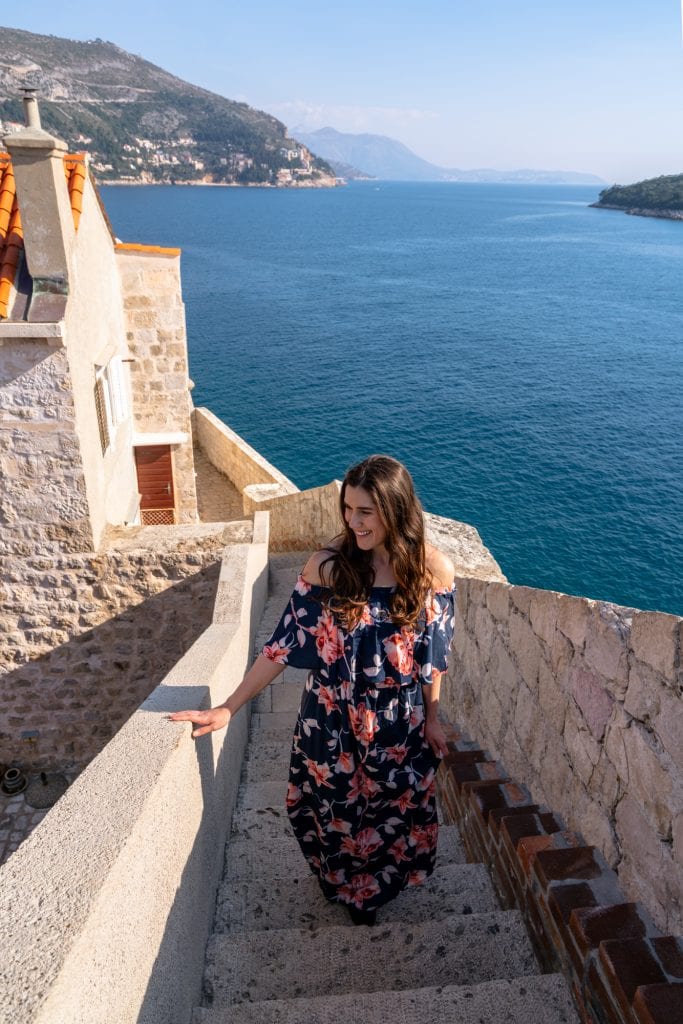
Bright, colorful tops are perfect for beach destinations in Europe–I love choices like this and this , and if crop tops are your style, options like this are a popular choice around the beach.
Ever heard that Europeans don’t wear shorts? In Milan or Paris, fair enough. But in Dubrovnik or Mykonos? Go for it! Beach destinations are the perfect place to break out jean shorts like these from my current favorite denim company.
In the city, skirts like this are a great idea, and light midi skirts also look beautiful.
Bathing Suits
Depending on how many beach destinations you’re planning to visit, I’d pack 2-3 bathing suits for visiting Europe in the summer. I love choices like this and this . If you’re planning on trying out any active water activities like snorkeling or scuba diving, consider packing at least one one-piece suit , too.

The absolute most important rule when determining what shoes to put on your packing list for Europe this summer is making sure that they’re comfortable to walk in! I’ve been wearing these shoes in Europe during the summer lately and love them. Boat shoes are also a great option, and Converse are popular with backpackers and travelers along the tourist trail.
Summer in Europe can be scorching–but the air conditioning blasting inside museums, hotels, trains, and buses, will make you quickly forget it! I recommend putting one light jacket on your summer packing list for Europe for those moments! I normally pack something like this and am very comfortable.
Accessories
Sunglasses and a sunhat are musts for traveling in Europe during the summer! You can either purchase ahead of time or plan on picking them up as souvenirs–both are sold on just about every corner in Europe during the summer travel season!

T-shirts are a staple of the men’s traveling wardrobe in Europe, but opt for brightly colored new ones if you can! Shirts like this that have a bit more detail work as well. If they’re your style, light, casual button-up shirts are also an option.
During the scorching summer, you’ll find men wearing shorts similar to these just about everywhere in Europe–especially the tourists. Forgo them in favor of chinos when visiting religious sites that have a strict dress code and in more formal cities like Paris if you can stand it, but on the coast, your shorts certainly won’t stand out.
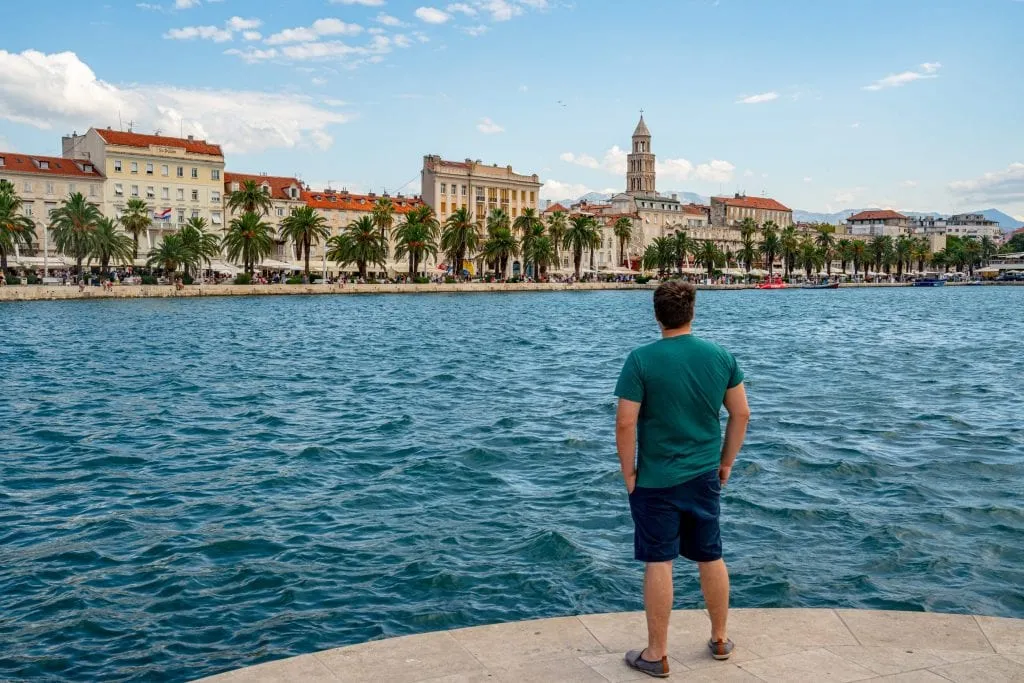
Jeremy tends to opt for light, casual shoes like these during summer in Europe–whatever you pack, just make sure that they’re well broken in and easy to walk in for hours before adding them onto your summer packing list for Europe!
Bathing Suit
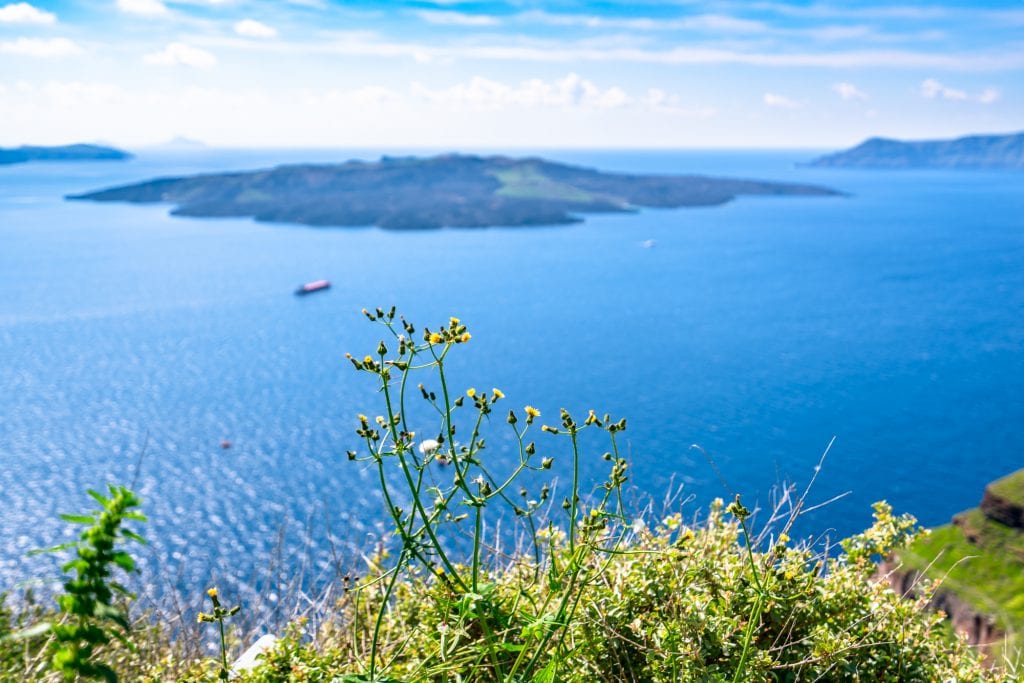
If you’re planning on hitting the beach in Europe this summer, make sure to bring one or two bathing suits along with you. Suits like this work perfectly.
Summer in Europe can be scorching–but the air conditioning blasting inside museums, hotels, trains, and buses, will make you quickly forget it! I recommend putting one light jacket on your summer packing list for Europe for those moments! Jeremy tends to pack this jacket for Europe in the summer (and most other seasons as well) and loves it.
Sunglasses and a hat are musts for traveling in Europe during the summer! You can either purchase ahead of time or plan on picking them up as souvenirs–both are sold on just about every corner in Europe during the summer travel season!
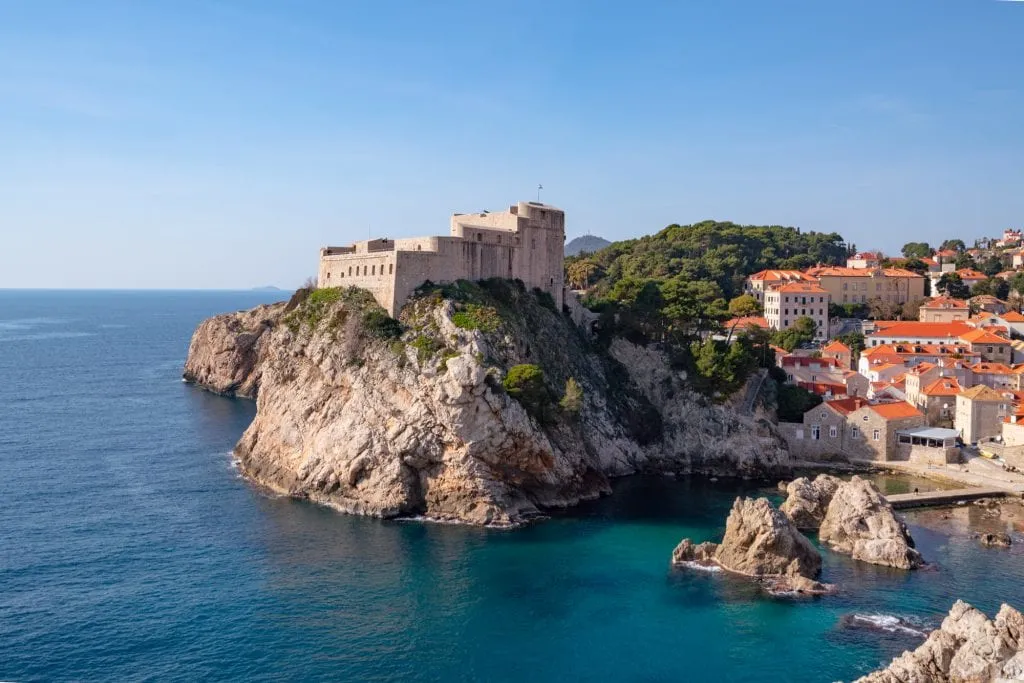
I use them on all boats and the occasional bus, and if things get really bad, take some Non-Drowsy Dramamine as well.
Trust me–you don’t want to miss out on the joys of boating around the Mediterranean due to seasickness!
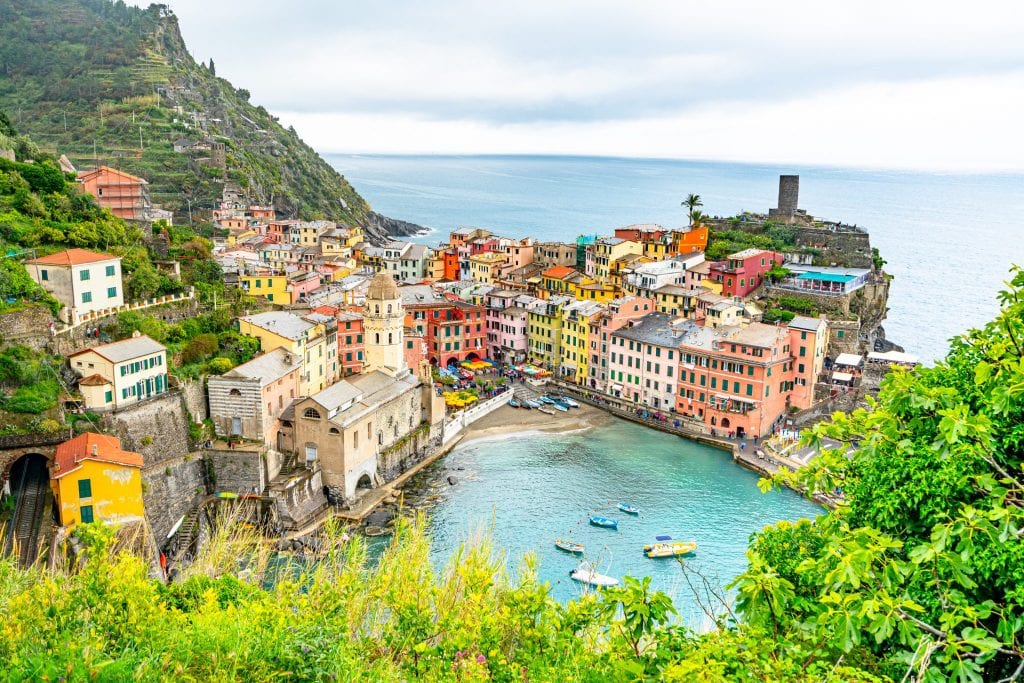
Basic Medication — Some people prefer to buy medication for basic headaches, fevers, and stomach aches as needed, but who wants to deal with language barriers when they’re sick? We’ve never regretted packing our own basic meds.
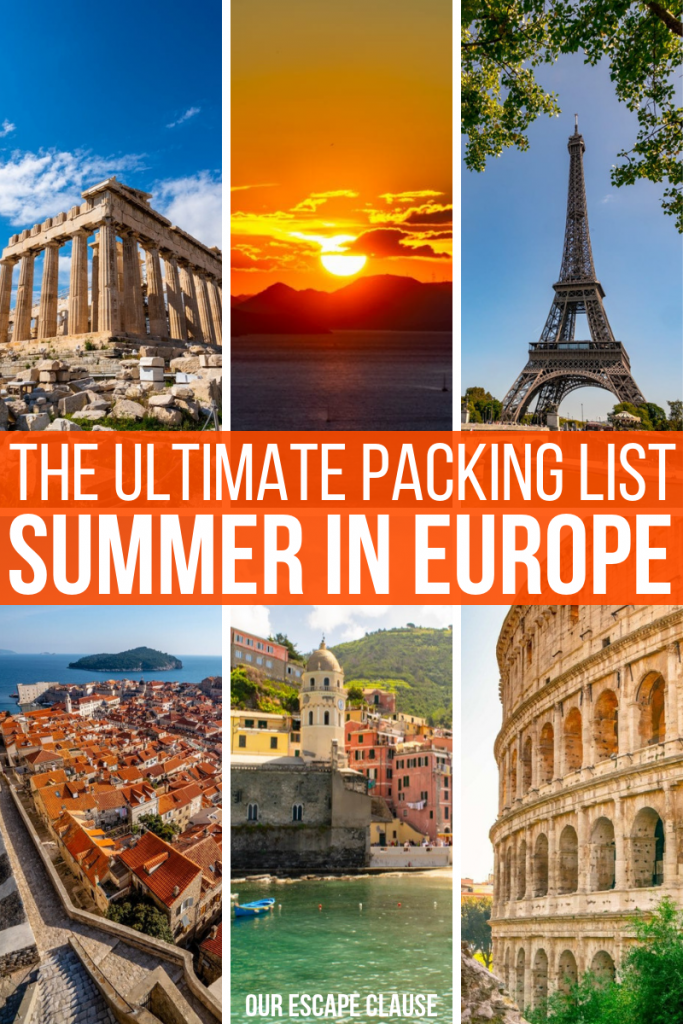
About Kate Storm

In May 2016, I left my suburban life in the USA and became a full-time traveler. Since then, I have visited 50+ countries on 5 continents and lived in Portugal, developing a special love of traveling in Europe (especially Italy) along the way. Today, along with my husband Jeremy and dog Ranger, I’m working toward my eventual goal of splitting my life between Europe and the USA.
2 thoughts on “The Ultimate Packing List for Europe: Summer Edition”
I enjoyed reading your recommendations for traveling to Europe. I’m planning a family trip to Europe for about 7-10 days and I’d like to ask, since you have extensive travel experience across Europe, which would be the best countries/cities to visit as a first time tourists. I would appreciate your help and input. Happy and safe travels.
That’s a very hard question–a bit like “how long is a piece of string?”. Where to go in Europe depends so much on your interests, timeline, budget, where you’re traveling from, etc.
We go over several popular first-time-in-Europe itinerary ideas in this post that might give you an idea what to expect: https://www.ourescapeclause.com/2-week-europe-itinerary-trip/
Leave a Comment Cancel reply
Adventures of Alice

A Complete Packing List for Europe: Summer Essentials
Sharing is caring!
Summer in Europe is a magical time of year that beckons you to roam the historic streets of Rome, savour the delicious pastries of Paris , and bask in the beauty of Barcelona’s beaches. As the temperature rises and the sun shines brighter, summer in Europe is the perfect time to explore. But before you get lost in the magic of it all, let’s talk about the elephant in the room – putting together a packing list for Europe. Strict airline baggage allowances and the ever-changing European weather mean knowing what to pack for summer in Europe can feel like a daunting task.

With so many destinations and activities on offer, it can be a challenge to curate a packing list that balances fashion, function, and comfort. I’ve been at both ends of the spectrum. I’ve stared at the empty insides of my case not knowing what to pack and had to sit on it to zip it up wondering if I really needed everything inside.
I also convinced myself that ‘just in case’ is better than forgetting stuff, right? Well, possibly, but if you’re travelling with carry-on only , then you could end up with a hefty fine for going over the packing limit. So, there’s definitely a middle ground.
But fear not, as it doesn’t have to be complicated. As a seasoned traveller who’s explored many of Europe’s summer hotspots , I’m here to share my top packing tips and tricks to help you pack smart and light for your summer adventure in Europe.
Full Packing List for Europe in Summer
- Travel Insurance
- Boarding Tickets
- Travel Debit Card / Money
- International Driving Permit
- Packing Cubes
- Clear Carry-on Bag for Liquids
- Reusable Water Bottle
- Portable USB Charger
- Charging Cables
- Beach Towel
- Airplane Entertainment
- Travel Adaptor Plug
- Hand Sanitizer
- Light Jacket
- 1-2 x T-Shirts
- 2-3 x Vest Tops
- 2 x Pairs of Shorts
- 2 x Skirts
- 1 x Pair of Denim Jeans
- 1 x Pair of Comfortable Trousers
- 1 x Pair of Leggings
- 2 x Sundresses
- 1 x Maxi Dress
- 2 x Cardigans
- 7-8 x Pairs of Underwear and Socks
- 1-2 x Bikini
- 1 x One-piece
- 1 x Sandals
- 1 x Comfortable Trainers
- Shampoo and Conditioner
- Moisturiser
- Paracetamol
- Antihistamines
- Motion Sickness Tablets
Travel Packing Essentials
The absolute basics.
Passport – The backbone of any adventure be it Europe or the rest of the world, the first thing you need to pack is your passport. I can’t count the number of times I’ve double and triple-checked whether I’ve packed the passports as we’re driving to the airport. Countries in Europe don’t tend to accept passports with less than 3 months’ validity. But it’s best to renew it when it reaches 6 months, just to be safe.

Travel Insurance – You honestly never know what could go wrong when you’re travelling abroad, so I always ensure I have valid travel insurance. I tend to go for an all-world annual policy, but you can also buy insurance for individual trips. I recommend Safety Wing , as they are affordable, easy to use, and specialize in nomadic travel insurance.
Boarding Tickets – I always make sure to check in to my flight at least 24 hours before (once again, you could face fines if you don’t), and screenshot my boarding pass on my phone. This makes navigating the airport so much easier. If you have an iPhone, you can also add your boarding pass to Apple Wallet depending on the airline.
Travel Debit Card / Money – I don’t personally exchange currency before I travel anymore. I much prefer taking a travel debit card with me with all my spending money prepaid onto it. Then, I can withdraw from a cash point for free while I’m out there and I don’t end up with a load of unused foreign currency at the end of my trip. I use Starling Bank every time I travel. They are great, use a much better exchange rate, and have a handy app that automatically converts every transaction I make.
A Few Extras
GHIC Card – Most people don’t think about medical emergencies when they’re deciding what to pack for summer in Europe. But unfortunately, they do happen. If you end up falling ill on your trip, having a valid GHIC card will ensure that you can pay a discounted rate for treatment.
International Driving Permit – If you plan on renting a car abroad, you might need an international driver’s permit with you. This will save any awkward encounters at the car hire desk!
Must-Haves Gear for Summer in Europe
The necessities.
Packing Cubes – Not only can packing cubes keep you well-organized, but they can also effectively compress your clothes, allowing you to pack more efficiently and maximize space in your luggage.
Clear Carry-on Bag for Liquids – I swear by these for airports because I can never fit my toiletries in the plastic bags airports provide. It also means I don’t have to spend time at security taking all my liquids out. I can simply place my liquids in the bag and breeze through with no problem. I use one like this. (Bear in mind that this doesn’t work with all airports in Europe and you may still need to separate things occasionally).
Day Bag – A handy bag for day-to-day use, this ensures that I can take all my essentials with me when I’m out and about. I tend to bring two-day bags with me – a backpack like this for exploring and photography and then a smaller, shoulder bag for the evenings .
Reusable Water Bottle – I swear by my reusable water bottle. Able to keep drinks cool for up to 24 hours (and drinks warm for up to 12 hours – ideal for winter trips ), this is a godsend in warmer temperatures. It’s also a great way to save money and save the environment as you don’t have to keep buying reusable plastics.

Sunglasses – An absolute must for summer in Europe. I forgot my sunglasses once and had to buy a cheap pair that dug into my nose so, safe to say, these are essential . Make sure you pick ones with UVA and UVB protection.
Beach Towel – For chilling on the sand, a beach towel is very useful. I like to use a microfiber one which also helps stop sand from creeping onto it. But you could also get a cotton one .
Hand Sanitizer – Even before COVID-19, this was a staple in my bag. When taking public transport around Europe or even just exploring public spaces, it’s great for keeping clean.
Camera – I take my Fuji-XT3 on every trip I take. It’s essential for taking great travel photography and I also bring at least two lenses, typically my everyday lens and my wide-angle lens . Don’t forget to pack your SD card too.

Portable USB Charger – My phone is my staple for directions when I travel. If it dies, then it can be a bit of a struggle to find directions back to my accommodation. So, I always bring my portable charger in my day bag.
Charging Cables – Essential for plugging into the portable charger. I usually bring my iPhone cable and my camera charger cable.
AirPods – I’ll be honest, I’m a bit of a nervous flier! I have a particular playlist on Spotify that helps me relax for take-offs and landings. As such, my AirPods are a travel essential.
Airplane Entertainment – You can’t go wrong with a good book and you’ll usually find a copy of The Philosopher’s Stone in my carry-on bag! I also tend to bring my iPad for movies or games and recently invested in a travel-sized connect 4 .
Travel Adaptor Plug – Essential for charging devices or using tools like travel straighteners, don’t forget to pack your adaptation plug. I use this one that’s adaptable all over the world.
Packing List for Europe in Summer: Wardrobe Essentials
T-Shirts – I recommend packing 1-2 comfortable t-shirts for summer in Europe. Neutral colours make it easier to mix and match these with different bottoms. White , black , grey, and beige are all good colour choices.
Vest Tops – You’ll want some vest tops to combat the heat at this time of year. Once again, packing neutral colours will make matching these easier. These are also small and easy to pack, so I recommend bringing 2-3 different vest tops.
Light Jacket – You might not think you need to add a jacket to your packing list for Europe. But even in summer, you can experience some chilly evenings, strong wind, or even rainy days. So, this jacket will help you stay prepared.

Cardigan – For a light cover-up, you’ll want to pack a few cardigans. Pick lightweight, neutrally coloured options and they’ll go with most of your outfits. I also suggest using a combination of short and long cardigans for variety. I usually pack two cardigans – a short one , and a long one .
Sunhat – To protect your head and add a touch of style to your outfit, a chic sunhat is a must.
The Bottoms
Shorts – You can’t go wrong with a pair of shorts, especially when visiting Europe in summer. I tend to pack one pair of denim shorts , and one pair of floaty fabric shorts for those really hot days when I want something a little loser.
Skirts – I love skirts when I travel and tend to take my favourite floaty floral one on every trip I go on. I also pack a denim skirt for easy style.

Denim jeans – You honestly never know what the weather is going to do, so, when packing for Europe in summer, bringing at least one pair of jeans is a must.
Comfortable trousers – Cute floaty trousers can make a great summer outfit. I like to pack a pair of these for every trip to Europe .
Leggings – These are mainly my aeroplane bottoms. I have learned not to wear jeans on a plane (it can get super uncomfortable) so I usually wear my leggings on the plane and leave them in my case until I fly back home.
Underwear and socks – I usually pack about 7-8 pairs of each.
The Outfits
Sundresses – A good few sundresses are an absolute must on any European packing list! I always pack one or two cute floaty dresses.

Midi or Maxi Dress – A stylish addition to your case, longer dresses are super comfortable and versatile. You can wear them for a casual day about town or dress them up for a night out.
Romper – For really warm days, my romper comes in very handy. Quick to just throw on and go, it’s essential in my summer case.
The swimwear
Bikini – For the pool or the beach, you can’t go wrong with a bikini . I recommend packing 1-2 bikinis, especially if you love spending time in the water.

One-piece – I always pack my one-piece as well. If I know I’m going to be in the water, but a little more active (perhaps participating in water sports, or playing volleyball on the beach), I prefer something a little more secure.
The Footwear
Sandals – A must on any packing list for Europe, you can’t go wrong with a pair of sandals. I recommend picking 2 pairs – one that is comfortable and sturdy like these , and something a little more fun for evenings out.
Comfortable trainers – You’ll also want to bring a pair of trainers with you. For those days when you’re out exploring (perhaps chasing waterfalls in Croatia or exploring ancient ruins in Greece ), these will be essential.
Packing List for Europe in Summer: Toiletries
For in the shower.
Shampoo and Conditioner – I absolutely love Olaplex. Their shampoo and conditioner do wonders for your hair and their 100ml bottles are small enough to fit in a carry-on case.
Leave-in conditioner – To prevent unbearable frizz in the warm European weather, you’ll want a leave-in conditioning treatment for your hair. Once again, I go for Olaplex, this time number 6 .

Shower Gel – A travel-sized shower gel is a must. Alternatively, you can use the hotel miniatures, if you want to save room in your toiletries bag.
Razor – So you can still get your legs out at the end of your trip!
Facewash – I tend to bring a cleansing wash with me to keep the skin on my face healthy.
For out the shower
Deodorant – A must for warm weather. I love stick deodorants like this and they work really well. Plus, they’re refillable, so good for the environment too.
Makeup – This depends on what you wear. But typical staples include foundation, eyelash curler, mascara, eyeliner, eyebrow pencil, and tweezers.
Perfume – I love my travel perfume. I have several 100ml versions of my favourite perfumes that I always bring with me when I travel. This is my current favourite. If you don’t have travel-sized perfumes, pour your regular perfumes into travel bottles .
Toothpaste and toothbrush – Another essential. If you have an electric toothbrush, don’t forget to charge it before you leave or bring your charger with you.
Sunscreen – Summer can get pretty warm which is why sunscreen is essential on any Europe packing list. Bring one with a good sun protection factor of 30 or above.

After Sun – For keeping your skin silky smooth after prolonged sun exposure, packing a good after sun is a must.
Face moisturizer – I also like to bring a separate moisturizer with me for my face, to keep my skin protected.
Lip balm – Another absolute must for summer weather, I take my chapstick on every trip I go on.
Just in case
Paracetamol – I tend to take a box of painkillers with me when I travel as a precaution. There’s nothing worse than getting a headache while you’re away or even injuring yourself. My fiance once tripped over a curb and bruised his foot – paracetamol was a lifesaver.
Antihistamines – I also take antihistamines with me when I travel just in case I get hay fever or bitten by a bug.
Motion sickness tablets – Once again, these are just a precaution, but, if like me, you tend to get a little motion sick, then these will help you enjoy things like boat trips much more.
Packing for a summer trip to Europe doesn’t have to be a daunting task. With a little planning, some smart choices, and the right mindset, you can pack everything you need for a memorable and stress-free adventure.
By sticking to versatile, lightweight, and breathable clothing, bringing the right accessories, and packing smart, you can create a well-rounded wardrobe that can adapt to a wide range of activities and destinations. Remember to consider the climate and cultural norms, and be mindful of any baggage restrictions or weight limits. And most importantly, don’t forget to leave some space in your luggage for souvenirs.
With this summer packing list for Europe, you can travel light, comfortably, and stylishly, and fully enjoy the endless wonders that Europe has to offer in the summertime. Bon voyage!
My favourite tools for finding cheap travel
- SKYSCANNER – For amazing flight deals.
- BOOKING.COM – For affordable hotels and accommodation.
- SAFETY WING – For affordable, reliable travel insurance.
- DISCOVER CARS – For cheap car hire around the world.
- OMIO – For trains, coaches, and transfers.
- GET YOUR GUIDE – For attractions and tours.
- AIRALO – For a global eSim that keeps you connected.
Disclosure: Please note that some of the links above may be affiliate links, and at no additional cost to you, I earn a small commission if you make a purchase. But, I only recommend products and companies that I use and love.
Alice Smith is a full-time travel blogger and content creator and the founder of Adventures of Alice. Following an unexpected redundancy from her career as a Content Marketing Specialist, she embraced her passion for exploration and turned her hobby of travel blogging into a full-time career.
From her roots near Cambridge, UK, she's ventured to over 30 countries since 2016. With a passion for the outdoors and a knack for finding the extraordinary in the ordinary, Alice is on a mission to show that budget travel can still be luxurious and that every destination, no matter how touristy, holds hidden gems.
Similar Posts

14 Most Beautiful Cities in Spain You Must Visit
Do you love Spanish cities? From Barcelona to Valencia, these are the most beautiful cities in Spain that you simply must visit!

13 Very Best Easter Holiday Destinations in 2024
Whether you’re after a beach break, a city break, or somewhere more exotic, these are the 13 best easter holiday destinations in 2024.

8 Best Things to Do in Cinque Terre
From gorgeous hiking trails to stunning coastal views, and colourful Italian architecture, here are the best things to do in Cinque Terre.

One Day in Cologne, Germany: The Perfect Cologne Itinerary
Cologne is a gorgeous German city. If you fancy spending one day in Cologne, use this itinerary to ensure you have the perfect time.

10 Most Beautiful and Best Hikes in Italy
From the highest peaks of the Dolomites to the colourful Amalfi coastline, these are the 10 best hikes in Italy to tempt you on an adventure.

Driving in Croatia: 8 Tips You Need to Know
If you’re planning a Croatian road trip and want the truth about driving in Croatia, here are the 8 things you need to know.
Leave a Reply Cancel reply
Your email address will not be published. Required fields are marked *
Save my name, email, and website in this browser for the next time I comment.

Our Europe Packing List: Travel Essentials for Europe
- April 24, 2018
Shanna Schultz
Inside this post...
We have been across the pond a few times now, and we have discovered from trial and error that there are some things that we pack that get used and some that just don’t. Here is our go to Europe packing list of all of the t ravel essentials for Europe that get used on just about every trip we take.
This list can be modified by adding or deleting items depending on your destination and the time of year that you are traveling. Having the right stuff (but not too much) can be the secret to an enjoyable European family vacation.
After you finish here, these are some other great posts on the blog about packing and planning travel:
- Top Tips for Train Travel in Europe with Kids
- Travel Off the Beaten Path: 6 Tips for Finding Authentic, Local Food
- Planning for a Trip: Make your “Hit the Ground Running” Plan for a Smooth Arrival

This is a basic list of travel clothing for women , men and children to get you started if you are traveling to Europe in the more temperate months (spring, summer or fall).
Kitchen Kit

Having a few kitchen basics on hand can really help you save money while eating in Europe, especially if you are staying in a hostel or renting an apartment with a kitchen !
- Shopping bags: This is one of the most important travel essentials for Europe. If stores in Europe even provide them, they charge you! Never leave home without your bag! This is my favorite brand of packable shopping bags!
- Basic Travel Spices Kit: Its little things like spices and condiments for recipes that add up when grocery shopping. Bringing some of these (and even little packets of ketchup or other condiments) can save a TON of money!
- TSA Compliant Wine Bottle Opener
- Travel Bottle Opener
- Spare plastic baggies (large and small): These can be used for leftovers, dividing up larger packages of snacks, etc.
- Collapsible plastic water bottles: These can be used for drinking, but could also be frozen if you needed an ice pack to keep food cold in your travel cooler. These are very similar to the set that we travel with .

Shopping at local markets and eating picnic lunches or dinners in Europe’s magnificent parks is a great way to immerse yourself in local culture (AND save some money at the same time!) Here are some items that we have found make picnicking easier:
- Ultra packable picnic blanket: This has many uses. Our picnic blanket has doubled as a rain shield on more than one occasion.
- Collabsible cups: Drinking is the obvious use for these, but they can also be used for containing snacks or for soups or other liquids.
- Sporks: The Light My Fire Sporks are our favorites. You can buy them at Walmart if you don’t want to order online.
- Collapsible cooler: This is SUPER handy to take lunch with or to keep food cool that you purchase at the morning market. Take one of your collapsible water bottles and freeze it for an ice pack.
Our Travel First Aid Kit

Our travel first aid kit grows and shrinks depending on where we are going. If we are traveling somewhere with good pharmacies and medical care, we pare it down to just the basics below. If you are traveling further off the beaten path, consider adding to this basic list.
- Homeopathic sleep tablets: These are natural and effective for promoting sleep. This is a reliable brand that we often use.
- Antibiotic ointment
- Antiseptic Wipes: We like this brand …you don’t want to mess around with infection when traveling.
- Bandaids: We carry these in abundance and in a variety of sizes and shapes. Make sure to have some large ones for big scrapes.
- Blister kit or moleskin and some tape: Essential if someone is wearing new shoes or boots, but always good to have.
- Packets of Biofreeze: This is a LIFESAVER for muscle soreness caused by airplane or train rides or unfamiliar beds.
- Pink Pepto tablets: We often take these before eating in a new place or at the first sign of minor stomach upset.
- Diarrhea medicine: T his is for more serious stomach upset – when you just need to STOP GOING!
- Day/night cold medicine
- Ibuprofen/NSAID of choice
- Eye Wash/Eye Drops: While relatively unlikely, getting something stuck in an eye can be a debilitating condition that needs serious attention. You won’t want to wait until you can go to the pharmacy for relief.
If Traveling with kids, add:

- Kids Dramamine or kids homeopathic motion sickness medication: We have used both with good results. The Homepathic option has less side effects.
- Kids Melatonin: Everybody is happier when the kiddos sleep through the night when adjusting to jetlag. A kids dose melatonin tablet makes our kids sleep in about 30 minutes (…adults can drink wine 😉 )
- Kids Rescue Remedy : This is a great natural product for helping anxious kids or kids that need a little help calming down in exciting or stressful situations.
- Children’s Tylenol (chewable)
- Kids Diarrhea Medicine
Miscellaneous Travel Essentials for Europe

These are some miscellaneous things that we have learned from experience to add to our family packing list . These might not be obvious when putting together your Europe trip packing list. The are generally things that don’t take up a whole lot of room, but can come in VERY handy when you discover that you need them.
- Plastic grocery bags: These don’t take up any space, but they have hundreds of uses. Think wet swimsuits, dirty clothes, etc. Throw some into a spare corner of your bag and I guarantee they will get used.
- Super absorbent towels: Some places don’t offer towels or charge for them. You also never know when you will take a quick trips to the beach. These can be found in the carwash supply section of Target or Walmart.
- A Compass: You have no idea how many times we have been standing in a huge train station trying to figure out which exit to take up or in an unfamiliar city with a map in hand and still no idea which direction we were heading.
- A flashlight: Super handy if the power goes out or if you find yourself on a cave tour. A tiny LED flashlight is just a good common sense thing to have.
- A couple extra ropes/straps/duct tape for securing doors and windows from toddlers while sleeping: Lots of windows in Europe have shutters so that you can leave the window open while sleeping or while raining, but they are not always as secure as I would like. Duct tape also has a ton of other uses 😉
- Travel clothes line/baggies of washing powder: Washing clothes while you travel is a great way to pack lightly and enjoy your travel more. This looks like a really functional one !
- Applicable Language Book (we like Rick Steves!)
- Swimsuits: We usually bring these even if we don’t think we will be swimming. You just never know.
- Hotel confirmations and directions to get from the train station to each hotel
- Passports: Another tip – always keep a copy of your passport at home or in your e-mail box and a copy in your luggage, just in case.
Travel Toys (disregard if not traveling with kids)

We discovered on our trip to Switzerland with our toddlers that we did not need nearly as many toys as we thought (we also bring the kids’ tablets and let them use them on long rides or on the airplane). There were enough new things to see and do in each place that I could have brought half or less of what we had. Lesson learned. Consider bringing a few of these with:
- Toddler card games: Go Fish, matching games, travel bingo, etc.
- Felt board set: A felt board story set is a great, open ended amusement. I really love this set from Etsy (all of this artist’s stuff is super cute!). The pages fold open to make a 20″ play surface.
- Koosh balls: It is nice to have balls that you can toss that won’t roll too far or break something.
- Gel clings for train and airplane windows: You can often find these at stores after holidays and the kids are just FIXATED with them!
- Sticker books
- Brain Quest Packets: These have some great questions to keep the kids’ brains working to pass the time more quickly.
- Story Cards: Our kids LOVED these ! These could keep us busy for hours! We are going to buy another set for our next big trip to add on the set that we already have!
Electronics
Travel essentials for europe for keeping connected and keeping the kids busy on long plane/train rides (or so you can enjoy 10 minutes of quiet to finish dinner before being interrupted. it’s your vacation too, you don’t need to feel guilty)..
- Tablets and headphones for each adult/kid: We bought these headphones for each of the kids and they are holding up really well so far!
- Portable Wifi Device: Being able to access wifi just about where ever we were has been invaluable! This device from Gosim.com has been working really well for us on our last trip.
- Outlet adapters for the country that you are visiting: We have wished that had more of these or a little power strip.
- Cords for charging tablets and camera batteries
- Tablet or laptop computer
- Extra batteries
- Cell phone and charger
What are the things that you can’t live without on your European family vacation? Please share below!
11 essentials to bring on a guided tour of Europe
Don’t leave home without packing these items
You can save this article by registering for free here . Or sign-in if you have an account.
Reviews and recommendations are unbiased and products are independently selected. Postmedia may earn an affiliate commission from purchases made through links on this page.
Article content
When it comes to travelling Europe in the winter, a tour group is a convenient, enriching and unforgettable option. Snow-laden hilltops, city centres and landscapes are beautiful, but navigating them solo can be a cold venture.
I recently returned from my first Insight Vacations trip, namely the Christmas Markets of Croatia, Slovenia & Austria tour. It was incredible — read my complete review, here .
Enjoy the latest local, national and international news.
- Exclusive articles by Conrad Black, Barbara Kay, Rex Murphy and others. Plus, special edition NP Platformed and First Reading newsletters and virtual events.
- Unlimited online access to National Post and 15 news sites with one account.
- National Post ePaper, an electronic replica of the print edition to view on any device, share and comment on.
- Daily puzzles including the New York Times Crossword.
- Support local journalism.
Create an account or sign in to continue with your reading experience.
- Access articles from across Canada with one account.
- Share your thoughts and join the conversation in the comments.
- Enjoy additional articles per month.
- Get email updates from your favourite authors.
Don't have an account? Create Account
In general, packing for a tour can be different than packing for a solo trip. If you’re on a tour (like Insight Vacations), you’ll have a heated coach bus for easy transportation (and a place to keep stuff while exploring different areas), porters to carry your luggage and expert advice provided by local guides. No need to lug all your travel belongings on your back as you navigate foreign countries.
First things first, read the itinerary of your trip in detail. Right before you go, cross-reference your destinations with their respective weather forecasts. This is paramount for a winter trip.
There are a few packing essentials that proved to be extremely valuable on the tour. This is not a comprehensive packing list, but rather a guide to ensure you have the major essentials you may not consider when travelling on a European tour. Pack your luggage (perhaps in one of these suitcases , if you’re on the hunt for something new) as you would and consider the following.
Essentials to pack
1. Power bank
Your tour may include a lot of coach travel. The bus on our Insight Vacations tour had a place to charge electronics, but a cell phone battery can only go so far. I opted for an international data plan, so I used my phone as a GPS, search engine, camera, wallet, flashlight, communication device and so much more. I kept a close eye on my phone’s battery life because it would be difficult to get around if my phone lost power. I failed to bring a power bank and would bring one next time.
Product reviews, deals, roundups and interviews to help you make better buying decisions.
- There was an error, please provide a valid email address.
By signing up you consent to receive the above newsletter from Postmedia Network Inc.
A welcome email is on its way. If you don't see it, please check your junk folder.
The next issue of Shopping Essentials will soon be in your inbox.
We encountered an issue signing you up. Please try again
2. Plug adapter
This was an oversight. My trip was booked so last second that I didn’t go through my mental checklist of European travel. I ended up buying an overpriced converter when I landed in Germany, I’d suggest packing a few before you go.
This is turning into a list of things I forgot to bring. In the U.S. and Canada, I rarely use cash — I barely bring my wallet and rely on Apple Pay. On your trip there will likely be walking tours where you may want to tip — you’ll need cash for this. There are also vendors (namely street food and market stands) that only accept cash.
There is so much food baked into most tours, including the one I chose with Insight Vacations, that you will not go hungry. As mentioned in my review , I ate a big breakfast and a solid dinner on most days of the tour and just had a snack between the two. I like to grab a snack at the various destinations to enjoy local flavours but there were a few times when I was really hungry and stores were closed — like all stores in Slovenia on Sundays. I suggest bringing some protein bars and gum (Canada/the U.S. seems to have better gum than Europe).
5. Medications
Of course, you’re going to bring whatever medications and vitamins you need, but also bring some you could need ( Canadian government recommendations ). There were a few people on my trip who experienced heartburn and other ailments. Medication is not the same in Europe as in Canada and experimenting with new medication while travelling may not be the best experience.
6. Hand sanitizer
Done are the pandemic days when every store has hand sanitizer everywhere. In Europe, you may have to pay to use the bathroom. If you’re looking to quickly clean your hands, a small hand sanitizer could come in handy.
On the tour, a few people opted to wear masks. They weren’t sick, but it was their preference. As the trip progressed, a few people did get sick (a cold) and ended up wearing a mask. Insight had a few disposable masks for the taking, but you may want to bring something more protective and stylish .
8. Dental floss
I’m still finding poppy seeds in my mouth’s crevices. Apparently, Croatia, Slovenia, Slovakia and Austria are the poppy seed capitals of the world. I’m so happy I brought dental floss with me — one way I was prepared without even knowing it.
9. Canadiana
When I travel, I’m loudly and proudly Canadian. I like to sport Canadian brands and wear my patriotism on my sleeve (check out my review of the Nobis jacket I wore through my Insight trip) — and hat .
You’ll wear layers. Layers are an easy way to accommodate fluctuating temperatures and levels of physical activity. I just layered up with t-shirts and sweatshirts but could have gone way more technical — Arc’teryx has a step-by-step layering guide .
11. Comfy shoes or boots
If you’re looking for a comfortable travel shoe, we’ve rounded up our favourites . If you’re travelling to certain chilly areas of Europe in the winter, I suggest wearing boots — shoes are not warm enough. On the first day, I wore a pair of runners on a walking tour of Zagreb, Croatia, and my feet froze. I needed to go back to the hotel to switch to the Sorels and never looked back. I opted for Sorel’s Kinetic Impact Puffy Zip Boot and was happy with my choice.
These boots are so comfortable (without a break-in period — I ordered them a day before the trip), warm (but not sweaty), waterproof, grippy and look great (love their scalloped and platformed sole). These boots are also low-top and aren’t heavy, making them perfect for travel. They’re easy to take on and off and make a perfect slip-on boot that I’ll wear in Toronto winter too — until the snow piles up higher than the boots.
- Insight Vacations review: Make European memories with ease
- Experience the colourful island of Puerto Rico with exhilarating activities
Shopping Essentials is a category written by research-obsessed shopping experts. Explore product reviews, recommendations and launches — plus behind-the-scenes info on your favourite brands and hidden gems — learn more here or sign up for our newsletter .
rmann@ postmedia.com
instagram.com/randimann
Postmedia is committed to maintaining a lively but civil forum for discussion. Please keep comments relevant and respectful. Comments may take up to an hour to appear on the site. You will receive an email if there is a reply to your comment, an update to a thread you follow or if a user you follow comments. Visit our Community Guidelines for more information.
Randall Denley: If teachers can't handle a school cellphone ban, maybe they shouldn't be teachers
'selfless act of heroism': the canadian sniper who used his body as a shield to save a wounded soldier, protesters breach u of t fence, legault calls for police to dismantle mcgill camp, michael higgins: speaker greg fergus is a failure, canadians are eating risky foods to cope with high food prices, study suggests, the best online deals in the canadian retail space right now.
Boll & Branch, Fable and Skylight, to name a few
Luxury Stockholm: World-class stays and gastronomy in the Scandinavian enclave
Top hotel and dining experiences to remember
Advertisement 2 Story continues below This advertisement has not loaded yet, but your article continues below.
Jessi Cruickshank joins forces with Canadian brand Joe Fresh for family friendly fashion collab
Comedian and TV personality creates family-focussed collection just in time for Mother's Day.
Makeover: A new haircut after many years of the same style
My client, Michelle, has had the same hairstyle for many years and was ready for a change.
5 fab Mother's Day gift ideas
From CHANEL soap to a wear-everywhere dress, here are five failsafe gift ideas for Mother's Day.
This website uses cookies to personalize your content (including ads), and allows us to analyze our traffic. Read more about cookies here . By continuing to use our site, you agree to our Terms of Service and Privacy Policy .
You've reached the 20 article limit.
You can manage saved articles in your account.
and save up to 100 articles!
Looks like you've reached your saved article limit!
You can manage your saved articles in your account and clicking the X located at the bottom right of the article.

En Route to Rêverie

What To Pack For A Trip To Europe
August 2, 2023
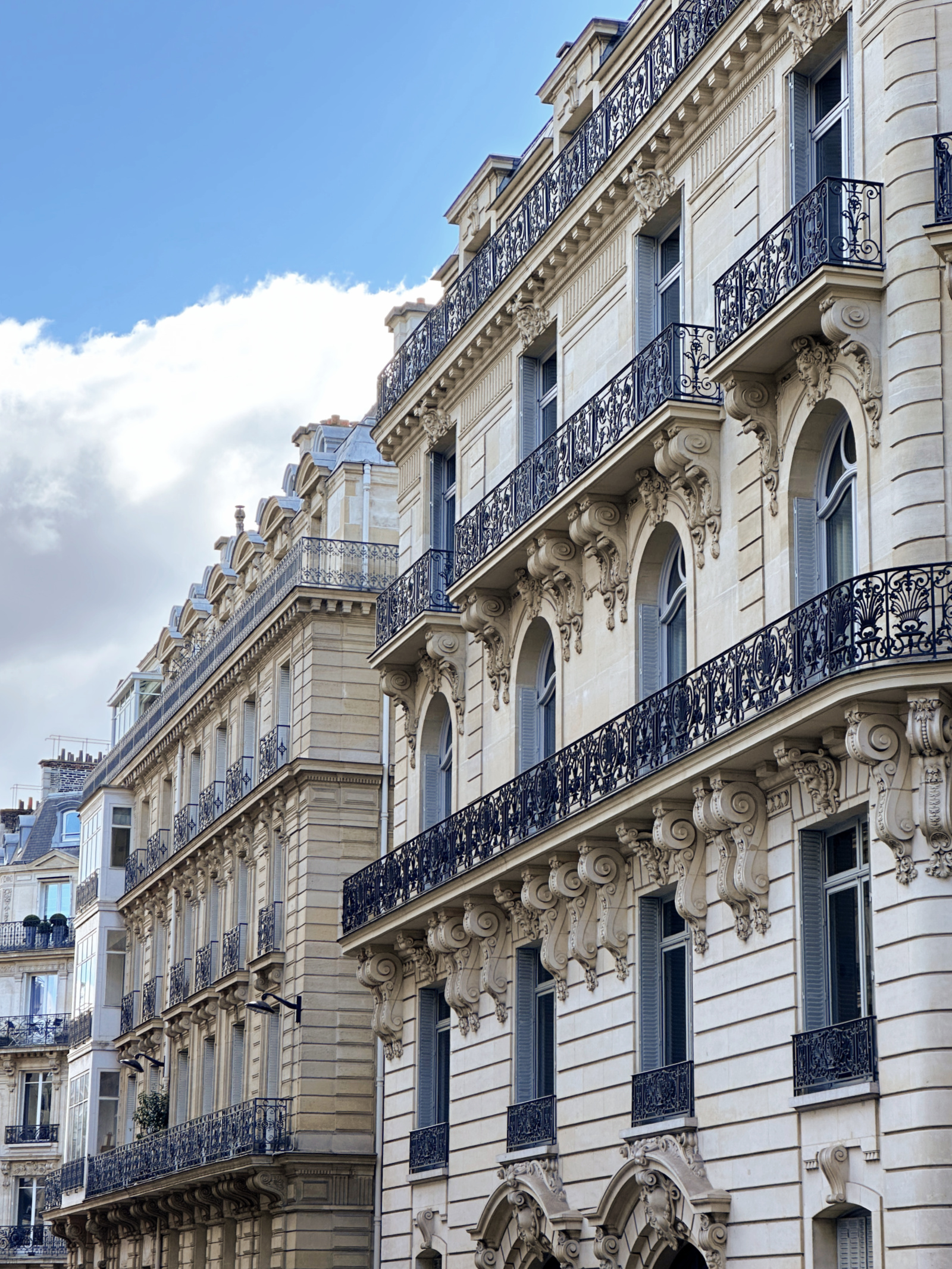
I generally stick to a few self-imposed rules when it comes to packing for Europe and after many years of travel, my formula is down rather pat at this point. If you have European travel on the horizon, my packing tips should be helpful to both inspire and help you plan.
Related: My Travel Essentials , What to Pack for a Flight to Paris
What to Pack for a Trip to Europe
Mix and match outfits.
When deciding what to wear in Europe, one of the keys to packing is to choose items that you can mix and match. I recommend you bring several pairs of pants or shorts (depending on the season) that can be dressed up or dressed down, dresses or skirts for evening, a trench coat, a leather jacket or some other mid-layer depending on the time of year, a neutral blazer or tweed jacket, one pair of shoes for evening and 2-3 pairs of comfortable shoes for daytime.
Makeup and skincare
I like to buy minis of my morning and evening skincare routine products to bring with me. For a toiletry bag, I store them all in Truffle cases (seen in All My Travel Essentials ). Many European countries are incredibly strict with their liquid restrictions (more so than TSA) so keep this in mind if you’re carrying-on for your return flight.
If you’re spending time in a city, you’ll likely encounter noisy evenings so I always travel in Europe with a pair of earplugs .
But of course! Remember you’ll need to bring this with you to fly but also to do any luxury shopping (for VAT refunds if the country you’re visiting allows) and to check into your hotel.
Vaccination Card
Many European countries have lifted their restrictions so you likely won’t need this moving forward, but I keep mine in my passport cover just in case.
Carding isn’t really a thing in Europe, but since you won’t want to be out and about with your passport it is good to have your license with you – especially should you need to go to the doctor or hospital.
Travel Insurance
If you’ve purchased travel insurance, be sure you have documentation of your policy.
Credit Cards
Bring along the credit cards you plan to use that don’t have foreign transaction fees. And if you want to get cash out, be sure to have a debit card with you as well. Don’t forget to upgrade your card to a tap-to-pay if you can!
I like to keep photos of all my important documents on my phone in a folder so I can easily access them.
Electronics & Accessories
Remember that Europe is on a different electric system than the US, and even within Europe there are varying systems. The UK and Ireland have a three-pronged outlet, while the rest of Europe has a two-pronged outlet. You’ll need to bring converters , and things like your Dyson Airwrap or steamer or blow dryer won’t work even with a converter. Leave them behind and instead bring dual voltage electronics.
This is the dual voltage curling iron I use when in Europe. This is a great dual voltage travel steamer .
Having a portable charger is a must! This one is my preferred model as it is slim enough to fit in purses without taking up much space. This is a great USB plug to have on hand for your hotel room or Airbnb in the UK, and this one for the rest of Europe.
If you also worry about losing your luggage, buy a few Apple AirTags and pop them into your suitcases so you can track your luggage.
If you want to capture family photos or the likes and don’t have time or the budget for a professional photographer – don’t forget the power of a handy tripod to do so!
If you’re traveling to Europe in the summer, keep in mind that air conditioning is not as widely employed as it is here in the US. So if you run hot, I’d recommend bringing a portable fan to help cool off.
Water Bottle
Many European cities are making a conscious effort to be more green, so I always try to bring a reusable water bottle with me (plus I don’t have to waste money buying water when I’m out and about). Just don’t forget to empty it before you go through airport security!

I always bring this collapsable duffle with me when I go to Europe to fill up with whatever shopping I do. It fits a lot and easily goes over your suitcase handle as well. I’ll bring it back with me along with the tote I bring on the airplane as my personal item.
If your luggage is over weight you will endure an extra cost so it is a good idea to have a back up bag in case you need to put overflow from your suitcase in there.
Good luggage is a must. I swear by Away luggage . I have the Bigger Carry On, the Medium and the Large which is my preferred suitcase for when I spent time in Paris. They fit so much! The link included should score you $20 off of your first purchase if interested!
And don’t forget to add luggage tags to them, too!
Travel Backpack
I’m not a backpack girl myself, but I know some people love them for traveling! I’ve heard great things about Calpak’s travel backpacks.
Crossbody Bag
I know things like money belts used to be considered a “must-have” item for travel to Europe, but nowadays I find a crossbody does the trick. It keeps my personal items close to me and still looks cute. I love the Senreve Aria belt bag that you can wear a few different ways, and if you want to make it more nighttime just add a chain strap !
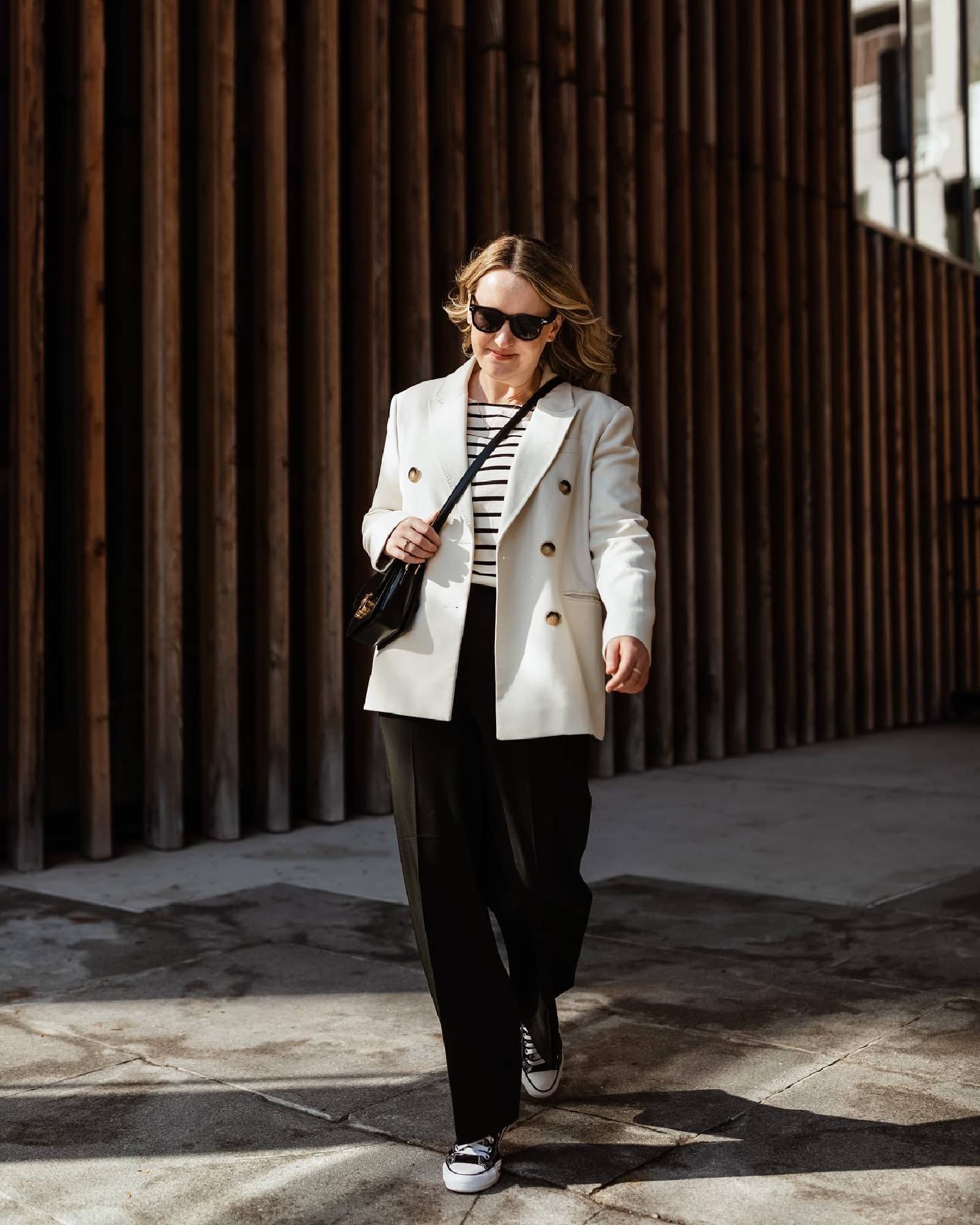
Best Packing Tips For Europe
Consider the weather.
Of course the biggest consideration when packing is the weather. Be sure to check the weather forecast as you are packing! Usually a few weeks out from my trip I begin looking at the weather to see how things have been – has it rained a lot? Has it been colder in the evenings?
Prepare for rain
Regardless of the time of year, I always prepare for rain – that way, I’m not disappointed! Don’t forget to have a good umbrella ( this is the one I bring) in your suitcase and pack a chic trench coat .
Consider getting around
Be sure you check to see if where you’re staying has an elevator. Many places in Europe don’t, so you’ll want to plan (and pack light) should you need to be carting suitcases up narrow stairwells. Also keep in mind the type of public transportation you’ll be using and how accessible it will be with a luggage – this may also affect how you pack.
Stick to a color palette
I always stick to a color palette when I pack for Europe. I want my looks to be stylish, yet comfortable and extremely ready for mix and match wear. I’ll pack a blazer that can go with jeans as easily as it can go over a dress or pair with dress shorts or dress pants.
I’m a neutrals person when it comes to my wardrobe so usually my looks fall in a variety of color palettes such as the neutral colors of Black/Ivory/Camel or Black/Cream/Navy.
Don’t forget the power of accessories
A purposeful accessory can change an entire outfit – a silk scarf can be donned on your bag or around your neck to switch up the look of the sweater you’ve backed. Or a broach could add a bit of glam for evening on the blazer you also wore during the day time.
Be thoughtful when planning what shoes to wear
We’ve all heard horror stories of people being unprepared for the miles and miles of walking that come with visiting Europe, so be sure you’re not bringing new shoes that need breaking in. Prioritize comfort but also give consideration to what shoes won’t have you looking like a tourist. Say it with me: comfortable walking shoes are a must. You will be doing lots of walking – trust me.
The Best Shoes to Wear in Paris
Make a packing list
As you prepare for your trip, begin a packing list for Europe in your Notes app to outline the pieces you’d like to bring. Then reference that list when it comes time to pack so you won’t over pack.
Write down your outfits
I always write down my outfits for both daytime and evening when I go to Paris. This ensures I actually wear what is in my suitcase and don’t forget what’s in there. This also helps me not overpack. I have friends who also try on and take photos of the outfits they’re packing to have handy on their phone. You can also organize packing cubes by outfit to keep things organized. Pro tip: if you’re an iPhone user, use the “touch-to-copy” feature and copy the outline of your outfit photos and paste them into the Notes app.
Europe Packing List
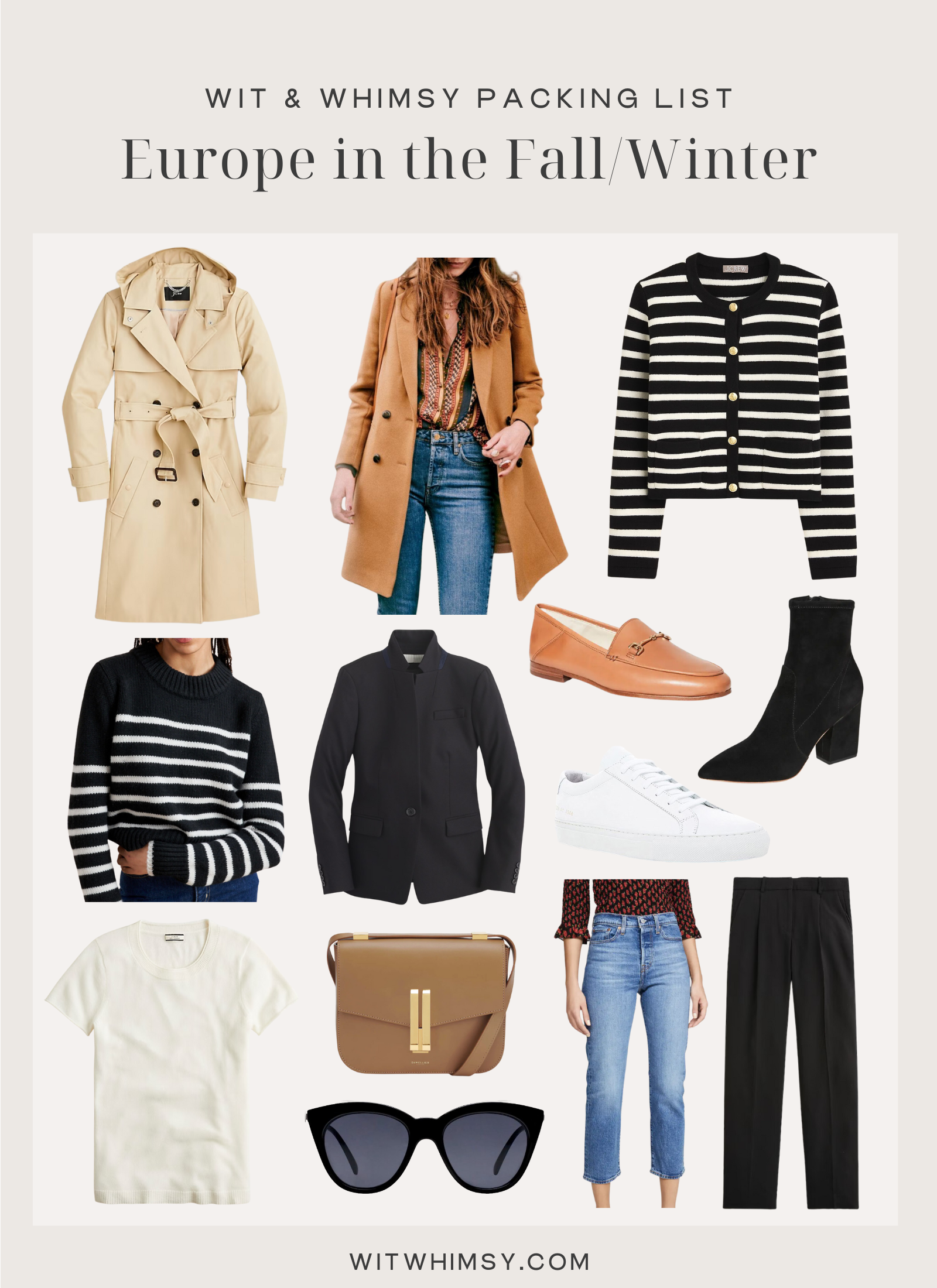
Pin this image for later and shop the pictured styles here .
You May Also Like:
- London Packing List.
- Paris Packing List.
- Scotland Packing List.
This post contains affiliate links. Should you purchase something from an affiliate link, I may earn commission, at no cost to you. Thank you for your support of my work!
Leave a Reply Cancel reply
Your email address will not be published. Required fields are marked *

Elevate your inbox
Join the w&w newsletter community to receive exclusive content..

IMAGES
VIDEO
COMMENTS
What to Pack for Europe - 28 Essentials. 1. Neck Wallet. Europe is notorious for its pickpockets, especially in cities like Paris, Rome, London, Barcelona, Amsterdam, and Dublin. An RFID-blocking neck wallet allows you to easily conceal your cash, credit cards, phone, eyeglasses, and hotel keys while not screaming, "I'm a tourist!".
We also travel with carry-on baggage, therefore, all of our toiletries must be 100ml or less. If you plan on staying in hotels (and even some cool hostels) around Europe, small toiletries will usually be provided. Hanging Toiletry Bag. Compression Packing Cubes. Small containers (100ml) for refills.
Europe Travel Packing: How to Pack for Europe. One of the essentials when traveling in Europe is to pack light. If you're like most people, you probably have at least a couple of European cities or areas on your travel itinerary. Dragging and lifting big, heavy suitcases from airports to hotels onto trains and along sidewalks is a stressful ...
️ Pro Tip: If you are planning to travel during the COVID-19 pandemic, be sure to include all of these items on your Europe travel essentials list. Other Helpful Resources for Europe. ️ How to Plan a Trip to Europe: The ULTIMATE Guide for 2024 ️ The Ultimate Europe Bucket List: 101 Experiences to Have in Europe
Hi, I'm James and I've been teaching people how to travel Europe on a budget since 2010. I created The Savvy Backpacker to be the most comprehensive resource for planning your trip to Europe. Join me to learn more about the best travel backpacks, train travel in Europe, curated packing lists, European city travel guides, cheap data plans ...
We recommend Europ Assistance and vti.travel. Europe Travel Packing List. As a summary, here is our ultimate travel packing list for Europe: Suitcase/travel backpack. 3-4 t-shirts. 2-3 blouses or shirts. 1 dress/elegant shirt. 1 cardigan/sweater. 1 lightweight jacket. 1 pair of dark wash jeans. 1 pair of trousers/capris. 1 pair of shorts. 1-2 ...
1-2 Tank Tops/Base Layers. If your trip is during winter, having a tank top or light base layer will keep you warm without having to result in a bulky coat or jacket. 1 Sweater. Depending on the season or region, a cosy wool sweater or a light cardigan is a great idea when packing for 2 weeks in Europe.
Bring a hat, sunglasses and plenty of high SPF sunscreen. Discover Europe in 14 days on European Whirl. 5. Rain protection. You also need to consider the rain when planning a trip to Europe. Come prepared in any season with a raincoat, small travel umbrella or rain poncho. 6.
You'll thank us. We promise. Welcome to the ultimate Europe packing list for 2024! Whether you're embarking on a romantic getaway, a backpacking adventure, or a family vacation, this comprehensive guide will ensure you have all the essential items for an unforgettable journey across the diverse landscapes and captivating cities of Europe.
What to Pack for a Trip to Europe. 1. The Basics: Passport & Other Documents. Let's start with the basics: make sure you have a passport and that it's valid for at least another six months after the last day of your trip. Six months is a nice general rule that I always stick to, but it does vary per country.
Top Europe Travel Essentials. These are the top travel items that should be on everyone's Europe packing checklist. Don't leave home without them. Have these travel necessities before you arrive at your destination to ensure a seamless start to your trip. Otherwise, you'll be frantically searching for these items in Europe instead of ...
Jacket - Unless you're travelling to Southern Europe in the middle of summer, a travel jacket is a great idea for any European packing list. They're lightweight, don't take up much room and will keep you warm on chilly evenings or cool days. Rain Jacket - No matter when you choose to visit Europe, bring a packable rain jacket just in ...
Pro Europe travel tips are bringing cash and your credit card too. Bring cash that's at least a day's worth of meals and transportation in case the ATMs or your credit card won't work. Then upon arrival, withdraw in local currency using the ATM. Use your credit card to pay for larger expenses like hotels and restaurants.
Don't miss this complete packing list for Europe - with key essentials and seasonal additions to help you plan your trip. ... Travel Essentials for Europe . The ultimate packing list for Europe would not be complete without including all the absolute essentials. Without these items, you really aren't getting far on your trip.
This list of 15 Europe travel essentials will ease your mind and set you up for success on your upcoming travels! Use this as a checklist to make sure you have all of your Europe travel essentials. 1. Universal adapter. A universal travel adapter is an absolute essential when traveling to Europe.
31. Travel Toiletries Bottles. Travel bottles are another one of those no-brainer travel essentials that make travel easier by limiting the need to haul around full-sized products. Getting ones sized to TSA/EU airline specs (3.4 oz or 100ml) also means you can safely bring essential toiletries on your flight.
The Essential Documents To Pack. What to Wear in Europe - Western Rise Men's Travel Clothing. Passport — This is obvious, but you won't make it far without a passport. Credit Cards — We use several travel credit cards offering purchase protection, rewards, and no foreign transaction fees.
Visa (If Needed) — Though 26 countries in Europe are part of the Schengen Zone that allows many nationalities (including US citizens, Canadians, and Australians) to enter and travel freely between their countries for 90 days for tourism, that still leaves around half of Europe's countries that are not part of this agreement. Regardless of where you are from, always double-check entrance ...
Travel Adaptor Plug - Essential for charging devices or using tools like travel straighteners, don't forget to pack your adaptation plug. I use this one that's adaptable all over the world. Packing List for Europe in Summer: Wardrobe Essentials The Tops. T-Shirts - I recommend packing 1-2 comfortable t-shirts for summer in Europe ...
Here is our go to Europe packing list of all of the t ravel essentials for Europe that get used on just about every trip we take. This list can be modified by adding or deleting items depending on your destination and the time of year that you are traveling. Having the right stuff (but not too much) can be the secret to an enjoyable European ...
The ideal bag for a trip to Europe is the 24L volume Nordace Comino Travelpack. It is spacious enough to hold all your essentials, including clothes and accessories, fits in the overhead bin or under the seat, and provides superior comfort thanks to its ergonomic support system with padded shoulder straps and a stabilizing sternum strap.
Europe Winter Travel Essentials. You'll need to bring a few things with you on your Europe winter trip! Oh, and don't forget to prepare for the long haul flight (when we flew back from Prague last year, it took a grueling 19 hours).
Essentials to pack. 1. Power bank. Your tour may include a lot of coach travel. The bus on our Insight Vacations tour had a place to charge electronics, but a cell phone battery can only go so far ...
Mix and Match Outfits. When deciding what to wear in Europe, one of the keys to packing is to choose items that you can mix and match. I recommend you bring several pairs of pants or shorts (depending on the season) that can be dressed up or dressed down, dresses or skirts for evening, a trench coat, a leather jacket or some other mid-layer ...